ZyXEL Communications WAP5605 5-GHz Wireless N Media Streaming Box User Manual V 2 Part 1
ZyXEL Communications Corporation 5-GHz Wireless N Media Streaming Box V 2 Part 1
Contents
- 1. User manual V.2 (Part 1)
- 2. User manual V.2 (Part 2)
User manual V.2 (Part 1)

www.zyxel.com
www.zyxel.com
WAP5605
Wireless N Media Streaming Box
Copyright © 2011
ZyXEL Communications Corporation
Firmware Version 1.0
Edition 1, 10/2011
Default Login Details
IP Address AP: 192.168.1.2
Client: 192.168.1.10
Password 1234

About This User's Guide
WAP5605 User’s Guide 3
About This User's Guide
IMPORTANT!
READ CAREFULLY BEFORE USE.
KEEP THIS GUIDE FOR FUTURE REFERENCE.
Intended Audience
This manual is intended for people who want to configure the WAP5605 using the Web Configurator.
Related Documentation
•Quick Start Guide
The Quick Start Guide is designed to help you get up and running right away. It contains
information on setting up your network and configuring for Internet access.
•Support Disc
Refer to the included CD for support documents.

Document Conventions
WAP5605 User’s Guide
4
Document Conventions
Warnings and Notes
These are how warnings and notes are shown in this User’s Guide.
Warnings tell you about things that could harm you or your device.
Note: Notes tell you other important information (for example, other things you may
need to configure or helpful tips) or recommendations.
Syntax Conventions
• The WAP5605 may be referred to as the “WAP5605”, the “device”, the “product” or the “system”
in this User’s Guide.
• Product labels, screen names, field labels and field choices are all in bold font.
• A key stroke is denoted by square brackets and uppercase text, for example, [ENTER] means the
“enter” or “return” key on your keyboard.
• “Enter” means for you to type one or more characters and then press the [ENTER] key. “Select”
or “choose” means for you to use one of the predefined choices.
• A right angle bracket ( > ) within a screen name denotes a mouse click. For example,
Maintenance > Log > Log Setting means you first click Maintenance in the navigation panel,
then the Log sub menu and finally the Log Setting tab to get to that screen.
• Units of measurement may denote the “metric” value or the “scientific” value. For example, “k”
for kilo may denote “1000” or “1024”, “M” for mega may denote “1000000” or “1048576” and so
on.
• “e.g.,” is a shorthand for “for instance”, and “i.e.,” means “that is” or “in other words”.
Icons Used in Figures
Figures in this User’s Guide may use the following generic icons. The WAP5605 icon is not an exact
representation of your device.
Graphics in this book may differ slightly from the product due to differences in operating systems,
operating system versions, or if you installed updated firmware/software for your device. Every
effort has been made to ensure that the information in this manual is accurate.
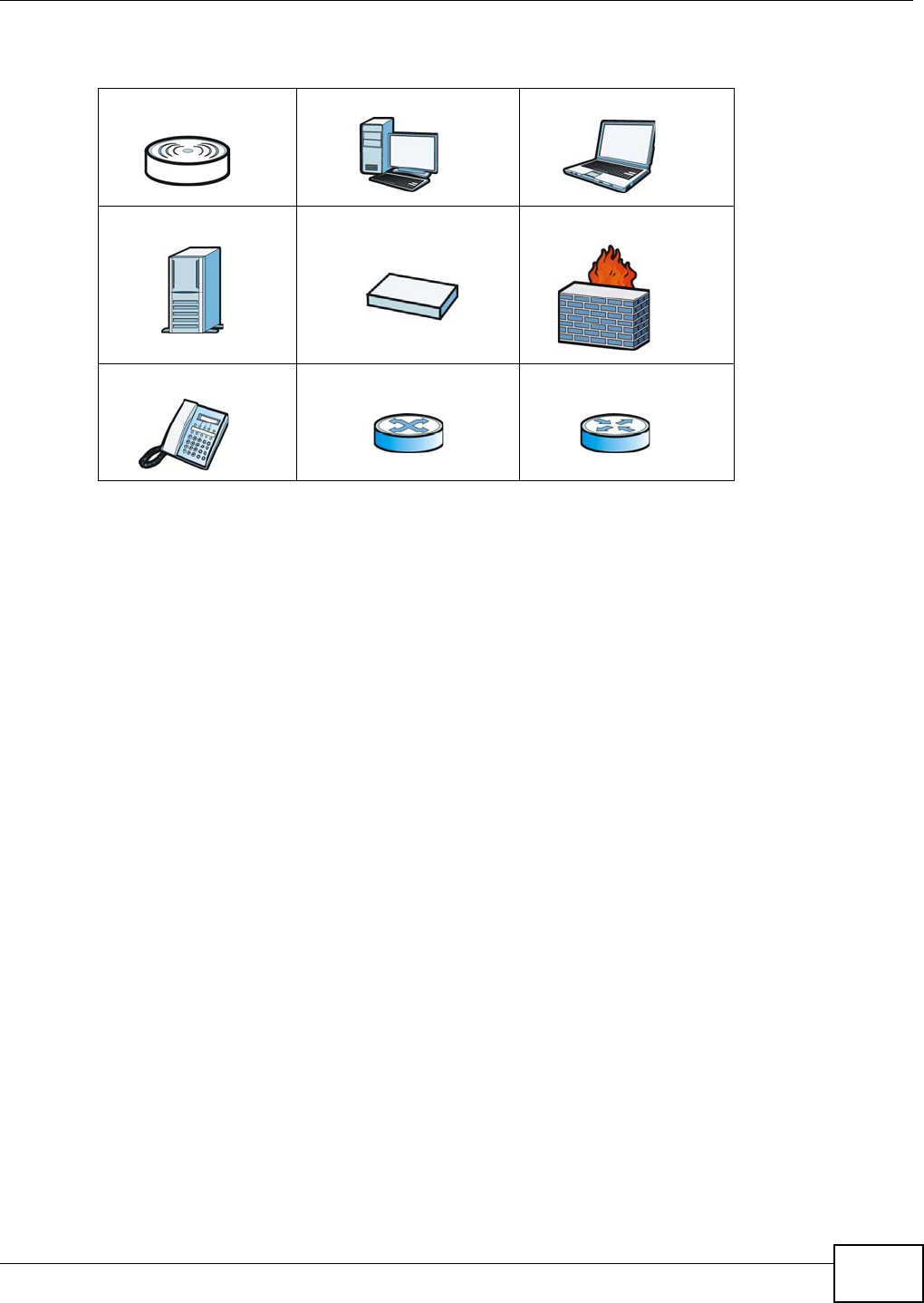
Document Conventions
WAP5605 User’s Guide 5
WAP5605 Computer Notebook computer
Server Modem Firewall
Telephone Switch Router

Safety Warnings
WAP5605 User’s Guide
6
Safety Warnings
• Do NOT use this product near water, for example, in a wet basement or near a swimming pool.
• Do NOT expose your device to dampness, dust or corrosive liquids.
• Do NOT store things on the device.
• Do NOT install, use, or service this device during a thunderstorm. There is a remote risk of electric shock
from lightning.
• Connect ONLY suitable accessories to the device.
• Do NOT open the device or unit. Opening or removing covers can expose you to dangerous high voltage
points or other risks. ONLY qualified service personnel should service or disassemble this device. Please
contact your vendor for further information.
• Make sure to connect the cables to the correct ports.
• Place connecting cables carefully so that no one will step on them or stumble over them.
• Always disconnect all cables from this device before servicing or disassembling.
• Use ONLY an appropriate power adaptor or cord for your device.
• Connect the power adaptor or cord to the right supply voltage (for example, 110V AC in North America or
230V AC in Europe).
• Do NOT allow anything to rest on the power adaptor or cord and do NOT place the product where anyone can
walk on the power adaptor or cord.
• Do NOT use the device if the power adaptor or cord is damaged as it might cause electrocution.
• If the power adaptor or cord is damaged, remove it from the power outlet.
• Do NOT attempt to repair the power adaptor or cord. Contact your local vendor to order a new one.
• Do not use the device outside, and make sure all the connections are indoors. There is a remote risk of
electric shock from lightning.
• Do NOT obstruct the device ventilation slots, as insufficient airflow may harm your device.
• Antenna Warning! This device meets ETSI and FCC certification requirements when using the included
antenna(s). Only use the included antenna(s).
• If you wall mount your device, make sure that no electrical lines, gas or water pipes will be damaged.
Your product is marked with this symbol, which is known as the WEEE mark. WEEE stands for Waste
Electronics and Electrical Equipment. It means that used electrical and electronic products should not be
mixed with general waste. Used electrical and electronic equipment should be treated separately.

Contents Overview
WAP5605 User’s Guide 7
Contents Overview
User’s Guide ...........................................................................................................................13
Getting to Know Your WAP5605 ................................................................................................15
WAP5605 Modes .......................................................................................................................21
Easy Mode .................................................................................................................................23
Access Point Mode ....................................................................................................................31
Client Mode ................................................................................................................................37
The Web Configurator ................................................................................................................49
Tutorials .....................................................................................................................................55
Technical Reference ..............................................................................................................69
Monitor .......................................................................................................................................71
Wireless LAN .............................................................................................................................75
LAN ............................................................................................................................................89
Maintenance ...............................................................................................................................93
Troubleshooting .......................................................................................................................101
Product Specifications ..............................................................................................................107

Contents Overview
WAP5605 User’s Guide
8

Table of Contents
WAP5605 User’s Guide 9
Table of Contents
About This User's Guide..........................................................................................................3
Document Conventions ...........................................................................................................4
Safety Warnings........................................................................................................................6
Contents Overview ..................................................................................................................7
Table of Contents .....................................................................................................................9
Part I: User’s Guide ................................................................................13
Chapter 1
Getting to Know Your WAP5605............................................................................................15
1.1 Overview ............................................................................................................................15
1.2 Applications .........................................................................................................................15
1.3 Ways to Manage the WAP5605 ...........................................................................................16
1.4 Good Habits for Managing the WAP5605 ............................................................................16
1.5 Resetting the WAP5605 .......................................................................................................17
1.5.1 Procedure to Use the Reset Button ............................................................................17
1.6 The WPS Button ..................................................................................................................17
1.7 LEDs ....................................................................................................................................18
Chapter 2
WAP5605 Modes .....................................................................................................................21
2.1 Overview ..............................................................................................................................21
2.1.1 Web Configurator Modes ............................................................................................21
2.1.2 Device Operating Modes ............................................................................................21
Chapter 3
Easy Mode...............................................................................................................................23
3.1 Overview ..............................................................................................................................23
3.2 What You Can Do ................................................................................................................24
3.3 What You Need to Know ......................................................................................................24
3.4 Navigation Panel ..................................................................................................................25
3.5 Network Map ........................................................................................................................25
3.6 Control Panel .......................................................................................................................26
3.6.1 Wireless Security ........................................................................................................27
3.6.2 WPS ...........................................................................................................................29

Table of Contents
WAP5605 User’s Guide
10
3.7 Status Screen in Easy Mode ................................................................................................30
Chapter 4
Access Point Mode................................................................................................................. 31
4.1 Overview ..............................................................................................................................31
4.2 What You Can Do ................................................................................................................31
4.3 What You Need to Know ......................................................................................................32
4.3.1 Setting your WAP5605 to AP Mode ............................................................................32
4.3.2 Configuring your WLAN, LAN and Maintenance Settings ..........................................32
4.4 AP Mode Status Screen .......................................................................................................33
4.4.1 Navigation Panel ........................................................................................................35
Chapter 5
Client Mode .............................................................................................................................37
5.1 Overview ..............................................................................................................................37
5.2 What You Can Do ................................................................................................................37
5.3 What You Need to Know ......................................................................................................37
5.4 Setting your WAP5605 to Client Mode .................................................................................38
5.5 Client Mode Status Screen ...................................................................................................39
5.6 Wireless LAN Profile Screen ................................................................................................41
5.6.1 Adding a New WLAN Profile .......................................................................................42
5.7 Site Survey Screen ..............................................................................................................46
5.8 WPS Screen .........................................................................................................................47
5.9 LED Link Quality Screen ......................................................................................................48
Chapter 6
The Web Configurator............................................................................................................49
6.1 Overview ..............................................................................................................................49
6.2 Accessing the Web Configurator .........................................................................................49
6.2.1 Login Screen ..............................................................................................................50
6.2.2 Password Screen .......................................................................................................51
6.2.3 Home Screen ..............................................................................................................51
Chapter 7
Tutorials................................................................................................................................... 55
7.1 Overview ..............................................................................................................................55
7.2 Connecting to the Internet from an Access Point .................................................................55
7.3 Configuring Wireless Security Using WPS ...........................................................................55
7.3.1 Push Button Configuration (PBC) ...............................................................................56
7.3.2 PIN Configuration .......................................................................................................57
7.4 Enabling and Configuring Wireless Security (No WPS) .......................................................59
7.4.1 Configuring Your Wireless Client ................................................................................61
7.5 Using Multiple SSIDs on the WAP5605 ...............................................................................61

Table of Contents
WAP5605 User’s Guide 11
7.5.1 Configuring Security Settings of Multiple SSIDs .........................................................62
7.6 Connecting the WAP5605 (in Client Mode) to an AP ...........................................................64
7.6.1 Connecting to a Wireless Network Using Site Survey ................................................65
7.6.2 Connecting to a Wireless Network Using a Profile .....................................................66
7.6.3 Deploying the WAP5605 in your Network ...................................................................67
Part II: Technical Reference...................................................................69
Chapter 8
Monitor.....................................................................................................................................71
8.1 Overview ..............................................................................................................................71
8.2 What You Can Do ................................................................................................................71
8.3 View Log ..............................................................................................................................71
8.4 Log Settings ........................................................................................................................72
8.5 Packet Statistics .................................................................................................................73
8.6 WLAN Station Status ...........................................................................................................74
Chapter 9
Wireless LAN...........................................................................................................................75
9.1 Overview ..............................................................................................................................75
9.2 What You Can Do ................................................................................................................75
9.3 What You Should Know .......................................................................................................76
9.3.1 Wireless Security Overview ........................................................................................76
9.4 General Wireless LAN Screen ......................................................................................78
9.5 Wireless Security Screen ....................................................................................................79
9.5.1 No Security .................................................................................................................79
9.5.2 WEP Encryption .........................................................................................................80
9.5.3 WPA-PSK/WPA2-PSK ................................................................................................81
9.6 MAC Filter ...........................................................................................................................82
9.7 Wireless LAN Advanced Screen .........................................................................................83
9.8 Quality of Service (QoS) Screen .........................................................................................84
9.9 WPS Screen ........................................................................................................................85
9.10 WPS Station Screen ..........................................................................................................86
9.11 Scheduling Screen ............................................................................................................87
Chapter 10
LAN ..........................................................................................................................................89
10.1 Overview ............................................................................................................................89
10.2 What You Can Do ..............................................................................................................89
10.3 What You Need To Know ...................................................................................................90
10.3.1 LAN TCP/IP ..............................................................................................................90

Table of Contents
WAP5605 User’s Guide
12
10.3.2 IP Alias .....................................................................................................................90
10.4 LAN IP Screen ..................................................................................................................91
10.5 IP Alias Screen ..................................................................................................................92
Chapter 11
Maintenance............................................................................................................................93
11.1 Overview ............................................................................................................................93
11.2 What You Can Do ...............................................................................................................93
11.3 General Screen ...............................................................................................................93
11.4 Password Screen ..............................................................................................................94
11.5 Time Setting Screen ..........................................................................................................95
11.6 Firmware Upgrade Screen ................................................................................................96
11.7 Configuration Backup/Restore Screen ..............................................................................98
11.8 Reset/Restart Screen ........................................................................................................99
Chapter 12
Troubleshooting.................................................................................................................... 101
12.1 Power, Hardware Connections, and LEDs .......................................................................101
12.2 WAP5605 Access and Login ............................................................................................102
12.3 Internet Access ................................................................................................................103
12.4 Resetting the WAP5605 to Its Factory Defaults ...............................................................104
Chapter 13
Product Specifications.........................................................................................................107
13.1 Desktop Installation ..........................................................................................................109
13.2 Wall-mounting Instructions ...............................................................................................110
Appendix A Pop-up Windows, JavaScripts and Java Permissions...................................... 113
Appendix B IP Addresses and Subnetting...........................................................................125
Appendix C Setting Up Your Computer’s IP Address ..........................................................135
Appendix D Wireless LANs..................................................................................................163
Appendix E Common Services............................................................................................ 177
Appendix F Open Software Announcements.......................................................................181
Appendix G Legal Information .............................................................................................219
Index ......................................................................................................................................227

13
PART I
User’s Guide

14

WAP5605 User’s Guide 15
CHAPTER 1
Getting to Know Your WAP5605
1.1 Overview
This chapter introduces the main features and applications of the WAP5605.
The WAP5605 extends the range of your existing wired network without additional wiring, providing
easy network access to mobile users. You can set up a wireless network with other IEEE 802.11a/n
wireless devices using the 5 GHz frequency bands. The WAP5605 can serve as either an access
point (AP) or a wireless client. At the time of writing, the WAP5605 can only wirelessly
communicate with other WAP5605s.
With data rates of up to 300 Mbps, you can enjoy a breathtaking high-speed connection at home or
in the office. It is an excellent solution for daily activities such as file transfers, music downloading,
video streaming and online gaming.
1.2 Applications
The WAP5605 can be configured to use the following operating modes:
•AP. Use the switch on the side panel to set the WAP5605 to work in AP mode (AP). You can
connect to a broadband modem/router for Internet access and/or connect network devices via
the Ethernet ports of the WAP5605 in AP mode so that they can communicate with each other
and access the Internet. Wireless clients can connect to the WAP5605 in AP mode to access
network resources.
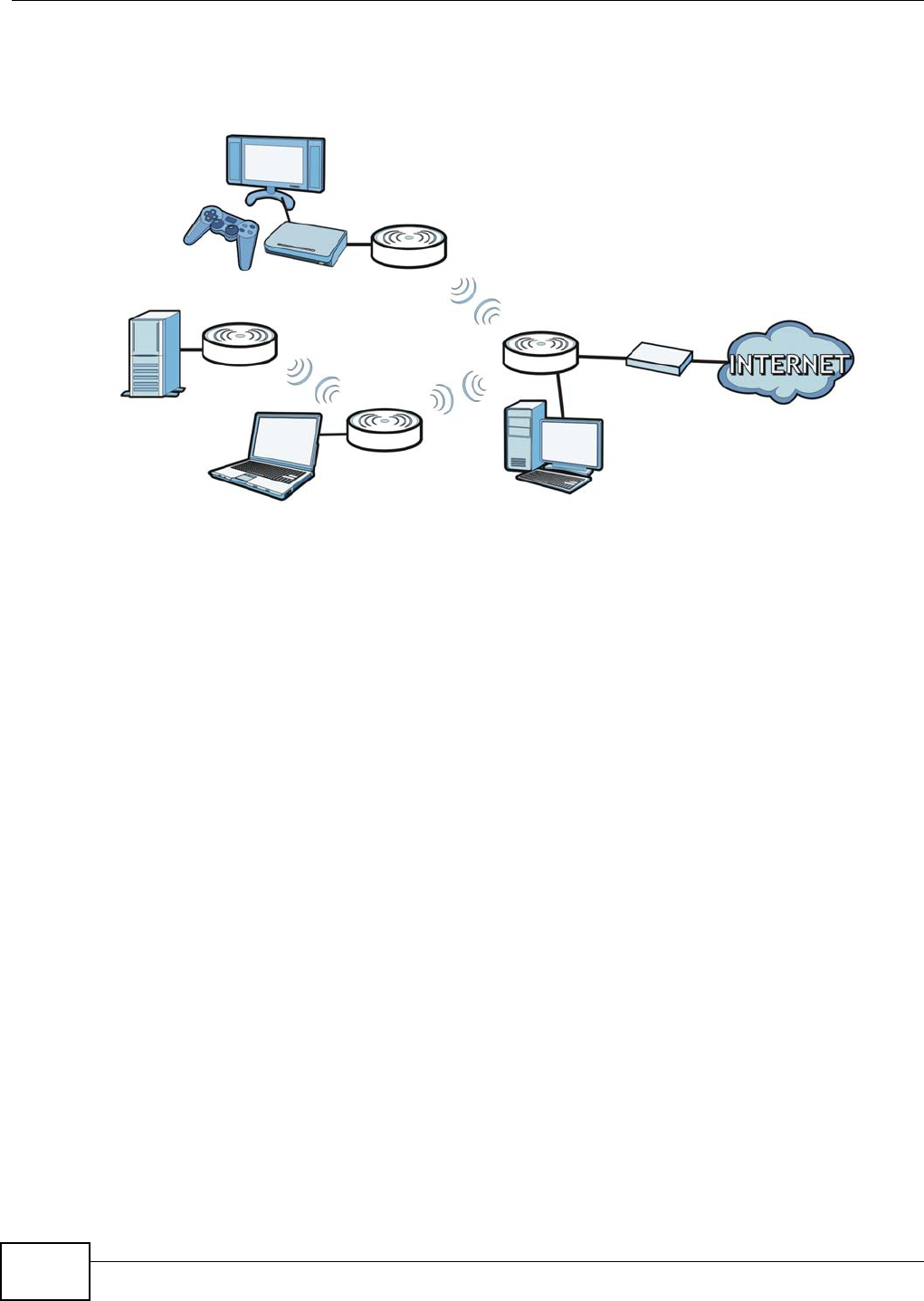
Chapter 1 Getting to Know Your WAP5605
WAP5605 User’s Guide
16
•Client. Use the switch on the side panel to set the WAP5605 to work in client mode (CL). The
WAP5605 in client mode can access the Internet through a WAP5605 in AP mode and/or connect
to another WAP5605 in client mode using IEEE 802.11e Direct Link Setup (DLS).
Figure 1 WAP5605 Applications
1.3 Ways to Manage the WAP5605
Use any of the following methods to manage the WAP5605.
• Web Configurator. This is recommended for everyday management of the WAP5605 using a
(supported) web browser.
• WPS (Wi-Fi Protected Setup) button. You can use the WPS button or the WPS section of the Web
Configurator to set up a wireless network with your WAP5605.
1.4 Good Habits for Managing the WAP5605
Do the following things regularly to make the WAP5605 more secure and to manage the WAP5605
more effectively.
• Change the password. Use a password that’s not easy to guess and that consists of different
types of characters, such as numbers and letters.
• Write down the password and put it in a safe place.
• Back up the configuration (and make sure you know how to restore it). Restoring an earlier
working configuration may be useful if the device becomes unstable or even crashes. If you
forget your password, you will have to reset the WAP5605 to its factory default settings. If you
backed up an earlier configuration file, you would not have to totally re-configure the WAP5605.
You could simply restore your last configuration.
AP
CL
CL
CL

Chapter 1 Getting to Know Your WAP5605
WAP5605 User’s Guide 17
1.5 Resetting the WAP5605
If you forget your password or IP address, or you cannot access the Web Configurator, you will need
to use the RESET button at the back of the WAP5605 to reload the factory-default configuration
file. This means that you will lose all configurations that you had previously saved, the password
will be reset to “1234” and the IP address of the WAP5605 in AP mode will be reset to
“192.168.1.2” and the IP address of the WAP5605 in client mode will be reset to “192.168.1.10”.
1.5.1 Procedure to Use the Reset Button
1Make sure the power LED is on.
2Press the RESET button for longer than 1 second to restart/reboot the WAP5605.
3Press the RESET button for longer than five seconds to set the WAP5605 back to its factory-default
configurations.
1.6 The WPS Button
You can use the WPS button ( ) on the front panel of the WAP5605 to activate WPS in order to
quickly set up a wireless network with strong security.
1Make sure the POWER LED is on (not blinking).
2Press the WPS button for more than three seconds and release it. Press the WPS button on another
WPS-enabled device within range of the WAP5605.
Note: You must activate WPS in the WAP5605 that acts as the AP and in another
WAP5605 that acts as the client within two minutes of each other.

Chapter 1 Getting to Know Your WAP5605
WAP5605 User’s Guide
18
1.7 LEDs
Figure 2 Front Panel
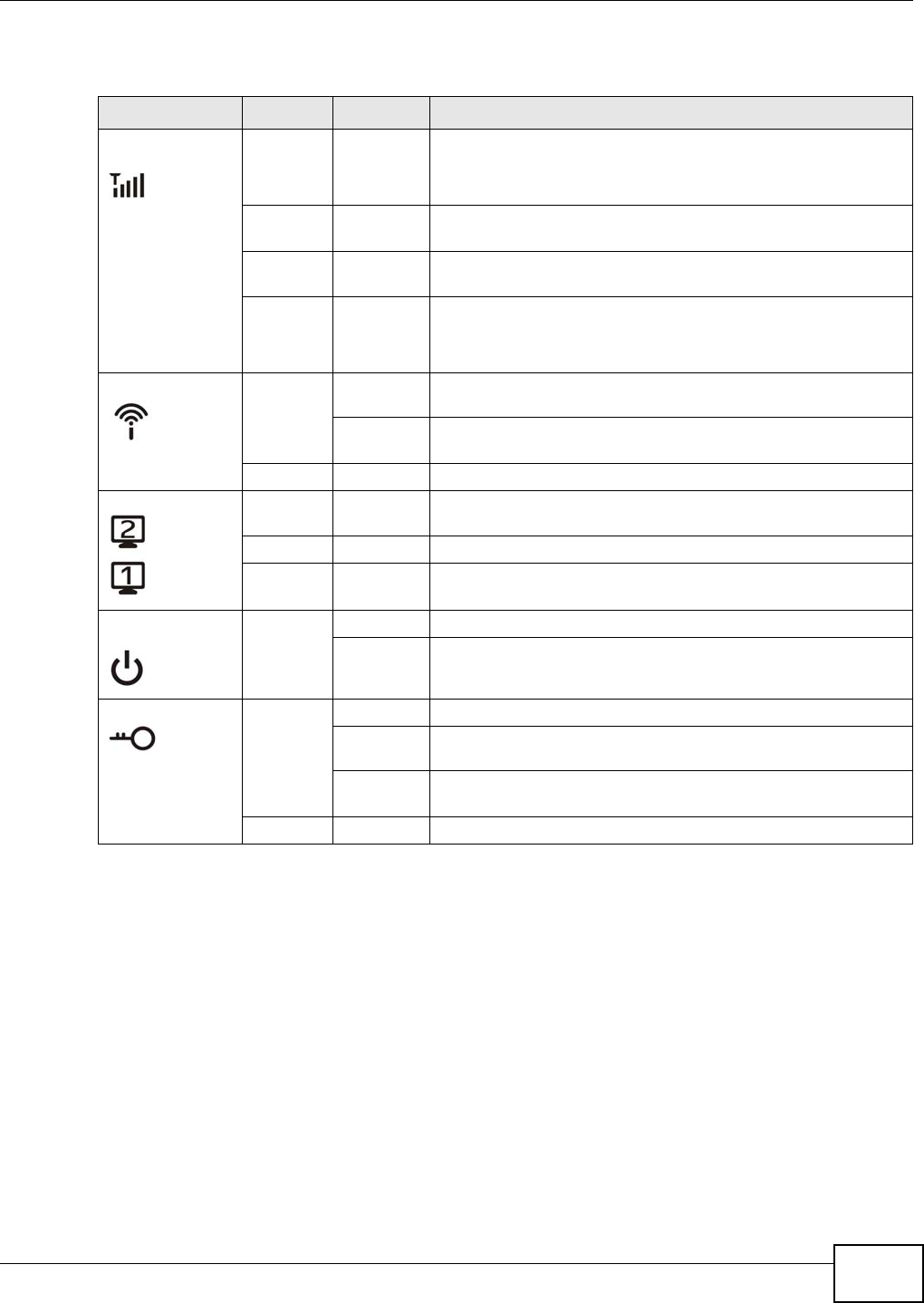
Chapter 1 Getting to Know Your WAP5605
WAP5605 User’s Guide 19
The following table describes the LEDs and the WPS button.
Table 1 Front Panel LEDs and WPS Button
LED COLOR STATUS DESCRIPTION
Quality Green On AP mode: This LED is always on after the system starts up.
Client mode: The WAP5605 is connecting to an AP and the
transmission rate is 65 Mbps or above.
Amber On Client mode: The WAP5605 is connecting to an AP and the
transmission rate is between 65 Mbps and 19.5 Mbps.
Red On Client mode: The WAP5605 is connecting to an AP and the
transmission rate is below 19.5 Mbps.
Off AP mode: The WAP5605 is not receiving power.
Client mode: The WAP5605 is not receiving power or not
associating with an AP.
Wireless Green On The WAP5605 is ready, but is not sending/receiving data
through the wireless LAN.
Blinking The WAP5605 is sending/receiving data through the wireless
LAN.
Off The wireless LAN is not ready or has failed.
LAN 1-2 Green On The WAP5605 has a successful 10/100/1000 Mbps Ethernet
connection.
Blinking The WAP5605 is sending/receiving data through the LAN.
Off The LAN is not connected.
Power Green On The WAP5605 is receiving power and functioning properly.
Off The WAP5605 is not receiving power.
WPS Blue On WPS is enabled.
Blinking
(slow)
The WAP5605 is negotiating a WPS connection with a wireless
device.
Blinking
(fast)
The WPS negotiation failed.
Off The wireless LAN is not ready or has failed.

Chapter 1 Getting to Know Your WAP5605
WAP5605 User’s Guide
20

WAP5605 User’s Guide 21
CHAPTER 2
WAP5605 Modes
2.1 Overview
This chapter introduces the different modes available on your WAP5605. First, the term “mode”
refers to two things in this User’s Guide.
•Web Configurator mode. This refers to the Web Configurator interface you want to use for
editing WAP5605 features.
•Device mode. This is the operating mode of your WAP5605, or simply how the WAP5605 is
being used in the network.
2.1.1 Web Configurator Modes
This refers to the configuration interface of the Web Configurator, which has two modes:
•Easy. The Web Configurator shows this mode by default. Refer to Chapter 3 on page 23 for more
information on the screens in this mode. This interface may be sufficient for users who just want
to use the device.
•Expert. Advanced users can change to this mode to customize all the functions of the WAP5605.
Click Expert Mode after logging into the Web Configurator. The User’s Guide Chapter 6 on page
49 through Chapter 11 on page 93 discusses the screens in this mode.
2.1.2 Device Operating Modes
This refers to the operating mode of the WAP5605, which can act as a:
•Access Point (AP). Use this mode if you want to extend your network by allowing network
devices to connect to the WAP5605 wirelessly. Go to Section 4.4 on page 33 to view the Status
screen in this mode.
•Client (CL). Use this mode if there is an existing WAP5605 that acts as an AP in your network.
Go to Section 5.5 on page 39 to view the Status screen in this mode. In Client mode, you should
know the SSID and wireless security details of the WAP5605 to which you want to connect.
Note: Choose your device mode carefully to avoid having to change it later.
2.1.2.1 Changing Operating Mode
Push the AP/CL switch on the WAP5605’s side panel to the AP position to have the WAP5605 act
as an access point. Otherwise, push the switch to the CL position to have the WAP5605 work as a
wireless client. The WAP5605 restarts automatically after you change operating modes.
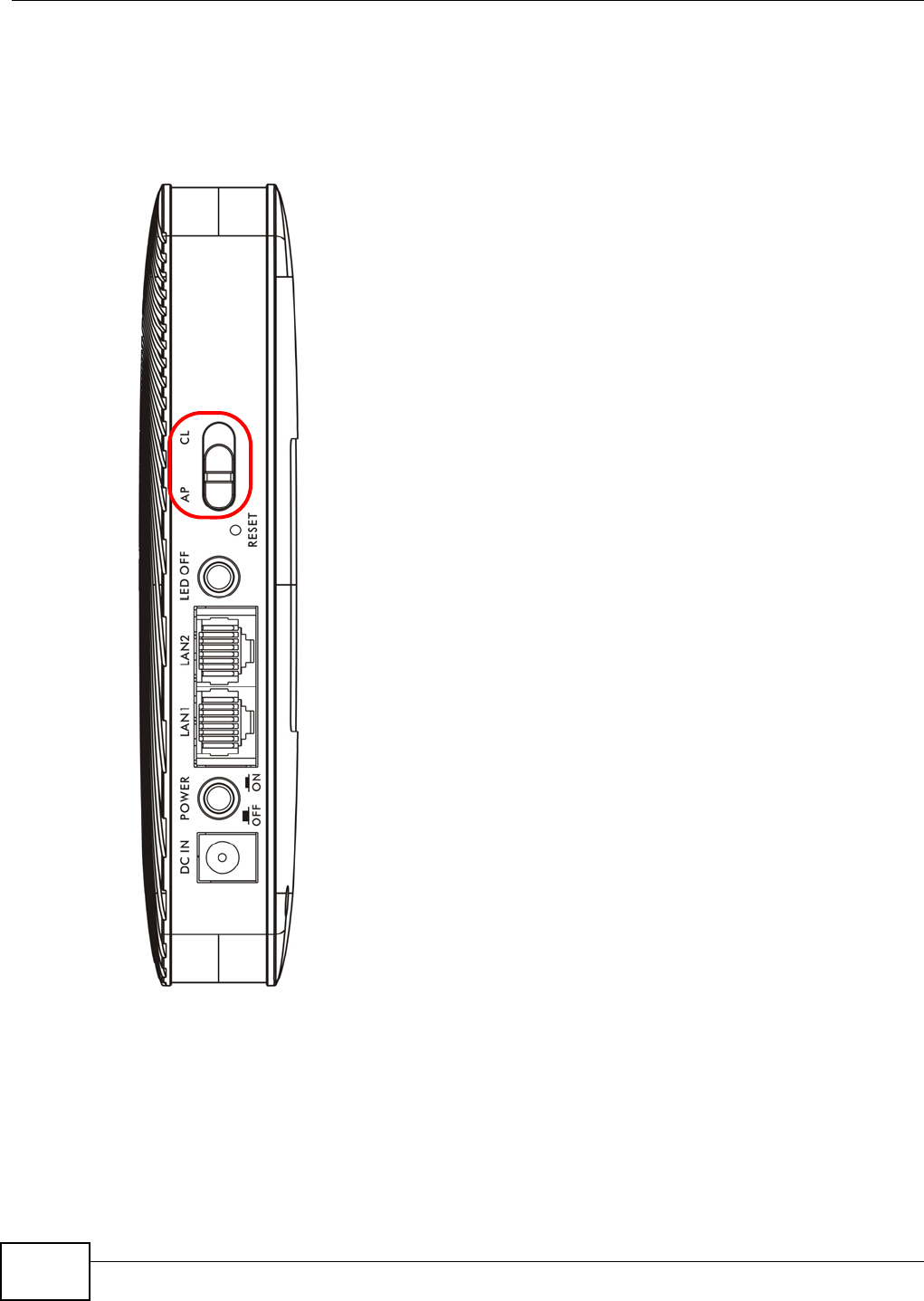
Chapter 2 WAP5605 Modes
WAP5605 User’s Guide
22
Note: When you change the WAP5605 mode from AP mode to client mode, make sure
you use the RESET button to return the IP address of the WAP5605 in client mode
to 192.168.1.10. Otherwise, the client mode IP address will be the same as the
access point mode IP address.
Figure 3 Side Panel
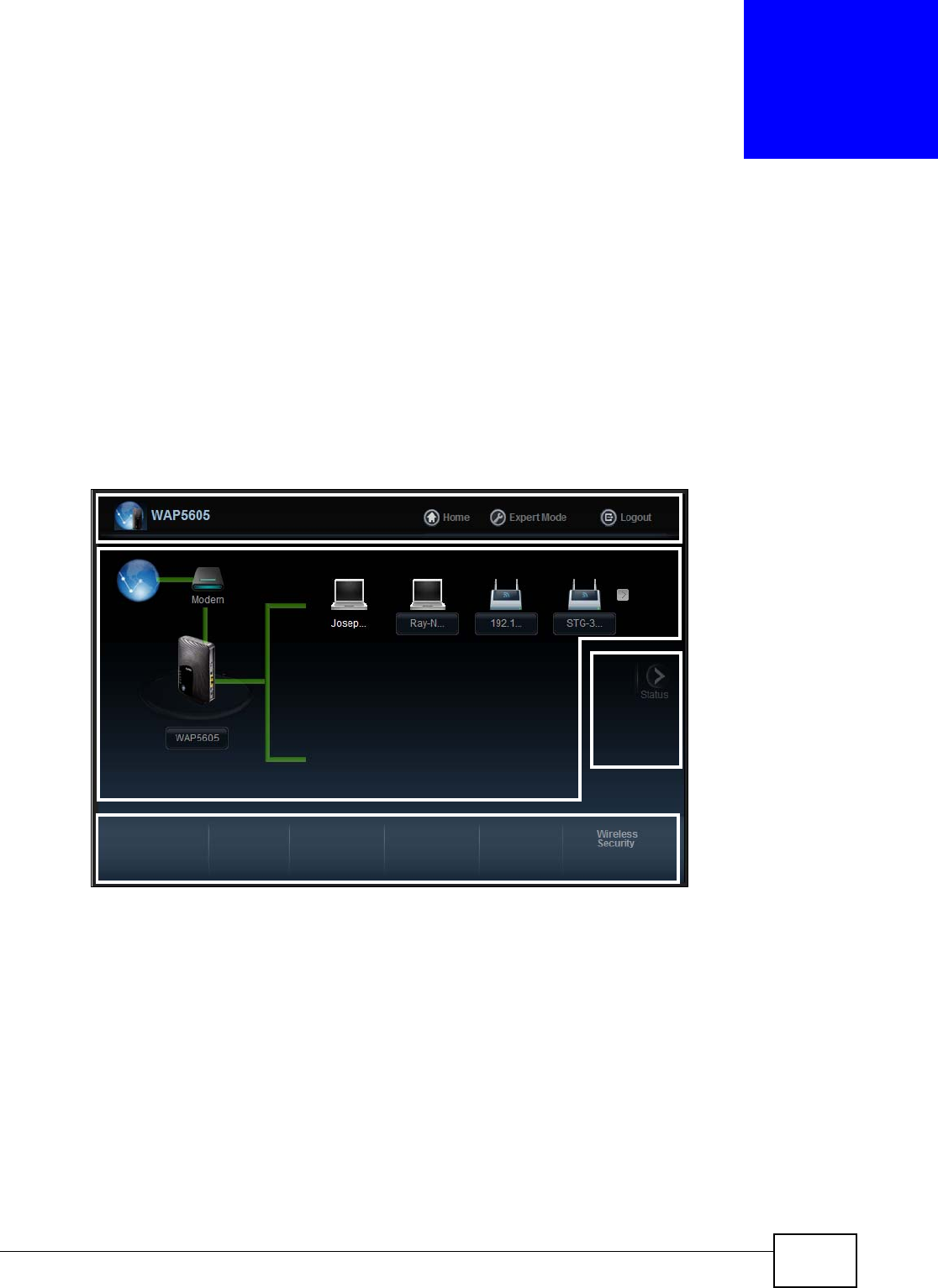
WAP5605 User’s Guide 23
CHAPTER 3
Easy Mode
3.1 Overview
The Web Configurator is set to Easy Mode by default. You can configure several key features of the
WAP5605 in this mode. This mode is useful to users who are not fully familiar with some features
that are usually intended for network administrators.
When you log in to the Web Configurator, the following screen opens.
Figure 4 Easy Mode: Network Map
Network Map
Control Panel
Go to
Status
Screen
Navigation Panel
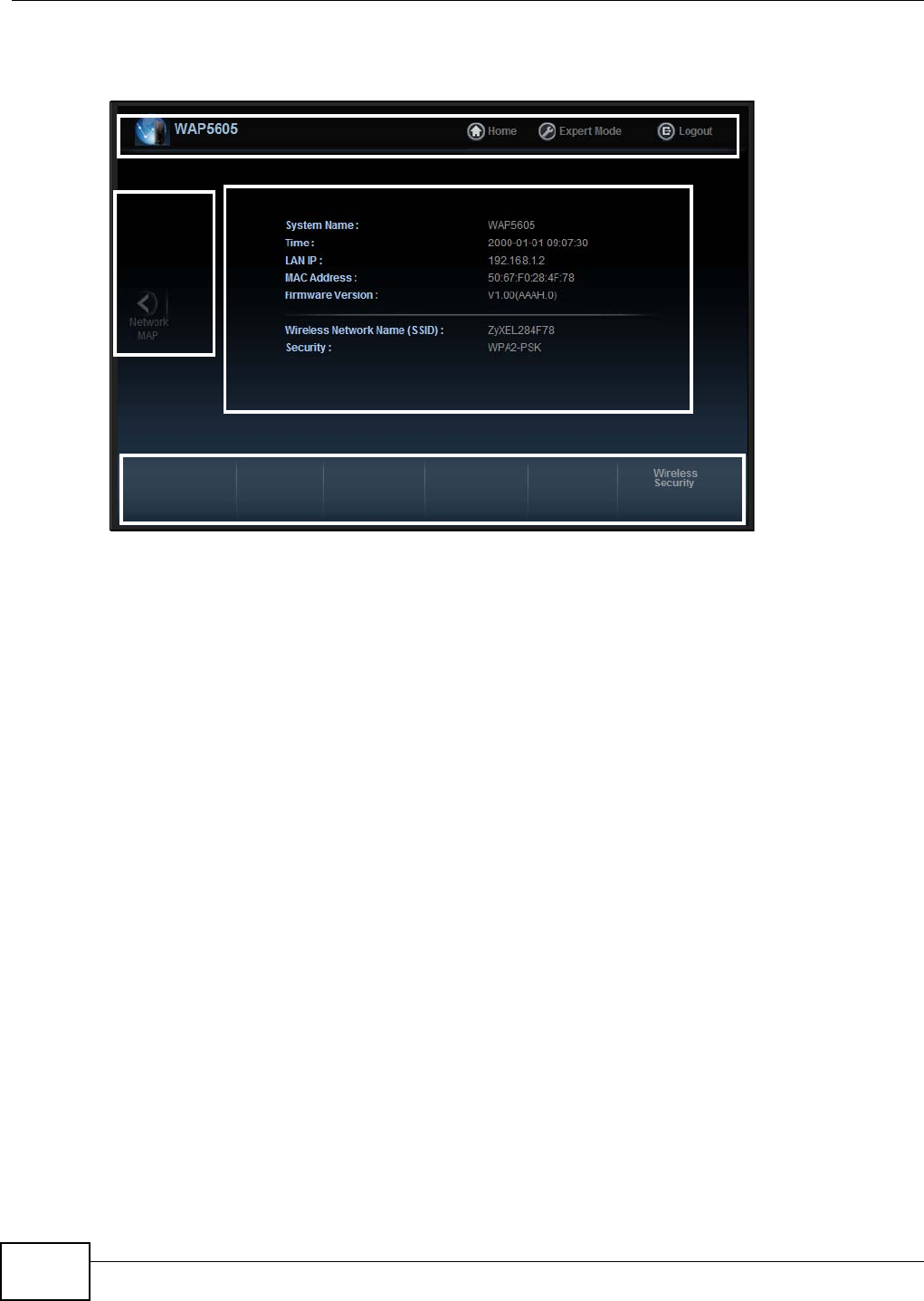
Chapter 3 Easy Mode
WAP5605 User’s Guide
24
Click Status to open the following screen.
Figure 5 Easy Mode: Status Screen
3.2 What You Can Do
You can do the following in this mode:
•Use this Navigation Panel (Section 3.4 on page 25) to opt out of the Easy mode.
•Use the Network Map screen (Section 3.5 on page 25) to check if your WAP5605 can ping the
gateway and whether it is connected to the Internet.
•Use the Control Panel (Section 3.6 on page 26) to configure wireless security.
•Use the Status Screen screen (Section 3.7 on page 30) to view read-only information about the
WAP5605, including the LAN IP, MAC Address of the WAP5605 and the firmware version.
3.3 What You Need to Know
Wireless Security in the control panel is not configurable when the WAP5605 is in client mode.
Control Panel
Status Screen
Go to
Network
Map
Screen
Navigation Panel
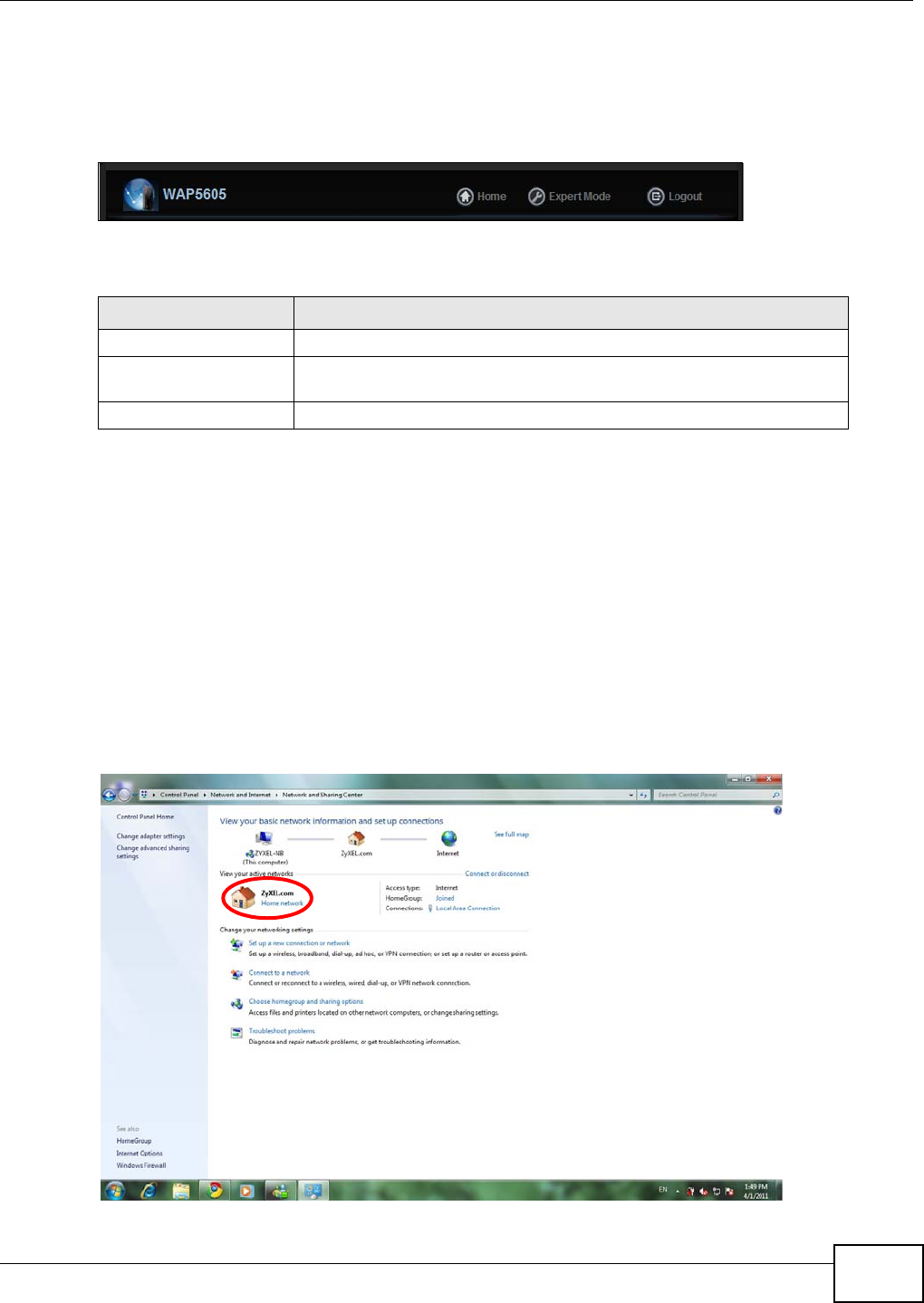
Chapter 3 Easy Mode
WAP5605 User’s Guide 25
3.4 Navigation Panel
Use this navigation panel to opt out of the Easy mode.
Figure 6 Control Panel
The following table describes the labels in this screen.
3.5 Network Map
Note: The Network MAP is viewable by Windows XP (need to install patch), Windows Vista
and Windows 7 users only. For Windows XP (Service Pack 2) users, you can see the
network devices connected to the WAP5605 by downloading the LLTD (Link Layer
Topology Discovery) patch from the Microsoft Website.
Note: In Windows Vista or Windows 7, you should set your network location to “Home
network” in the Control Panel > Network and Internet > Network and Sharing
Center screen.
Figure 7 Set Network Location to Home Network in Windows Vista or 7
Table 2 Control Panel
ITEM DESCRIPTION
Home Click this to go to the Login page.
Expert Mode Click this to change to Expert mode and customize features of the
WAP5605.
Logout Click this to end the Web Configurator session.
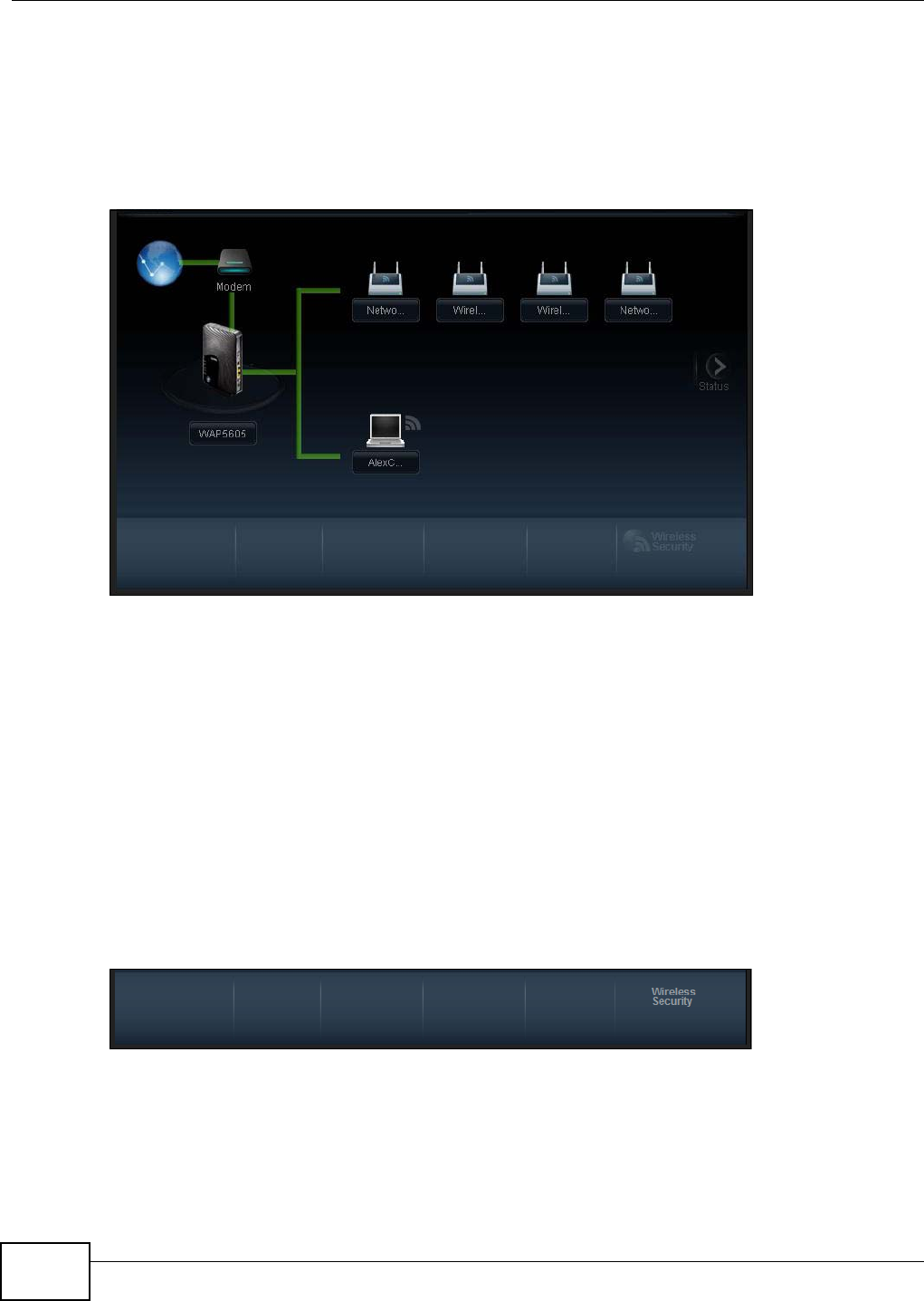
Chapter 3 Easy Mode
WAP5605 User’s Guide
26
Note: Don’t worry if the Network Map does not display in your web browser. This feature
may not be supported by your system. You can still configure the Control Panel
(Section 3.6 on page 26) in the Easy Mode and the WAP5605 features that you
want to use in the Expert Mode.
When you log into the Web Configurator, the Network Map is shown as follows.
Figure 8 Network Map
The line connecting the WAP5605 to the gateway becomes green when the WAP5605 is able to ping
the gateway. It becomes red when the ping initiating from the WAP5605 does not get a response
from the gateway. The same rule applies to the line connecting the gateway to the Internet.
You can also view the devices (represented by icons indicating the kind of network device)
connected to the WAP5605, including those connecting wirelessly. Right-click on the WAP5605 icon
to refresh the network map. Right click on the other icons to view information about the device or
left-click the device icon to access its web configurator or files in the shared folder.
3.6 Control Panel
The features configurable in Easy Mode are shown in the Control Panel.
Figure 9 Control Panel
Click the feature to open a screen where you can edit its settings.
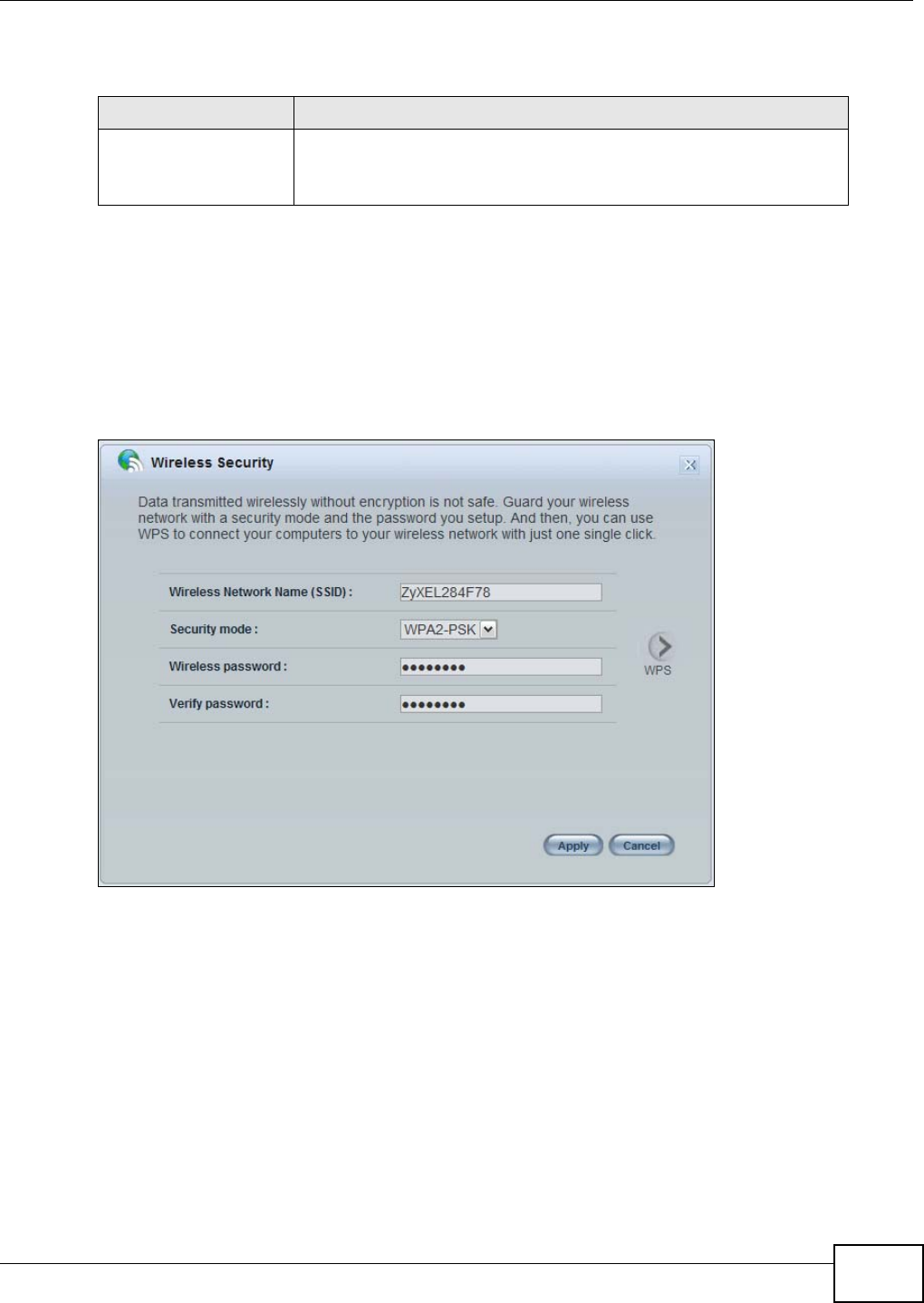
Chapter 3 Easy Mode
WAP5605 User’s Guide 27
The following table describes the labels in this screen.
3.6.1 Wireless Security
Use this screen to configure security for your the wreless LAN. You can enter the SSID and select
the wireless security mode in the following screen.
Note: Wireless Security in the control panel is not configurable when the WAP5605 is in
client mode.
Figure 10 Wireless Security
Table 3 Control Panel
ITEM DESCRIPTION
Wireless Security Click this to configure the wireless security, such as SSID, security mode
and WPS key on your WAP5605.
Refer to Section 3.6.1 on page 27 to see this screen.

Chapter 3 Easy Mode
WAP5605 User’s Guide
28
The following table describes the general wireless LAN labels in this screen.
Table 4 Wireless Security
LABEL DESCRIPTION
Wireless
Network Name
(SSID)
(Service Set IDentity) The SSID identifies the Service Set with which a wireless
station is associated. Wireless stations associating to the access point (AP) must
have the same SSID. Enter a descriptive name (up to 32 keyboard characters) for
the wireless LAN.
The default SSID is “ZyXEL+(the last six characters of the WAP5605’s MAC
address)”.
Security mode Select WPA-PSK or WPA2-PSK to add security on this wireless network. The
wireless clients which want to associate to this network must have same wireless
security settings as this device. After you select to use a security, additional options
appears in this screen.
Select No Security to allow any client to connect to this network without
authentication.
Wireless
password
This field appears when you choose wither WPA-PSK or WPA2-PSK as the
security mode.
Type a pre-shared key from 8 to 63 case-sensitive keyboard characters.
Verify
password
Type the password again to confirm.
Apply Click Apply to save your changes back to the WAP5605.
Cancel Click Cancel to close this screen.
WPS Click this to configure the WPS screen.
You can transfer the wireless settings configured here (Wireless Security screen)
to another wireless device that supports WPS.
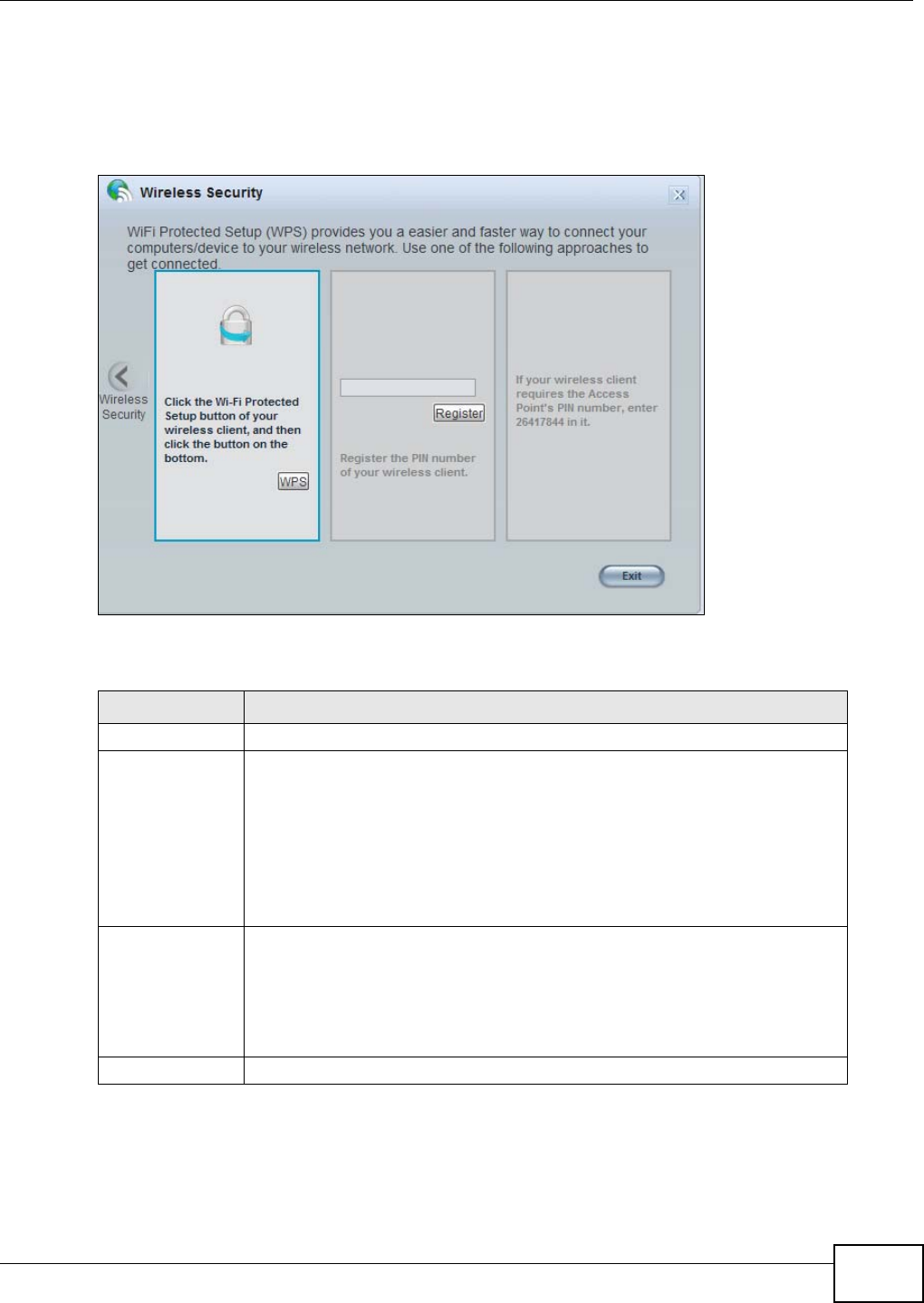
Chapter 3 Easy Mode
WAP5605 User’s Guide 29
3.6.2 WPS
Use this screen to add a wireless station to the network with the WAP5605’s first SSID using WPS.
Click WPS in the Wireless Security to open the following screen.
Figure 11 Wireless Security: WPS
The following table describes the labels in this screen.
Table 5 Wireless Security: WPS
LABEL DESCRIPTION
Wireless Security Click this to go back to the Wireless Security screen.
WPS Create a secure wireless network simply by pressing the button.
The WAP5605 scans for a WPS-enabled device within the range and performs
wireless security information synchronization.
Note: After you click the WPS button on this screen, you have to press a similar
button in the wireless station utility within 2 minutes. To add the second
wireless station, you have to press these buttons on both device and the
wireless station again after the first 2 minutes.
Register Create a secure wireless network simply by entering a wireless client's PIN
(Personal Identification Number) in the WAP5605’s interface and pushing this
button.
Type the same PIN number generated in the wireless station’s utility. Then click
Register to associate to each other and perform the wireless security
information synchronization.
Exit Click Exit to close this screen.
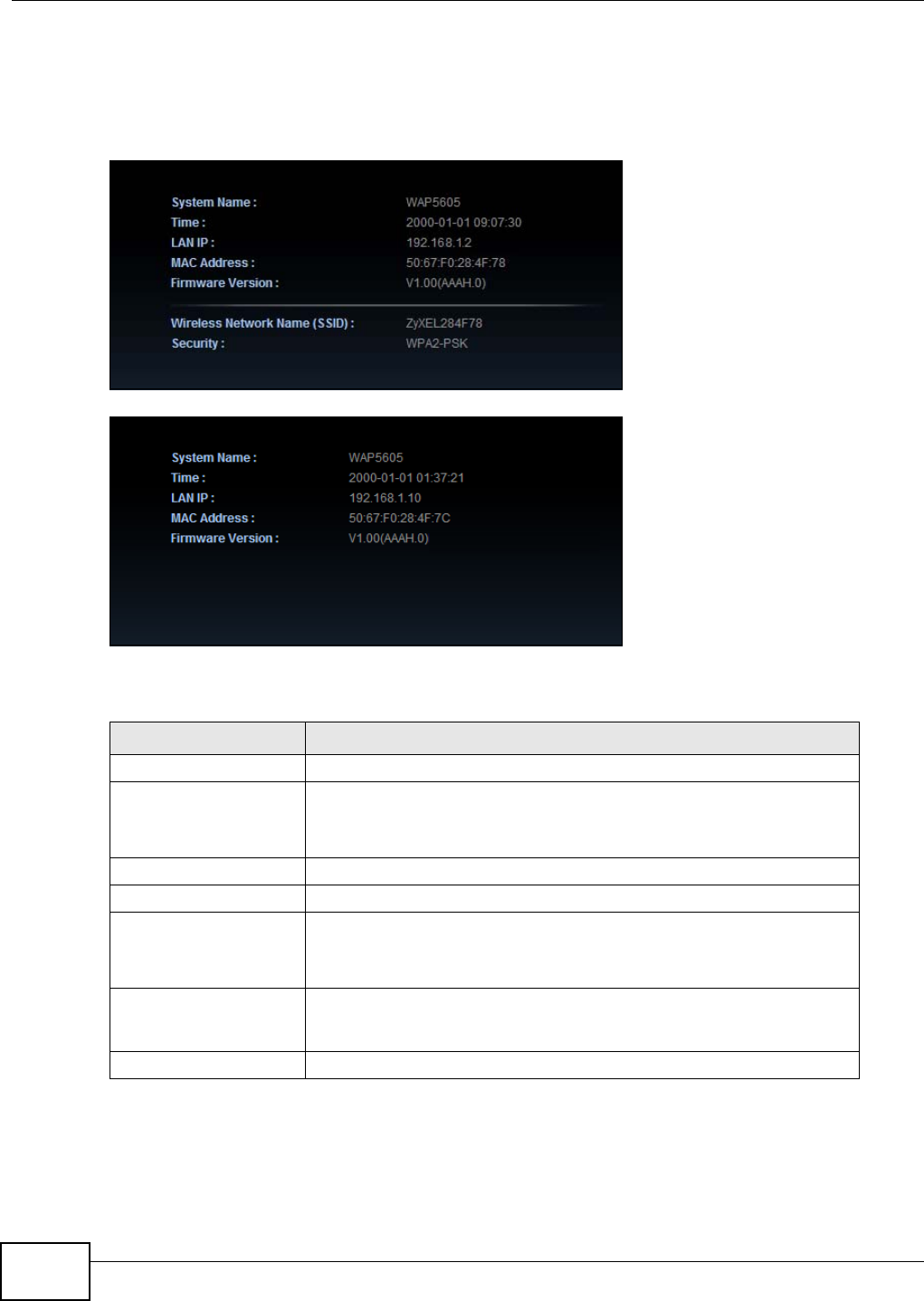
Chapter 3 Easy Mode
WAP5605 User’s Guide
30
3.7 Status Screen in Easy Mode
In the Network Map screen, click Status to view read-only information about the WAP5605.
Figure 12 Status Screen in Easy Mode (AP)
Figure 13 Status Screen in Easy Mode (Client)
The following table describes the labels in this screen.
Table 6 Status Screen in Easy Mode
ITEM DESCRIPTION
Name This is the name of the WAP5605 in the network.
Time This is the current system date and time.
The date is in YYYY:MM:DD (Year-Month-Day) format. The time is in
HH:MM:SS (Hour:Minutes:Seconds) format.
LAN IP This is the IP address of the LAN port.
MAC Address This is the MAC address of the WAP5605.
Firmware Version This shows the firmware version of the WAP5605.
The firmware version format shows the trunk version, model code and
release number.
Wireless Network Name
(SSID)
This shows the SSID of the wireless network. You can configure this in the
Wireless Security screen (Section 3.6.1 on page 27; Section 9.5 on
page 79).
Security This shows the wireless security used by the WAP5605.
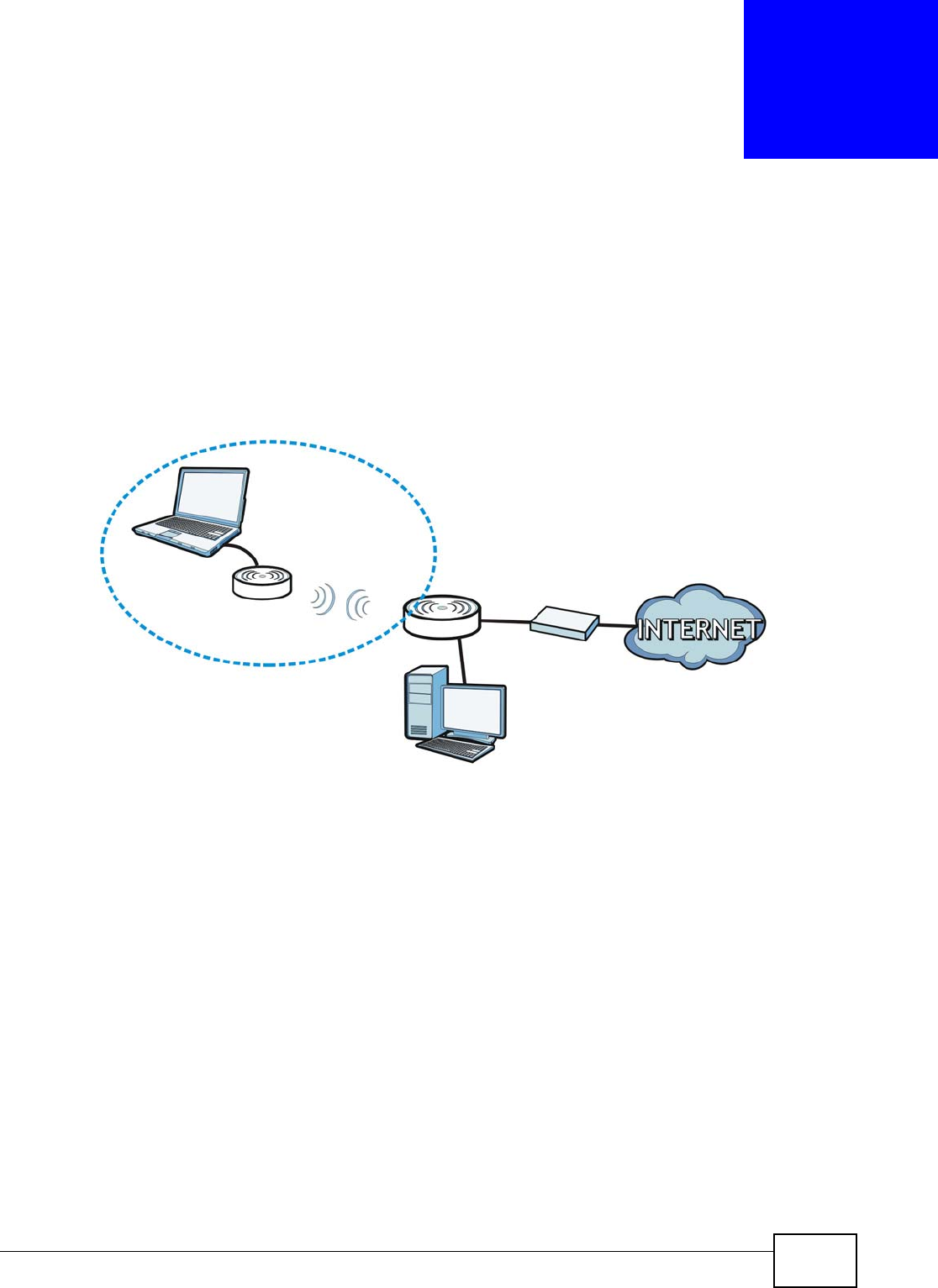
WAP5605 User’s Guide 31
CHAPTER 4
Access Point Mode
4.1 Overview
The WAP5605 is set to access point mode by default. In this mode your WAP5605 bridges a wired
network (LAN) and wireless LAN (WLAN) in the same subnet. See the figure below for an example.
Figure 14 Wireless Internet Access in Access Point Mode
Note: See Chapter 7 on page 55 for an example of setting up a wireless network in
Access Point mode.
4.2 What You Can Do
•Use the Status screen (Section 4.4 on page 33) to view read-only information about your
WAP5605.
•Use the LAN screen (Chapter 10 on page 89) to set the IP address for your WAP5605 acting as
an access point.
•Use the Wireless LAN screens (Chapter 9 on page 75) to configure the wireless settings and
wireless security between the wireless clients and the WAP5605.
WLAN
LAN

Chapter 4 Access Point Mode
WAP5605 User’s Guide
32
4.3 What You Need to Know
See Chapter 7 on page 55 for a tutorial on setting up a network with the WAP5605 as an access
point.
4.3.1 Setting your WAP5605 to AP Mode
1To use your WAP5605 as an access point, see Section 2.1.2.1 on page 21.
2Connect your computer to the LAN port of the WAP5605.
3The default IP address of the WAP5605 in access point mode is “192.168.1.2”. In this case, your
computer must have an IP address in the range between “192.168.1.3” and “192.168.1.254”.
4Click Start > Run on your computer in Windows. Type “cmd” in the dialog box. Enter “ipconfig” to
show your computer’s IP address. If your computer’s IP address is not in the correct range then see
Appendix C on page 135 for information on changing your computer’s IP address.
5After you’ve set your computer’s IP address, open a web browser such as Internet Explorer and
type “http://192.168.1.2” as the web address in your web browser.
6Enter “1234” (default) as the password and click Login.
7Type a new password and retype it to confirm, then click Apply. Otherwise, click Ignore.
8The Easy mode appears. Click Expert Mode in the navigation panel.
4.3.2 Configuring your WLAN, LAN and Maintenance Settings
•See Chapter 9 on page 75 and Chapter 10 on page 89 for information on the configuring your
wireless network and LAN settings.
•See Chapter 11 on page 93 for information on configuring your Maintenance settings.
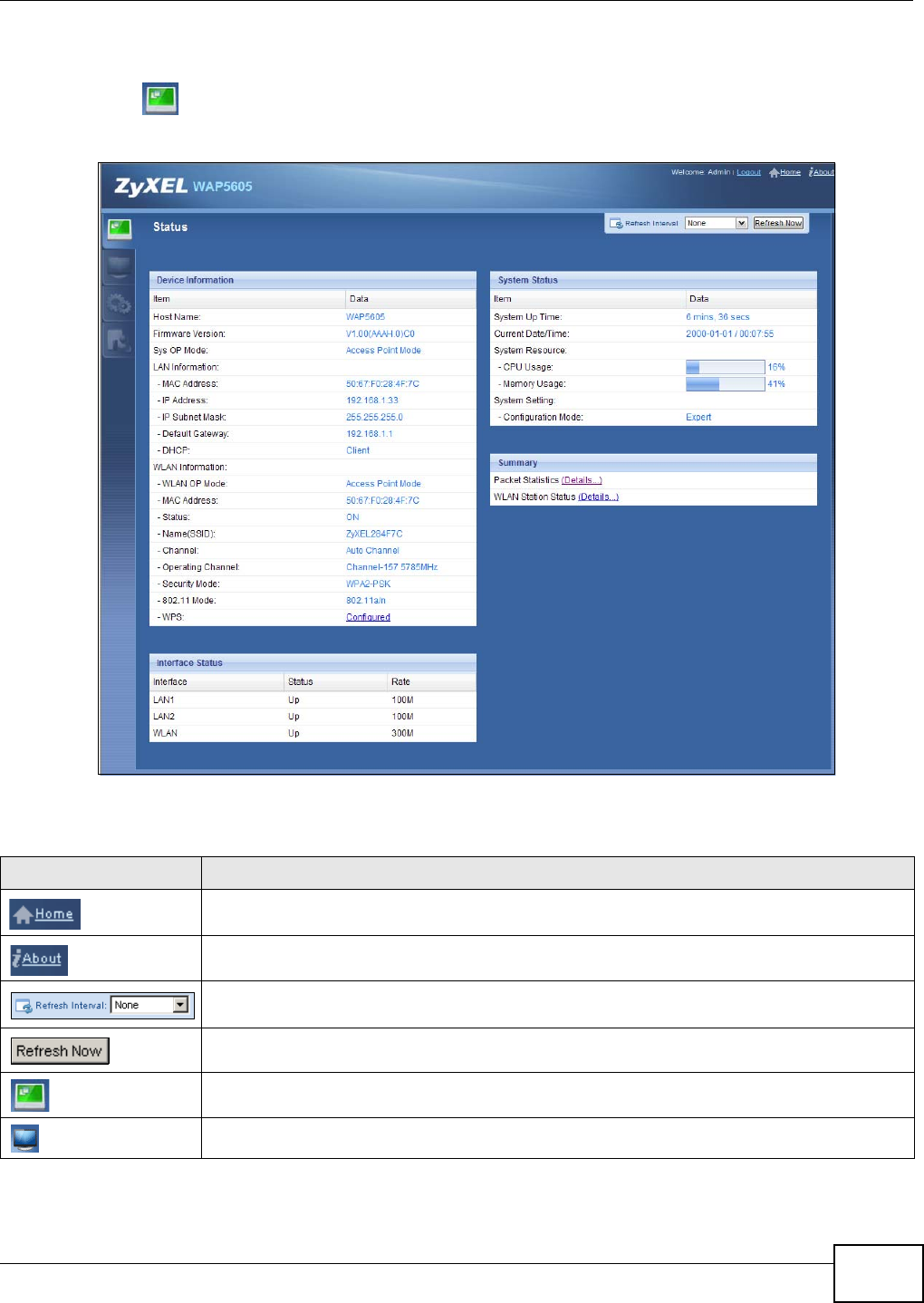
Chapter 4 Access Point Mode
WAP5605 User’s Guide 33
4.4 AP Mode Status Screen
Click to open the Status screen.
Figure 15 Status Screen: Access Point Mode
The following table describes the icons shown in the Status screen.
Table 7 Status Screen Icon Key: Access Point Mode
ICON DESCRIPTION
Click this to go to the Home page. See Section 6.2.3 on page 51.
Click this icon to view copyright and a link for related product information.
Select a number of seconds or None from the drop-down list box to refresh all screen statistics
automatically at the end of every time interval or to not refresh the screen statistics.
Click this button to refresh the status screen statistics.
Click this icon to see the Status page. The information in this screen depends on the device
mode you select.
Click this icon to see the Monitor navigation menu.

Chapter 4 Access Point Mode
WAP5605 User’s Guide
34
The following table describes the labels shown in the Status screen.
Click this icon to see the Configuration navigation menu.
Click this icon to see the Maintenance navigation menu.
Table 7 Status Screen Icon Key: Access Point Mode (continued)
ICON DESCRIPTION
Table 8 Status Screen: Access Point Mode
LABEL DESCRIPTION
Logout Click this at any time to exit the Web Configurator.
Device Information
Host Name This is the WAP5605’s model name.
Firmware Version This is the firmware version and the date created.
Sys OP Mode This is the device operating mode (Section 2.1.2 on page 21) to which the WAP5605 is set -
Access Point Mode.
LAN Information
MAC Address This shows the LAN Ethernet adapter MAC Address of your device.
IP Address This shows the LAN port’s IP address.
IP Subnet Mask This shows the LAN port’s subnet mask.
Default Gateway This shows the gateway IP address.
DHCP This shows the LAN port’s DHCP role - Client or None.
WLAN Information
WLAN OP Mode This is the device operating mode (Section 2.1.2 on page 21) to which the WAP5605’s
wireless LAN is set - Access Point Mode.
MAC Address This shows the wireless adapter MAC Address of your device.
Status This shows the current status of the Wireless LAN - ON.
Name (SSID) This shows a descriptive name used to identify the WAP5605 in the wireless LAN.
Channel This shows the channel number which you select manually or the WAP5605 automatically
scans and selects.
Operating Channel This shows the channel number which the WAP5605 is currently using over the wireless LAN.
Security Mode This shows the level of wireless security the WAP5605 is using.
802.11 Mode This shows the wireless standard.
WPS This displays Configured when the WPS has been set up.
This displays Unconfigured if the WPS has not been set up.
Click the status to display Network > Wireless LAN > WPS screen.
Interface Status
Interface This displays the WAP5605 port types. The port types are: LAN and WLAN.
Status For the LAN ports, this field displays Down (line is down) or Up (line is up or connected).
For the WLAN, it displays Up when the WLAN is enabled or Down when the WLAN is
disabled.
Rate For the LAN ports, this displays the port speed or N/A when the line is disconnected.
For the WLAN, it displays the maximum transmission rate when the WLAN is enabled and N/
A when the WLAN is disabled.
System Status
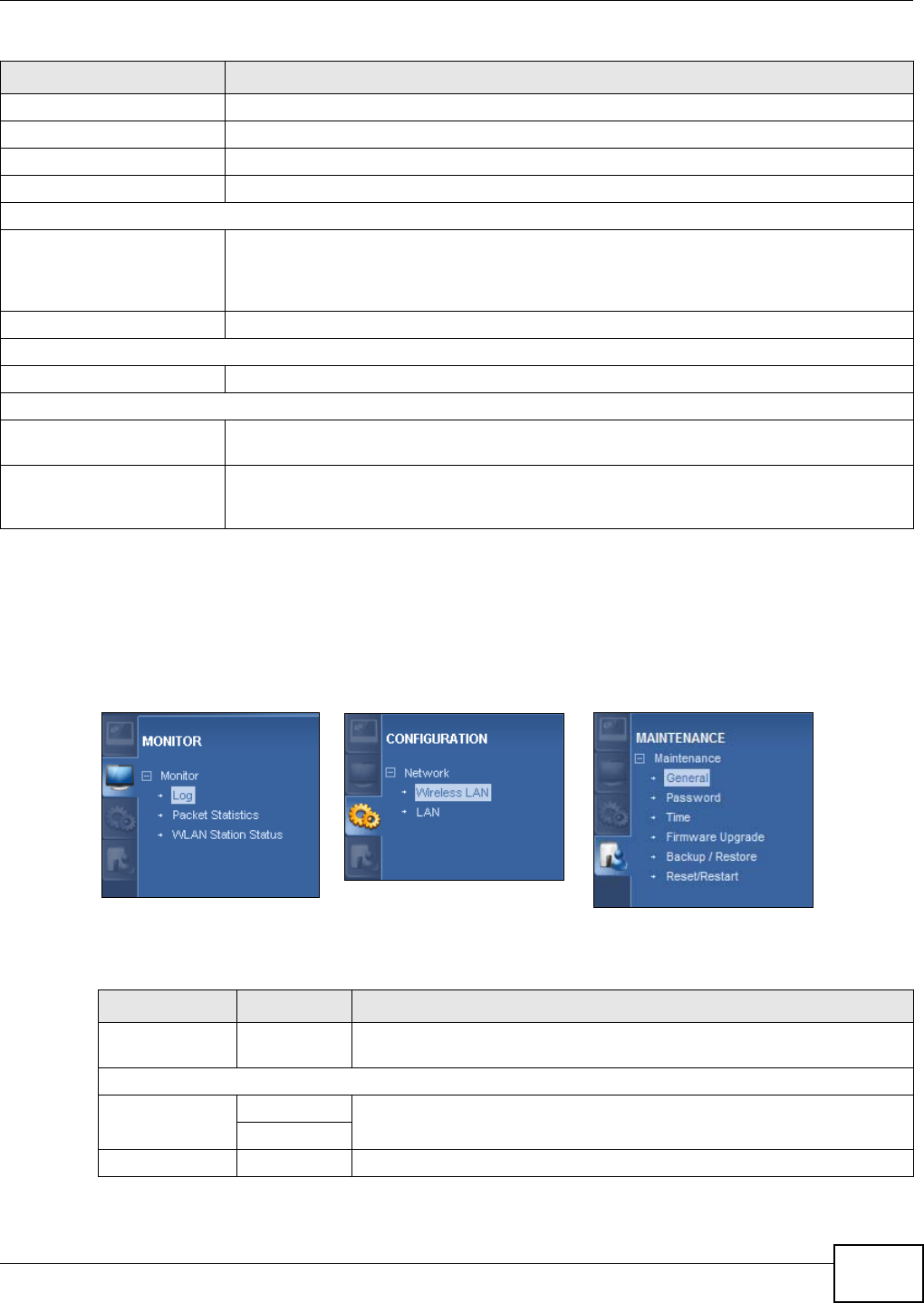
Chapter 4 Access Point Mode
WAP5605 User’s Guide 35
4.4.1 Navigation Panel
Use the menu in the navigation panel to configure WAP5605 features in Access Point mode.
The following screen and table show the features you can configure in Access Point mode.
Figure 16 Menu: Access Point Mode
The following table describes the sub-menus.
Item This column shows the type of data the WAP5605 is recording.
Data This column shows the actual data recorded by the WAP5605.
System Up Time This is the total time the WAP5605 has been on.
Current Date/Time This field displays your WAP5605’s present date and time.
System Resource
CPU Usage This displays what percentage of the WAP5605’s processing ability is currently used. When
this percentage is close to 100%, the WAP5605 is running at full load, and the throughput is
not going to improve anymore. If you want some applications to have more throughput, you
should turn off other applications (for example, using bandwidth management.
Memory Usage This shows what percentage of the heap memory the WAP5605 is using.
System Setting
Configuration Mode This shows the web configurator mode you are viewing - Expert.
Summary
Packet Statistics Click Details... to go to the Monitor > Packet Statistics screen (Section 8.5 on page 73).
Use this screen to view port status and packet specific statistics.
WLAN Station Status Click Details... to go to the Monitor > WLAN Station Status screen (Section 8.6 on page
74). Use this screen to view the wireless stations that are currently associated to the
WAP5605.
Table 8 Status Screen: Access Point Mode
LABEL DESCRIPTION
Table 9 Navigation Panel: Access Point Mode
LINK TAB FUNCTION
Status This screen shows the WAP5605’s general device, system and interface
status information. Use this screen to access the summary statistics tables.
MONITOR
Log View Log Use this screen to view the list of activities recorded by your WAP5605 and
change your log settings.
Log Settings
Packet Statistics Use this screen to view port status and packet specific statistics.

Chapter 4 Access Point Mode
WAP5605 User’s Guide
36
WLAN Station
Status
Use this screen to view the wireless stations that are currently associated
to the WAP5605.
CONFIGURATION
Network
Wireless LAN General Use this screen to configure general wireless LAN settings.
Security Use this screen to configure wireless security settings.
MAC Filter Use the MAC filter screen to configure the WAP5605 to block access to
devices or block the devices from accessing the WAP5605.
Advanced This screen allows you to configure advanced wireless settings.
QoS Use this screen to configure Wi-Fi Multimedia Quality of Service (WMM
QoS). WMM QoS allows you to prioritize wireless traffic according to the
delivery requirements of individual services.
WPS Use this screen to configure WPS.
WPS Station Use this screen to add a wireless station using WPS.
Scheduling Use this screen to schedule the times the Wireless LAN is enabled.
LAN IP Use this screen to configure LAN IP address and subnet mask.
IP Alias Use this screen to have the WAP5605 apply IP alias to create LAN subnets.
MAINTENANCE
General Use this screen to view and change administrative settings such as system
and domain names.
Password Password
Setup
Use this screen to change the password of your WAP5605.
Time Time Setting Use this screen to change your WAP5605’s time and date.
Firmware
Upgrade Use this screen to upload firmware to your WAP5605.
Backup/
Restore Use this screen to backup and restore the configuration or reset the factory
defaults to your WAP5605.
Reset/
Restart Restart This screen allows you to reboot the WAP5605 without turning the power
off.
Table 9 Navigation Panel: Access Point Mode
LINK TAB FUNCTION
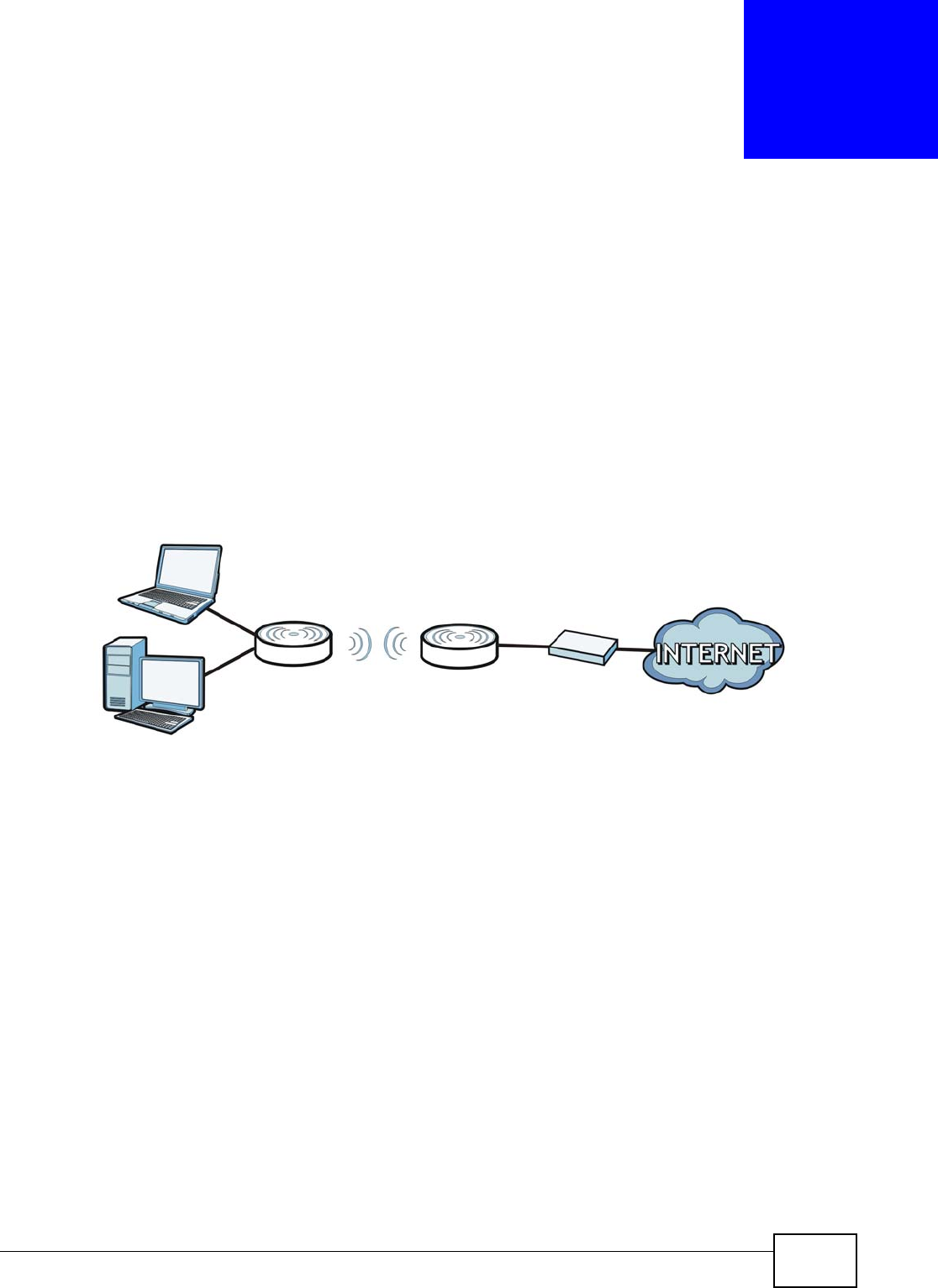
WAP5605 User’s Guide 37
CHAPTER 5
Client Mode
5.1 Overview
Your WAP5605 can act as a wireless client. In wireless client mode, it can connect to an existing
network via an access point. Use this mode if you already have a WAP5605 working as an access
point in your network.
In the example below, one WAP5605 (A) is configured as a wireless client and another is used as an
access point (B). The WAP5605 has two clients that need to connect to the Internet. The WAP5605
wirelessly connects to the available access point (B).
Figure 17 Wireless Client Mode
After the WAP5605 and the access point connect, the WAP5605 acquires its WAN IP address from
the access point. The clients of the WAP5605 can now surf the Internet.
5.2 What You Can Do
•Use the Status screen (Section 5.5 on page 39) to view read-only information about your
WAP5605.
•Use the LAN screen (Chapter 10 on page 89) to set the IP address for your WAP5605.
•Use the Wireless LAN screen (Section 5.6 on page 41) to associate your WAP5605 (acting as a
wireless client) with an existing access point.
5.3 What You Need to Know
With the exception of the Wireless LAN screens, the LAN, Monitor, and Maintenance screens in
client mode are similar to the ones in access point Mode. See Chapter 10 on page 89 through
Chapter 11 on page 93 of this User’s Guide.
AB

Chapter 5 Client Mode
WAP5605 User’s Guide
38
5.4 Setting your WAP5605 to Client Mode
1To set your WAP5605 to client mode, see Section 2.1.2.1 on page 21.
2Connect your computer to the LAN port of the WAP5605.
3The default IP address of the WAP5605 in client mode is “192.168.1.10”. In this case, your
computer must have an IP address in the range between “192.168.1.11” and “192.168.1.254”.
4Click Start > Run on your computer in Windows. Type “cmd” in the dialog box. Enter “ipconfig” to
show your computer’s IP address. If your computer’s IP address is not in the correct range then see
Appendix C on page 135 for information on changing your computer’s IP address.
5After you’ve set your computer’s IP address, open a web browser such as Internet Explorer and
type “http://192.168.1.10” as the web address in your web browser.
6Enter “1234” (default) as the password and click Login.
7Type a new password and retype it to confirm, then click Apply. Otherwise, click Ignore.
8The Easy mode appears. Click Expert Mode in the navigation panel.
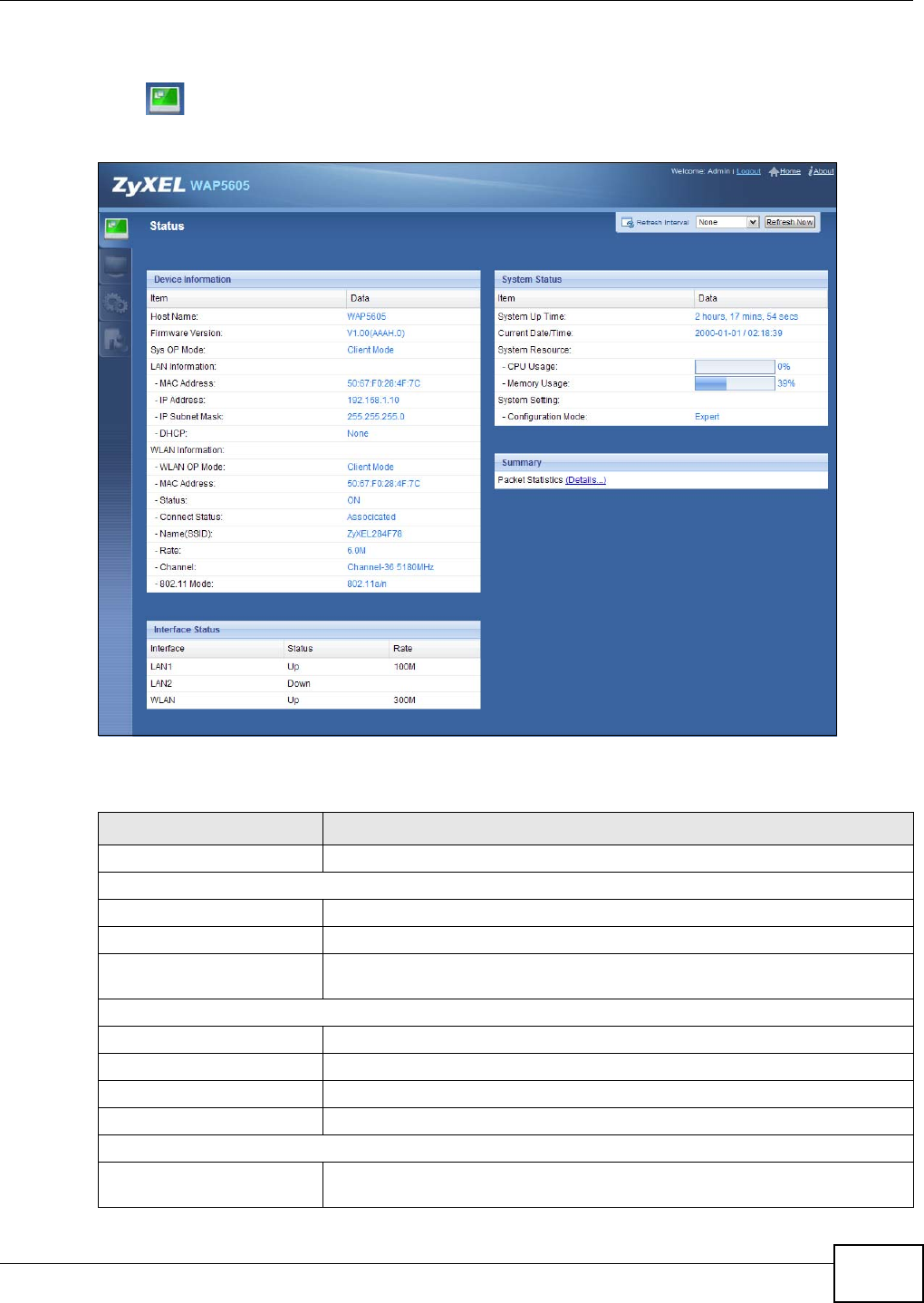
Chapter 5 Client Mode
WAP5605 User’s Guide 39
5.5 Client Mode Status Screen
Click to open the status screen.
Figure 18 Status: Client Mode
The following table describes the labels shown in the Status screen.
Table 10 Status Screen: Client Mode
LABEL DESCRIPTION
Logout Click this at any time to exit the Web Configurator.
Device Information
Host Name This is the WAP5605’s model name.
Firmware Version This is the firmware version and the date created.
Sys OP Mode This is the device operating mode (Section 2.1.2 on page 21) to which the
WAP5605 is set - Client Mode.
LAN Information
MAC Address This shows the LAN Ethernet adapter MAC Address of your device.
IP Address This shows the LAN port’s IP address.
IP Subnet Mask This shows the LAN port’s subnet mask.
DHCP This shows the LAN port’s DHCP role - Client or None.
WLAN Information
WLAN OP Mode This is the device operating mode (Section 2.1.2 on page 21) to which the
WAP5605’s wireless LAN is set - Client Mode.

Chapter 5 Client Mode
WAP5605 User’s Guide
40
MAC Address This shows the wireless adapter MAC Address of your device.
Status This shows the current status of the Wireless LAN - ON.
Connect Status This shows whether or not the WAP5605 has successfully associated with an
access point - Associated or Disassociated.
Name (SSID) This shows a descriptive name used to identify the WAP5605 in the wireless
LAN.
Rate This shows the current transmission rate.
Channel This shows the channel number used by the WAP5605 now.
802.11 Mode This shows the wireless standard.
Interface Status
Interface This displays the WAP5605 port types. The port types are: LAN and WLAN.
Status For the LAN and WAN ports, this field displays Down (line is down) or Up (line
is up or connected).
For the WLAN, it displays Up when the WLAN is enabled or Down when the
WLAN is disabled.
Rate For the LAN ports, this displays the port speed or N/A when the line is
disconnected.
For the WLAN, it displays the maximum transmission rate when the WLAN is
enabled and N/A when the WLAN is disabled.
System Status
Item This column shows the type of data the WAP5605 is recording.
Data This column shows the actual data recorded by the WAP5605.
System Up Time This is the total time the WAP5605 has been on.
Current Date/Time This field displays your WAP5605’s present date and time.
System Resource
CPU Usage This displays what percentage of the WAP5605’s processing ability is currently
used. When this percentage is close to 100%, the WAP5605 is running at full
load, and the throughput is not going to improve anymore. If you want some
applications to have more throughput, you should turn off other applications
(for example, using bandwidth management.
Memory Usage This shows what percentage of the heap memory the WAP5605 is using.
System Setting
Configuration Mode This shows the web configurator mode you are viewing - Expert.
Summary
Packet Statistics Click Details... to go to the Monitor > Packet Statistics screen (Section 8.5
on page 73). Use this screen to view port status and packet specific statistics.
Table 10 Status Screen: Client Mode
LABEL DESCRIPTION
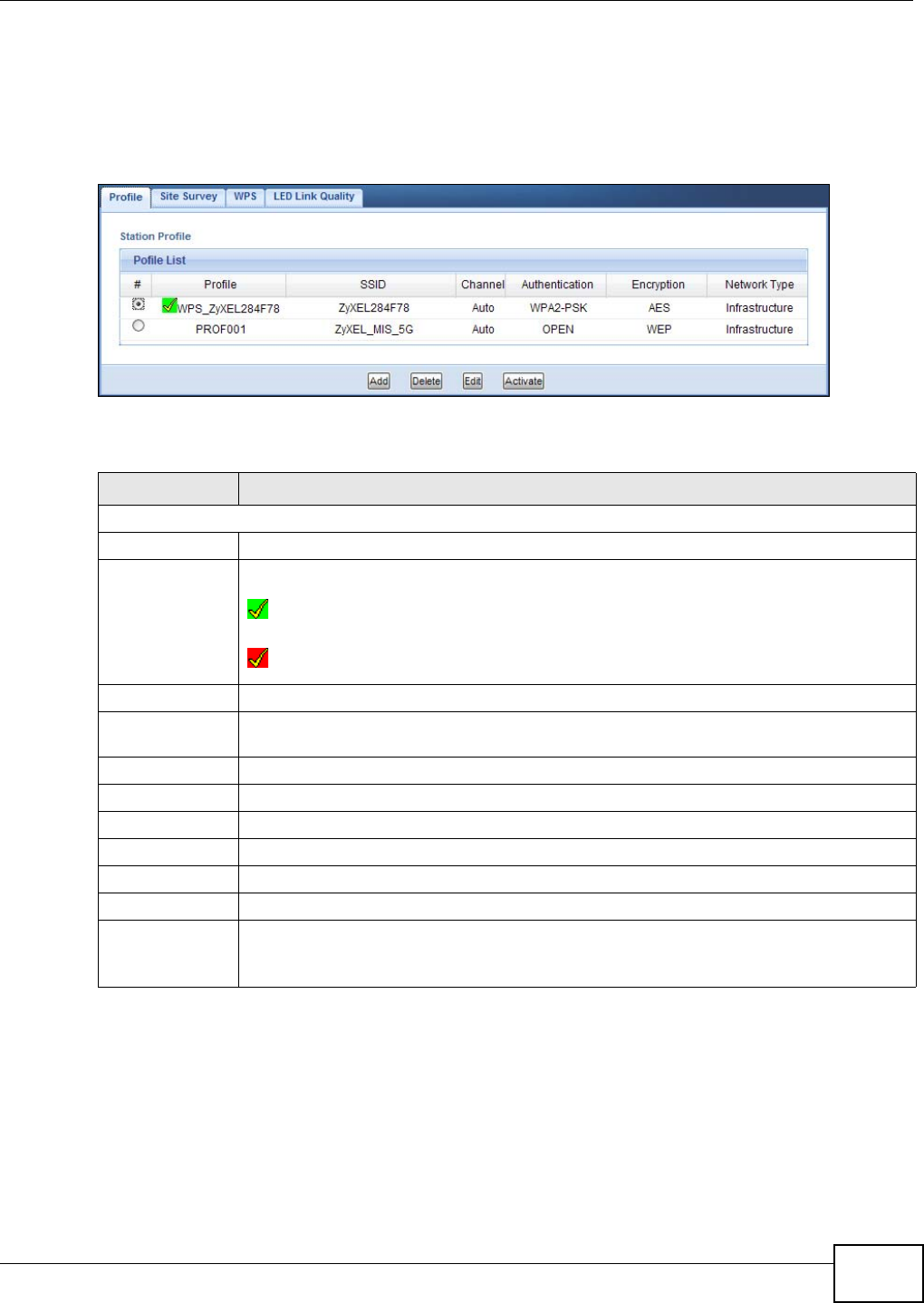
Chapter 5 Client Mode
WAP5605 User’s Guide 41
5.6 Wireless LAN Profile Screen
Use this screen to view the wireless LAN profile settings of your WAP5605. Go to Configuration >
Network > Wireless LAN > Profile to open the following screen.
Figure 19 Client Mode: WLAN > Profile
The following table describes the labels in this screen.
Table 11 Client Mode: WLAN > Profile
LABEL DESCRIPTION
Profile List
# Select a profile to remove, modify or enable it.
Profile This displays the name of the pre-configured profile.
indicates the profile is activated and the WAP5605 connects to the specified wireless
network.
indicates the profile is activated but the specified wireless network is not available or
the WAP5605 fails to associate with the wireless network.
SSID This displays the SSID of the wireless network with which this profile associates.
Channel This displays the channel number used by this profile. Auto means the WAP5605
automatically scans for and selects an available channel.
Authentication This displays the authentication method used by this profile.
Encryption This displays the data encryption method used by this profile.
Network Type This displays the network type (Infrastructure or Ad Hoc) of this profile.
Add Click this button to create a new profile.
Delete Select a profile and click this button to remove it.
Edit Select a profile and click this button to modify it.
Activate Select a profile and click this button to enable it.
Note: You can activate only one profile at a time.
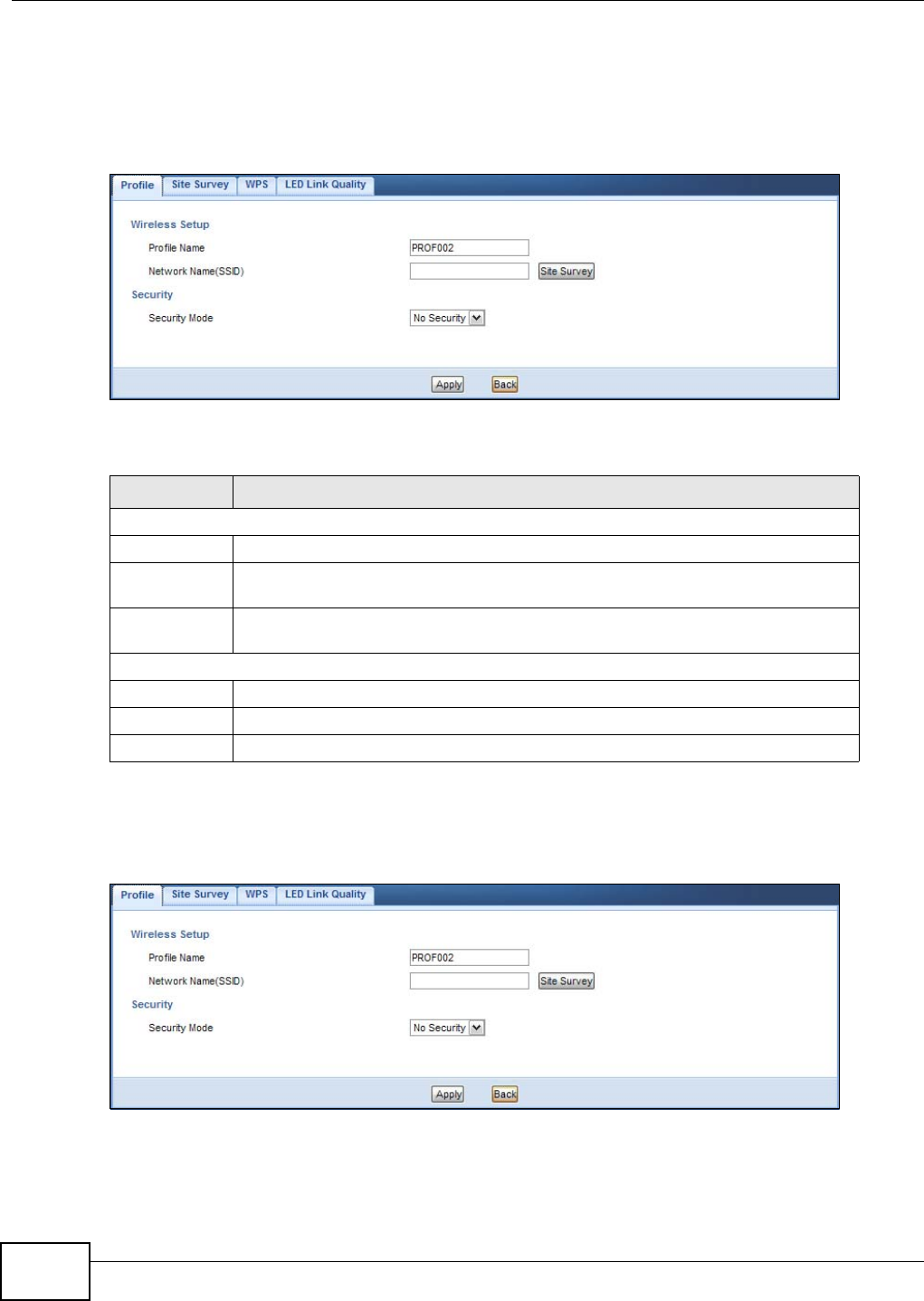
Chapter 5 Client Mode
WAP5605 User’s Guide
42
5.6.1 Adding a New WLAN Profile
Use this screen to create a new wireless LAN profile for your WAP5605. Click the Add button in the
Configuration > Network > Wireless LAN > Profile screen to open the following screen.
Figure 20 Client Mode: WLAN > Profile > Add
The following table describes the labels in this screen.
5.6.1.1 No Security
Use this screen if the access point to which you want to connect does not use encryption.
Figure 21 Client Mode: WLAN > Profile: No Security
Table 12 Client Mode: WLAN > Profile > Add
LABEL DESCRIPTION
Wireless Setup
Profile Name Enter a descriptive name for this profile.
Network Name
(SSID)
Enter the name of the access point to which you are connecting.
Site Survey Click this button to go to the Site Survey screen and see available wireless devices
within range.
Security
Security Mode Select the security mode of the access point to which you want to connect.
Apply Click Apply to save your changes back to the WAP5605.
Back Click Back to go back to the previous screen.
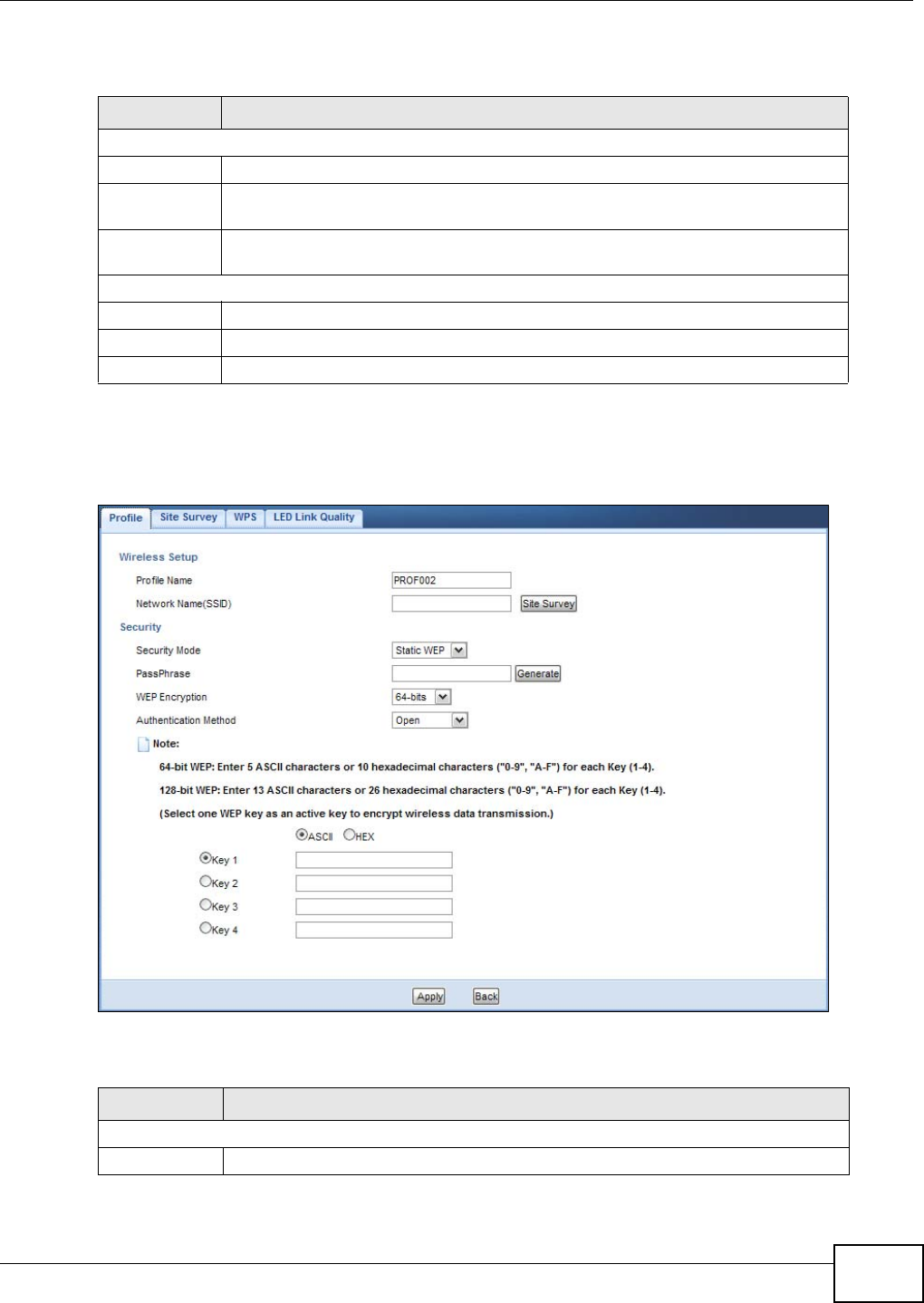
Chapter 5 Client Mode
WAP5605 User’s Guide 43
The following table describes the labels in this screen.
5.6.1.2 Static WEP
Use this screen if the access point to which you want to connect to uses WEP security mode.
Figure 22 Client Mode: WLAN > Profile: WEP
The following table describes the labels in this screen..
Table 13 Client Mode: WLAN > Profile: No Security
LABEL DESCRIPTION
Wireless Setup
Profile Name Enter a descriptive name for this profile.
Network Name
(SSID)
Enter the name of the access point to which you are connecting.
Site Survey Click this button to go to the Site Survey screen and see available wireless devices
within range.
Security
Security Mode Select No Security in this field.
Apply Click Apply to save your changes back to the WAP5605.
Back Click Back to go back to the previous screen.
Table 14 Client Mode: WLAN > Profile: WEP
LABEL DESCRIPTION
Wireless Setup
Profile Name Enter a descriptive name for this profile.

Chapter 5 Client Mode
WAP5605 User’s Guide
44
Network Name
(SSID)
Enter the name of the access point to which you are connecting.
Site Survey Click this button to go to the Site Survey screen and see available wireless devices
within range.
Security
Security Mode Select Static WEP to enable data encryption.
PassPhrase Enter a passphrase (up to 26 printable characters) and click Generate.
A passphrase functions like a password. In WEP security mode, it is further
converted by the WAP5605 into a complicated string that is referred to as the “key”.
This key is requested from all devices wishing to connect to a wireless network.
WEP
Encryption
Select 64-bits or 128-bits.
This dictates the length of the security key that the network is going to use.
Authentication
Method
Select Open or Shared Key from the drop-down list box.
This field specifies whether the wireless clients have to provide the WEP key to log
into the wireless network. Keep this setting at Open unless you want to force a key
verification before communication between the wireless client and the ZyXEL Device
occurs.
Select Shared Key to force the clients to provide the WEP key prior to
communication.
ASCII Select this option in order to enter ASCII characters as WEP key.
Hex Select this option in order to enter hexadecimal characters as a WEP key.
The preceding "0x", that identifies a hexadecimal key, is entered automatically.
Key 1 to Key 4 The WEP keys are used to encrypt data. Both the WAP5605 and the wireless
stations must use the same WEP key for data transmission.
If you chose 64-bits, then enter any 5 ASCII characters or 10 hexadecimal
characters ("0-9", "A-F").
If you chose 128-bits, then enter 13 ASCII characters or 26 hexadecimal
characters ("0-9", "A-F").
You must configure at least one key, only one key can be activated at any one time.
The default key is key 1.
Apply Click Apply to save your changes back to the WAP5605.
Back Click Back to go back to the previous screen.
Table 14 Client Mode: WLAN > Profile: WEP
LABEL DESCRIPTION
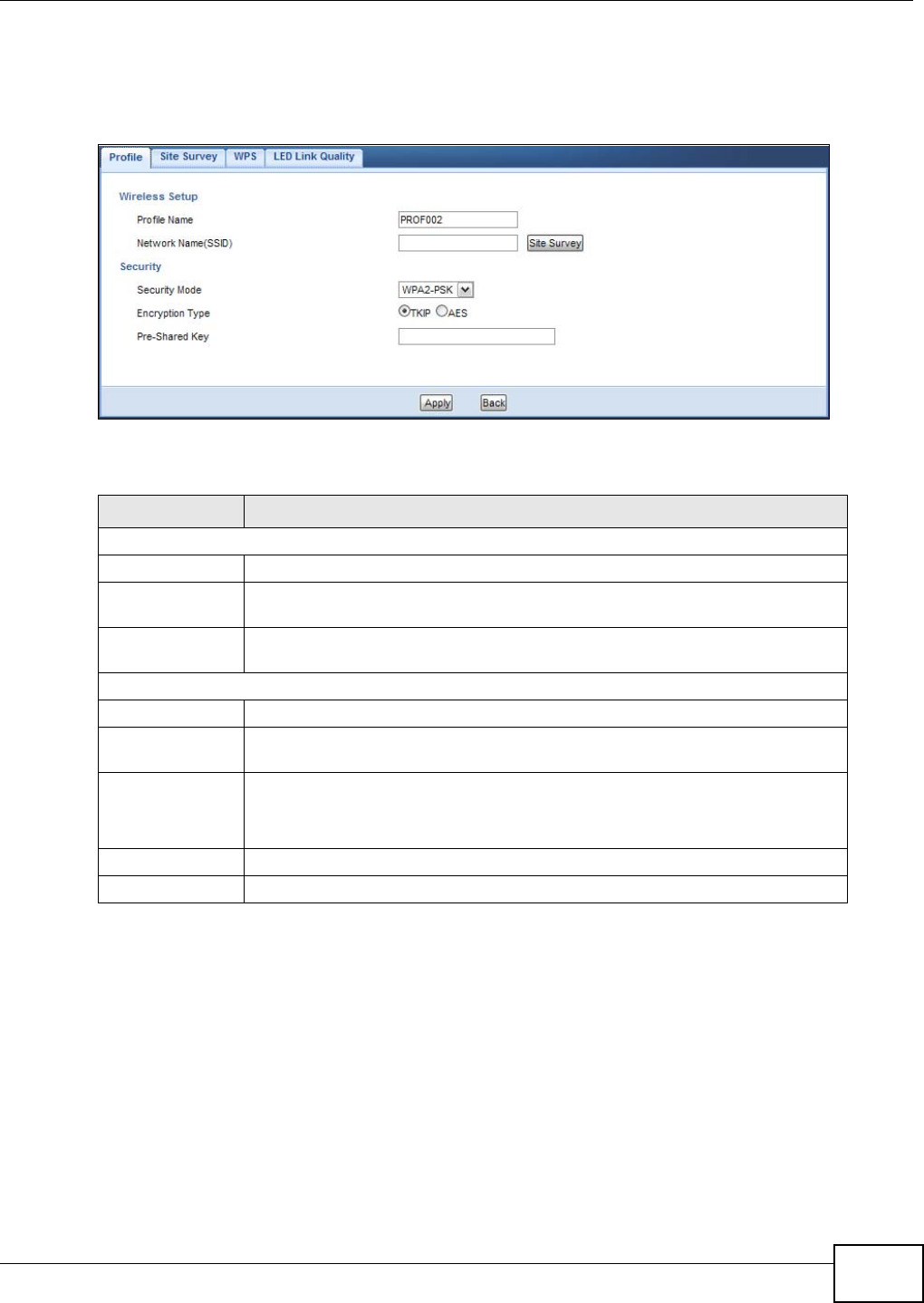
Chapter 5 Client Mode
WAP5605 User’s Guide 45
5.6.1.3 WPA(2)-PSK
Use this screen if the access point to which you want to connect uses WPA(2)-PSK security mode.
Figure 23 Client Mode: WLAN > Profile: WPA-PSK/WPA2-PSK
The following table describes the labels in this screen.
Table 15 Client Mode: WLAN > Profile: WPA-PSK/WPA2-PSK
LABEL DESCRIPTION
Wireless Setup
Profile Name Enter a descriptive name for this profile.
Network Name
(SSID)
Enter the name of the access point to which you are connecting.
Site Survey Click this button to go to the Site Survey screen and see available wireless
devices within range.
Security
Security Mode Select WPA-PSK or WPA2-PSK to add strong security on this wireless network.
Encryption Type Select the type of wireless encryption employed by the access point to which you
want to connect.
Pre-Shared Key WPA-PSK or WPA2-PSK uses a simple common password for authentication.
Type the pre-shared key employed by the access point to which you want to
connect.
Apply Click Apply to save your changes back to the WAP5605.
Back Click Back to go back to the previous screen.
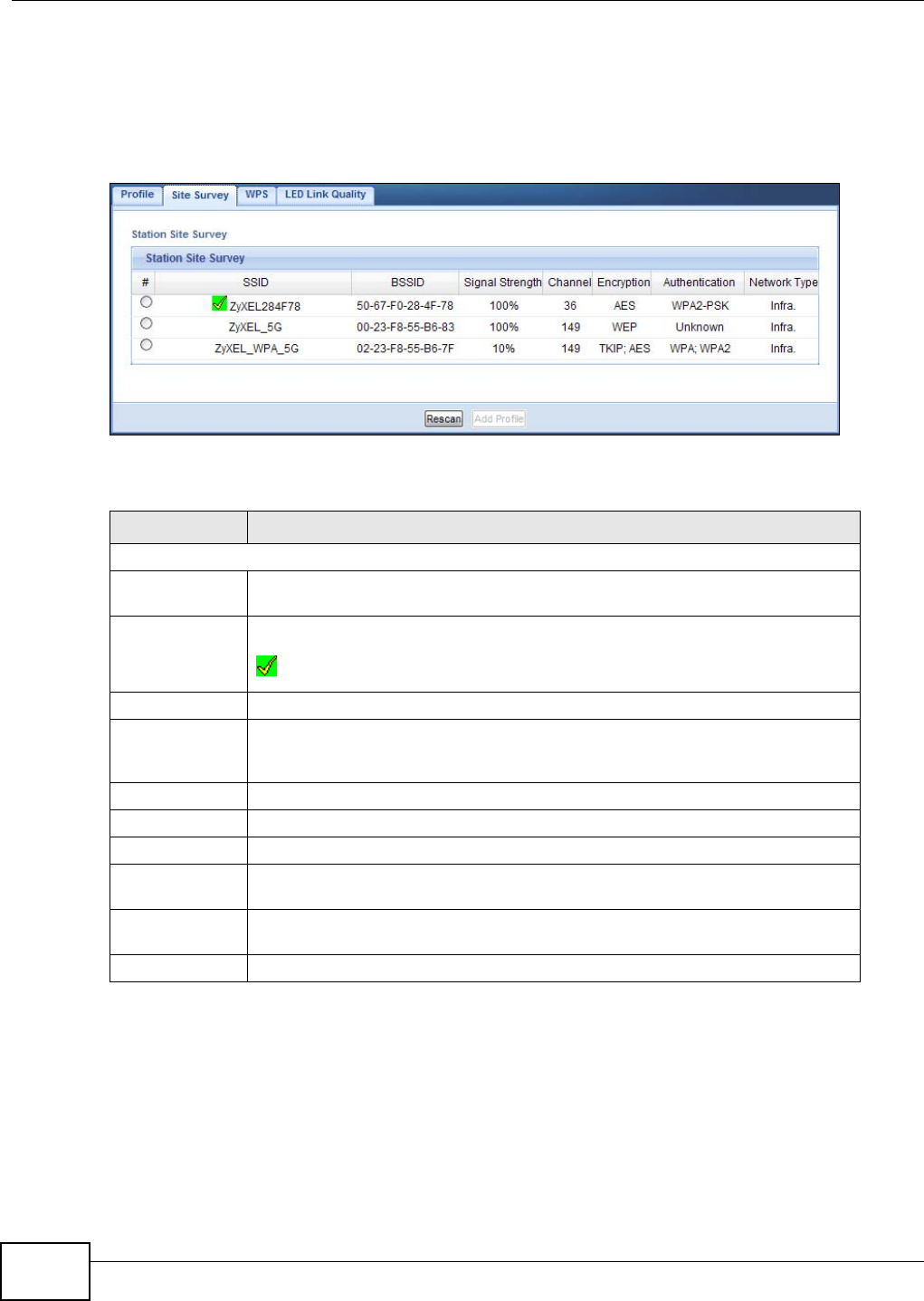
Chapter 5 Client Mode
WAP5605 User’s Guide
46
5.7 Site Survey Screen
Use this screen to scan for and connect to a wireless network automatically. Go to Configuration >
Wireless LAN > Site Survey to open the following screen.
Figure 24 Client Mode: WLAN > Site Survey
The following table describes the labels in this screen.
Table 16 Client Mode: WLAN > Site Survey
LABEL DESCRIPTION
Station Site Survey
# Select a wireless device and click Add Profile to open a configuration screen
where you can add the selected wireless device to a profile and then enable it.
SSID This displays the SSID of the wireless device.
indicates the wireless device is added to an activated profile and the
WAP5605 is connecting to it.
BSSID This displays the MAC address of the wireless device.
Signal Strength This displays the strength of the wireless signal. The signal strength mainly
depends on the antenna output power and the distance between your WAP5605
and this device.
Channel This displays the channel number used by this wireless device.
Encryption This displays the data encryption method used by this wireless device.
Authentication This displays the authentication method used by this wireless device.
Network Type This displays the network type (Infrastructure or Ad Hoc) of this wireless
device.
Rescan Click this button to search for available wireless devices within transmission range
and update this table.
Add Profile Select a wireless device and click this button to add it to a profile.
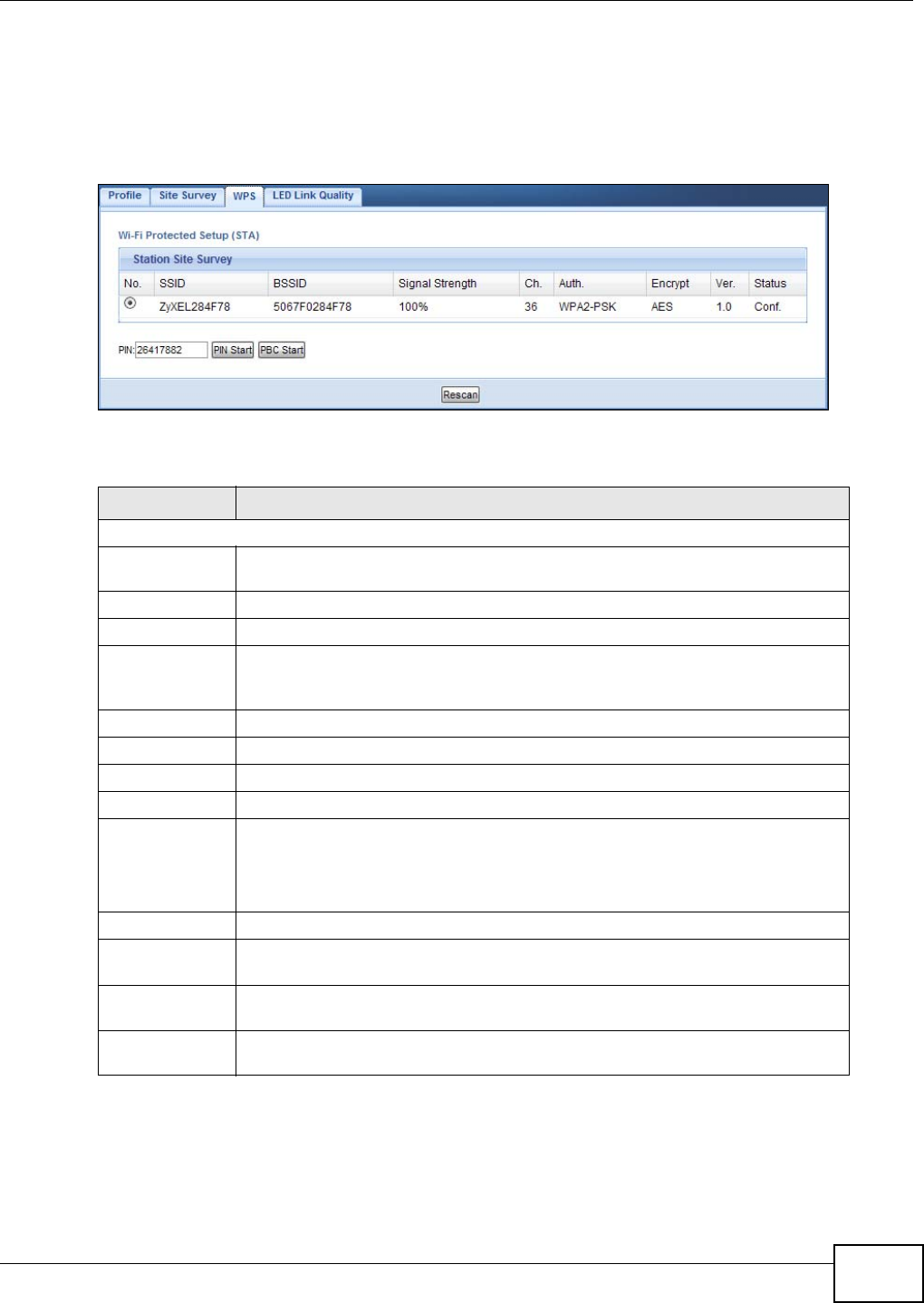
Chapter 5 Client Mode
WAP5605 User’s Guide 47
5.8 WPS Screen
Use this screen to enable Wi-Fi Protected Setup (WPS) on the WAP5605. Go to Configuration >
Wireless LAN > WPS to open the following screen.
Figure 25 Client Mode: WLAN > WPS
The following table describes the labels in this screen.
Table 17 Client Mode: WLAN > WPS
LABEL DESCRIPTION
Station Site Survey
No. Use the radio button to select the wireless device to which you want to connect
using WPS.
SSID This displays the SSID of the wireless device.
BSSID This displays the MAC address of the wireless device.
Signal Strength This displays the strength of the wireless signal. The signal strength mainly
depends on the antenna output power and the distance between your WAP5605
and this device.
Ch. This displays the channel number used by this wireless device.
Auth. This displays the authentication method used by this wireless device.
Encrypt This displays the data encryption method used by this wireless device.
Ver. This displays the firmware version running on the wireless device.
Status This displays Conf. (configured) when WPS has been set up on the wireless
device.
This displays Unconf. (unconfigured) if WPS has not been set up on the wireless
device.
PIN This displays the PIN number of the WAP5605.
PIN Start Click this button to perform wireless security information synchronization using
the PIN configuration method.
PBC Start Click this button to perform wireless security information synchronization using
the Push Button Configuration (PBC) method.
Rescan Click this button to search for available for WPS-enabled devices within
transmission range and update this table.
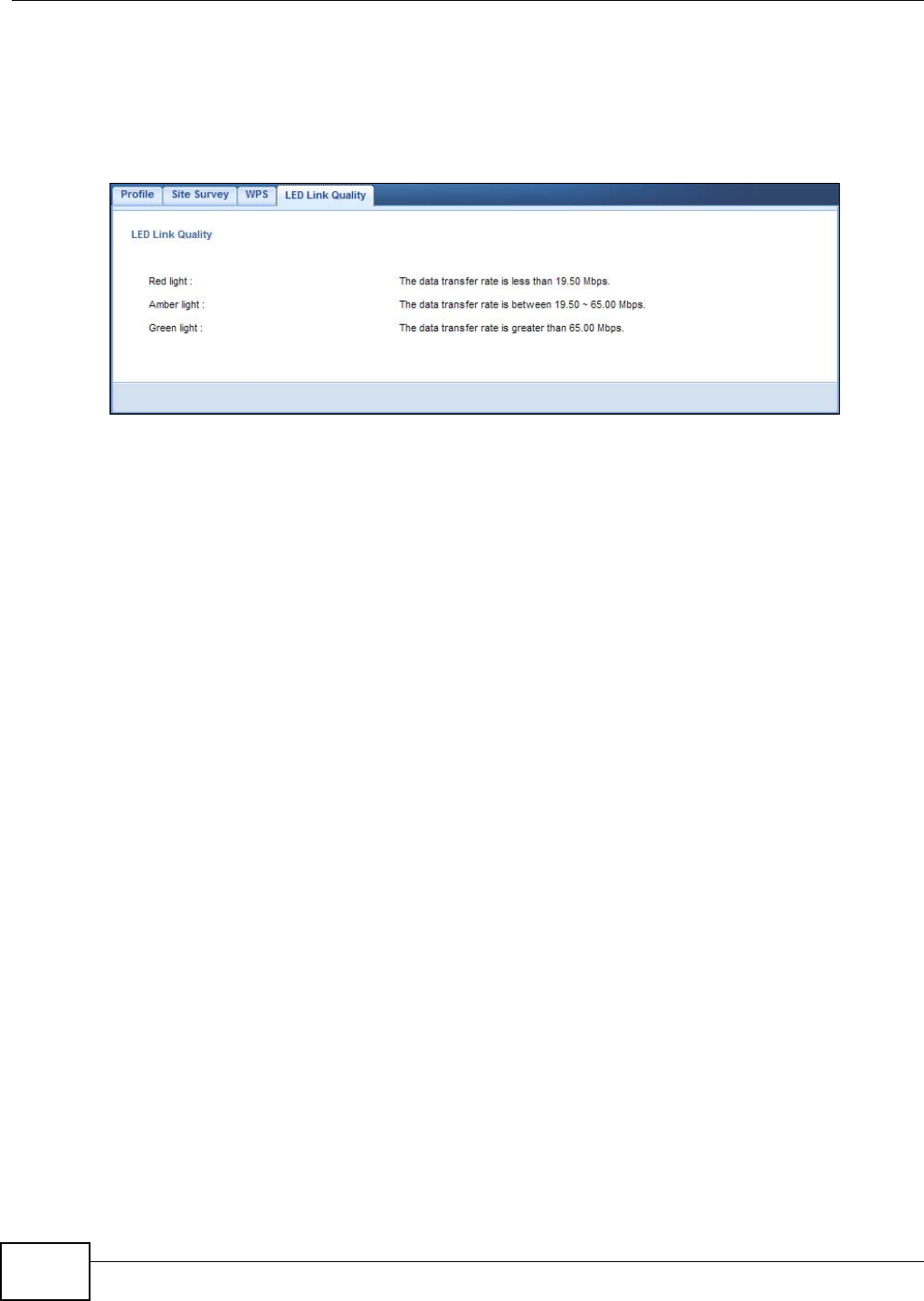
Chapter 5 Client Mode
WAP5605 User’s Guide
48
5.9 LED Link Quality Screen
Use this screen to view the threshold for each color of the quality LED on the WAP5605. Go to
Configuration > Wireless LAN > LED Link Quality to open the following screen.
Figure 26 Client Mode: WLAN > LED Link Quality

WAP5605 User’s Guide 49
CHAPTER 6
The Web Configurator
6.1 Overview
This chapter describes how to access the WAP5605 Web Configurator and provides an overview of
its screens.
The Web Configurator is an HTML-based management interface that allows easy setup and
management of the WAP5605 via Internet browser. Use Internet Explorer 6.0 and later or Firefox
2.0 and later versions. The recommended screen resolution is 1024 by 768 pixels.
In order to use the Web Configurator you need to allow:
• Web browser pop-up windows from your device. Web pop-up blocking is enabled by default in
Windows XP SP (Service Pack) 2.
• JavaScripts (enabled by default).
• Java permissions (enabled by default).
Refer to the Troubleshooting chapter (Chapter 12 on page 101) to see how to make sure these
functions are allowed in Internet Explorer.
6.2 Accessing the Web Configurator
1Connect your computer to the LAN port of the WAP5605.
2The default IP address of the WAP5605 in access point mode is “192.168.1.2”. In this case, your
computer must have an IP address in the range between “192.168.1.3” and “192.168.1.254”.
3Click Start > Run on your computer in Windows. Type “cmd” in the dialog box. Enter “ipconfig” to
show your computer’s IP address. If your computer’s IP address is not in the correct range then see
Appendix C on page 135 for information on changing your computer’s IP address.
4After you’ve set your computer’s IP address, open a web browser such as Internet Explorer and
type “http://192.168.1.2” as the web address in your web browser.
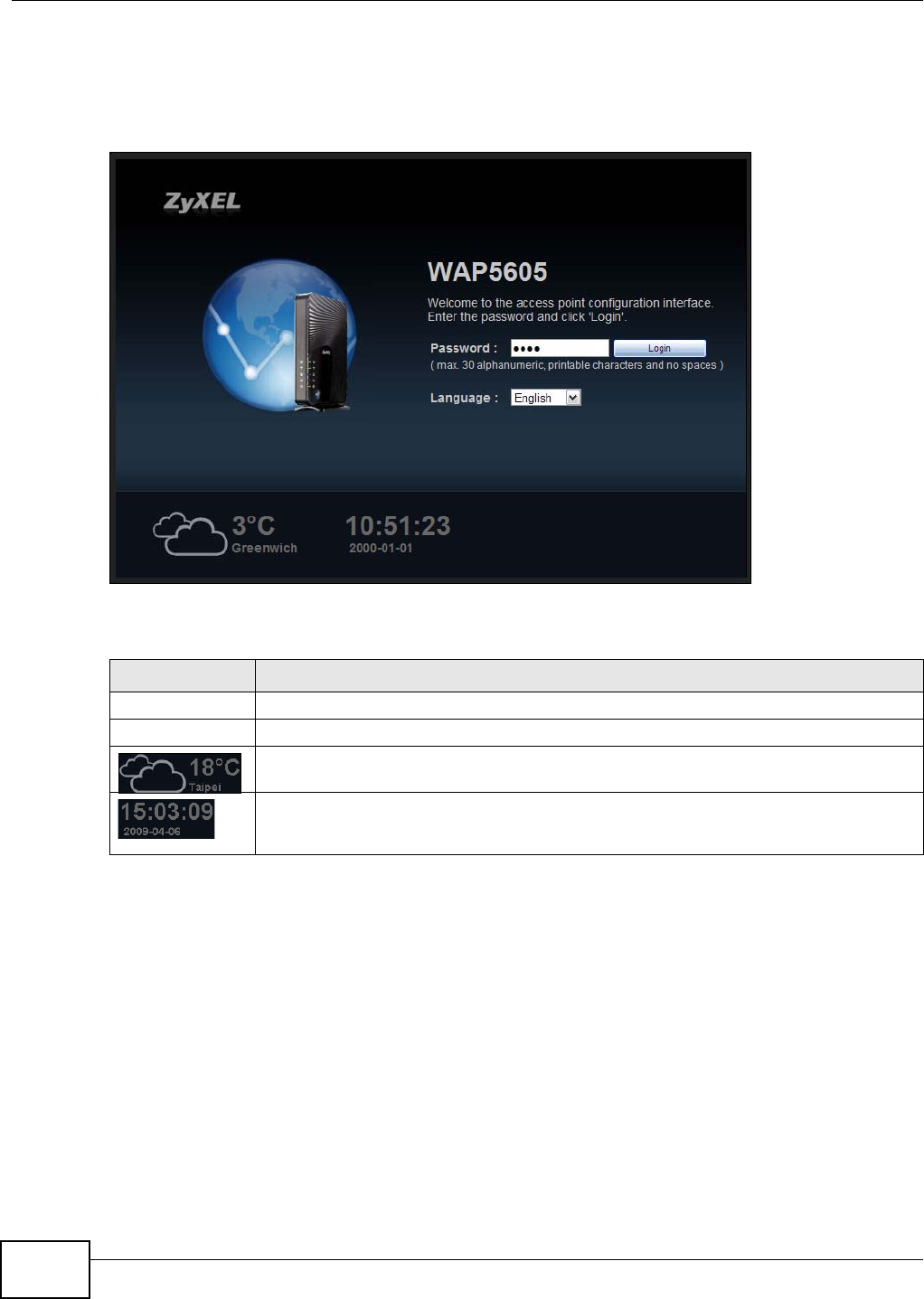
Chapter 6 The Web Configurator
WAP5605 User’s Guide
50
6.2.1 Login Screen
The Web Configurator initially displays the following login screen.
Figure 27 Login screen
The following table describes the labels in this screen.
Table 18 Login screen
LABEL DESCRIPTION
Password Type "1234" (default) as the password.
Language Select the language you want to use to configure the Web Configurator. Click Login.
This shows the current weather, either in celsius or fahrenheit, of the city you specify in
Section 6.2.3.1 on page 52.
This shows the time (hh:mm:ss) and date (yyyy:mm:dd) of the timezone you select in
Section 6.2.3.2 on page 53 or Section 11.5 on page 95. The time is in 24-hour format, for
example 15:00 is 3:00 PM.
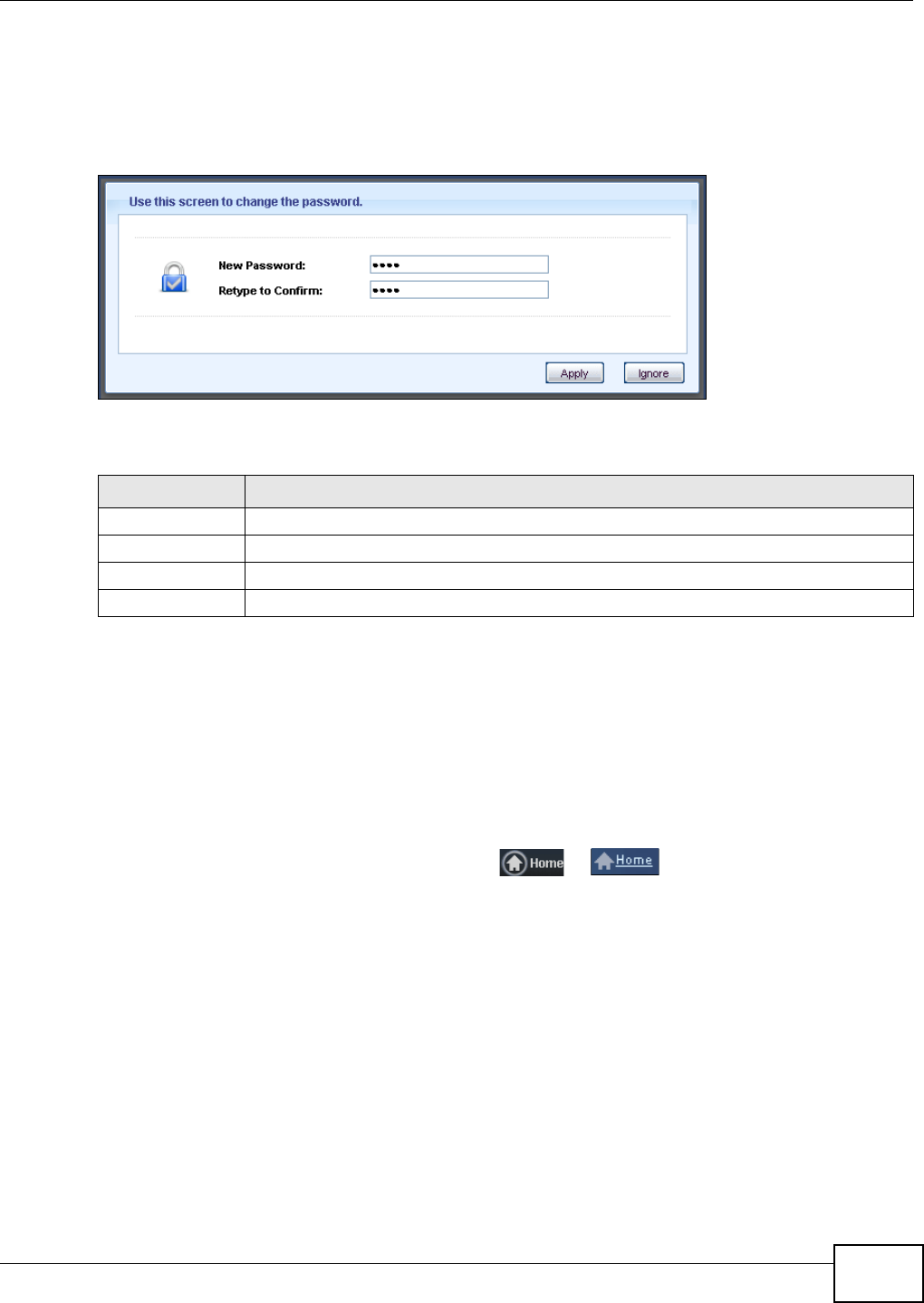
Chapter 6 The Web Configurator
WAP5605 User’s Guide 51
6.2.2 Password Screen
You should see a screen asking you to change your password (highly recommended) as shown
next.
Figure 28 Change Password Screen
The following table describes the labels in this screen.
Note: The management session automatically times out when the time period set in the
Administrator Inactivity Timer field expires (default five minutes; go to Chapter
11 on page 93 to change this). Simply log back into the WAP5605 if this happens.
6.2.3 Home Screen
If you have previously logged into the Web Configurator but did not click Logout, you may be
redirected to the Home screen.
You can also open this screen by clicking Home ( or ) in the Easy Mode or Expert
Mode screens.
Table 19 Change Password Screen
LABEL DESCRIPTION
New Password Type a new password.
Retype to Confirm Retype the password for confirmation.
Apply Click Apply to save your changes back to the WAP5605.
Ignore Click Ignore if you do not want to change the password this time.
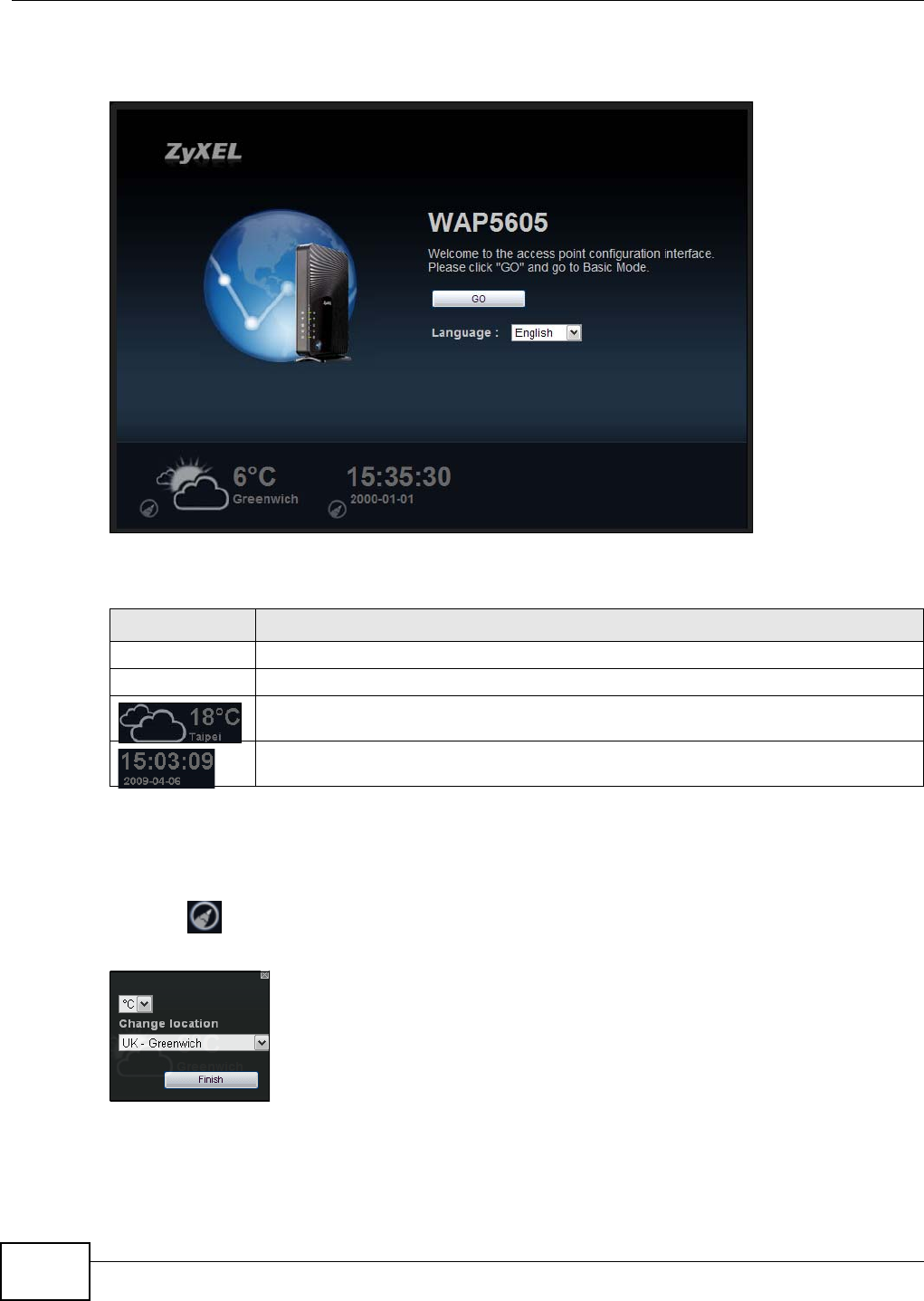
Chapter 6 The Web Configurator
WAP5605 User’s Guide
52
The Home screen displays as follows.
Figure 29 Home Screen
The following table describes the labels in this screen.
6.2.3.1 Weather Edit
You can change the temperature unit and select the location for which you want to know the
weather.
Click the icon to change the weather display.
Figure 30 Change Weather
Table 20 Home Screen
LABEL DESCRIPTION
Go Click this to open the Easy mode Web Configurator.
Language Select a language to go to the Easy mode Web Configurator in that language and click Go.
(This is just an example). This shows the current weather, either in celsius or fahrenheit,
of the city you specify in Section 6.2.3.1 on page 52.
(This is just an example). This shows the time (hh:mm:ss) and date (yyyy:mm:dd) of the
timezone you select in Section 6.2.3.2 on page 53 or Section 11.5 on page 95.
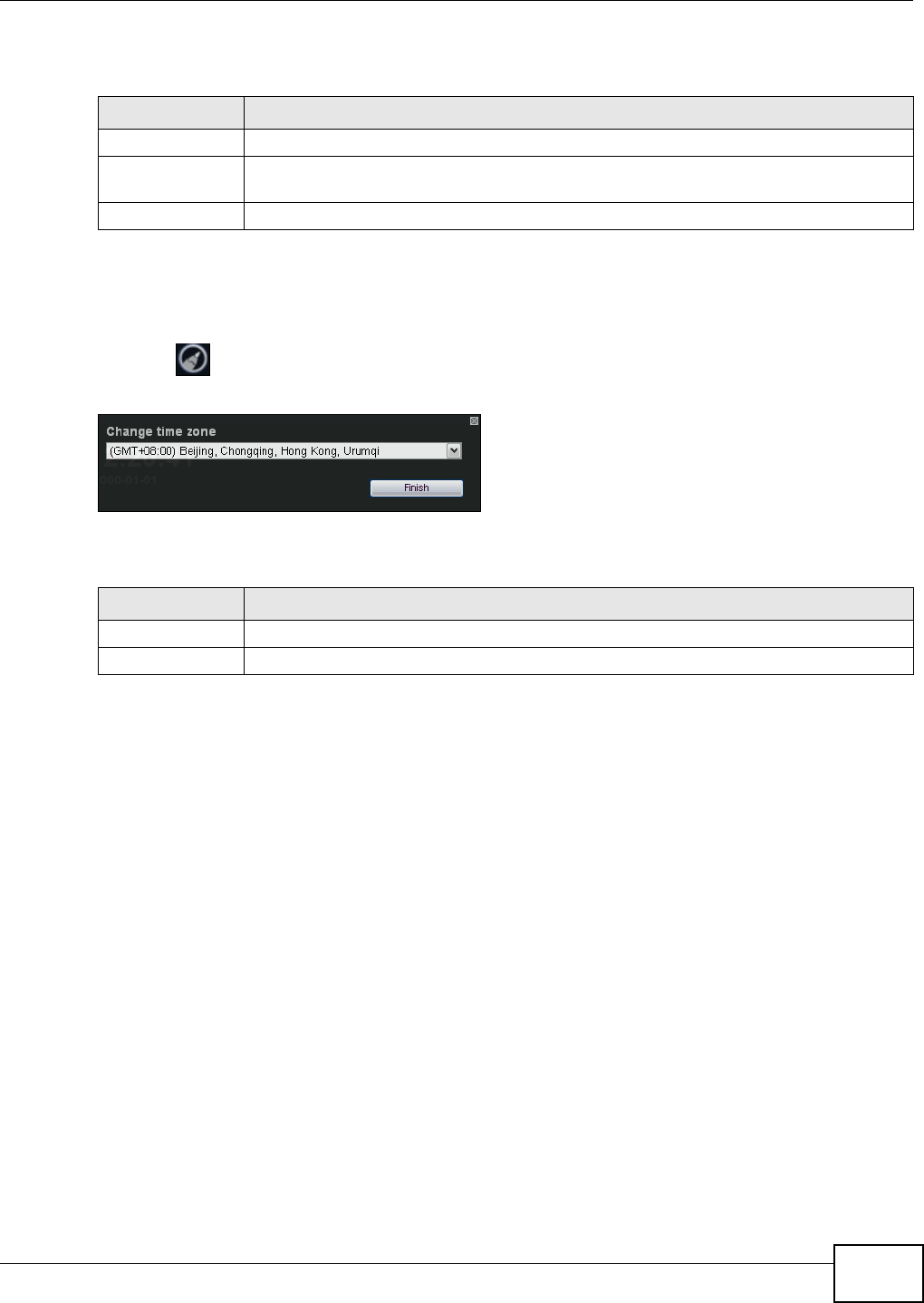
Chapter 6 The Web Configurator
WAP5605 User’s Guide 53
The following table describes the labels in this screen.
6.2.3.2 Time/Date Edit
One timezone can cover more than one country. You can choose a particular country in which the
WAP5605 is located and have the WAP5605 display and use the current time and date for its logs.
Click the icon to change the time and date display.
Figure 31 Change Time Zone
The following table describes the labels in this screen.
Note: You can also edit the timezone in Section 11.5 on page 95.
Table 21 Change Weather
LABEL DESCRIPTION
oC or oF Choose which temperature unit you want the WAP5605 to display.
Change Location Select the location for which you want to know the weather. If the city you want is not
listed, choose one that is closest to it.
Finish Click this to apply the settings and refresh the date and time display.
Table 22 Change Time Zone
LABEL DESCRIPTION
Change time zone Select the specific country whose current time and date you want the WAP5605 to display.
Finish Click this to apply the settings and refresh the weather display.

Chapter 6 The Web Configurator
WAP5605 User’s Guide
54
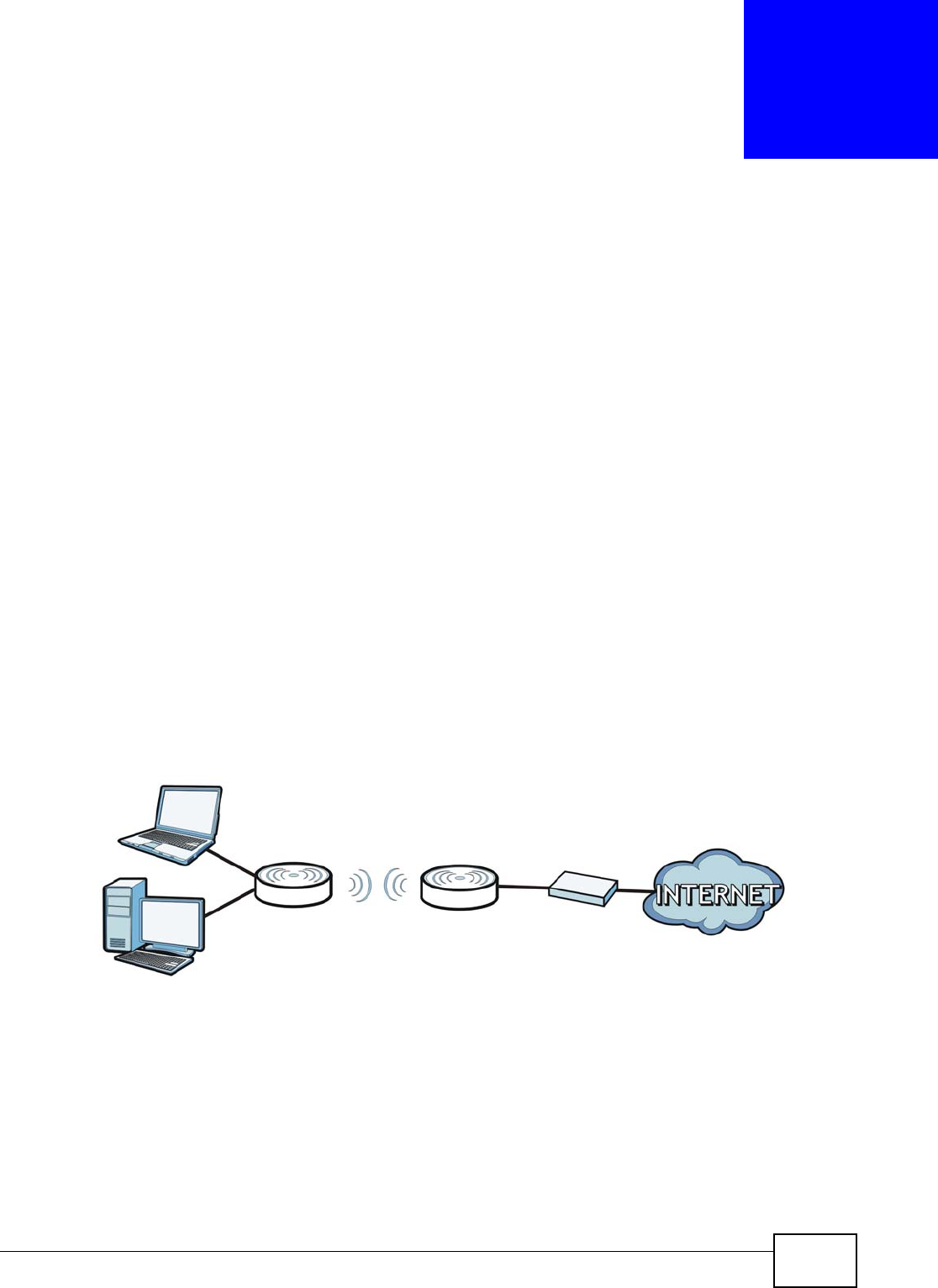
WAP5605 User’s Guide 55
CHAPTER 7
Tutorials
7.1 Overview
This chapter provides tutorials for your WAP5605 (in access point mode) as follows:
•Connecting to the Internet from an Access Point
•Configuring Wireless Security Using WPS
•Enabling and Configuring Wireless Security (No WPS)
•Using Multiple SSIDs on the WAP5605
This chapter provides tutorials for your WAP5605 (in client mode) as follows:
•Connecting the WAP5605 (in Client Mode) to an AP
7.2 Connecting to the Internet from an Access Point
This section gives you an example of how to set up an access point (A) and wireless client (B in this
example) for wireless communication. Computers that connect to B can access the Internet
through the access point wirelessly.
Figure 32 Wireless Access Point Connection to the Internet
7.3 Configuring Wireless Security Using WPS
This section gives you an example of how to set up wireless network using WPS. This example uses
the WAP5605 in AP mode as the AP and WAP5605 in client mode as the wireless client which
connects to a notebook.
A
B

Chapter 7 Tutorials
WAP5605 User’s Guide
56
There are two WPS methods for creating a secure connection. This tutorial shows you how to do
both.
•Push Button Configuration (PBC) - create a secure wireless network simply by pressing a
button. See Section 7.3.1 on page 56.This is the easier method.
•PIN Configuration - create a secure wireless network simply by entering a wireless client's PIN
(Personal Identification Number) in the WAP5605’s interface. See Section 7.3.2 on page 57. This
is the more secure method, since one device can authenticate the other.
7.3.1 Push Button Configuration (PBC)
1Make sure that your WAP5605s are turned on and that they are within range of each other.
2Make sure the WPS ( ) buttons of both WAP5605s are on.
3Press the WPS buttons for more than three seconds. The WPS LEDs blink.
Note: It doesn’t matter which button is pressed first. You must press the second button
within two minutes of pressing the first one.
Note: Your WAP5605 has a WPS button located on its panel, as well as a WPS button in
its Web Configurator. Both buttons have exactly the same function; you can also
log into the Web Configurator and press the Push Button in the AP’s
Configuration > Network > Wireless LAN > WPS Station screen and the PBC
Start button in the client’s Configuration > Network > Wireless LAN > WPS
screen.
The AP sends the proper configuration settings to the wireless client. This may take up to two
minutes. Then the wireless client is able to communicate with the AP securely.
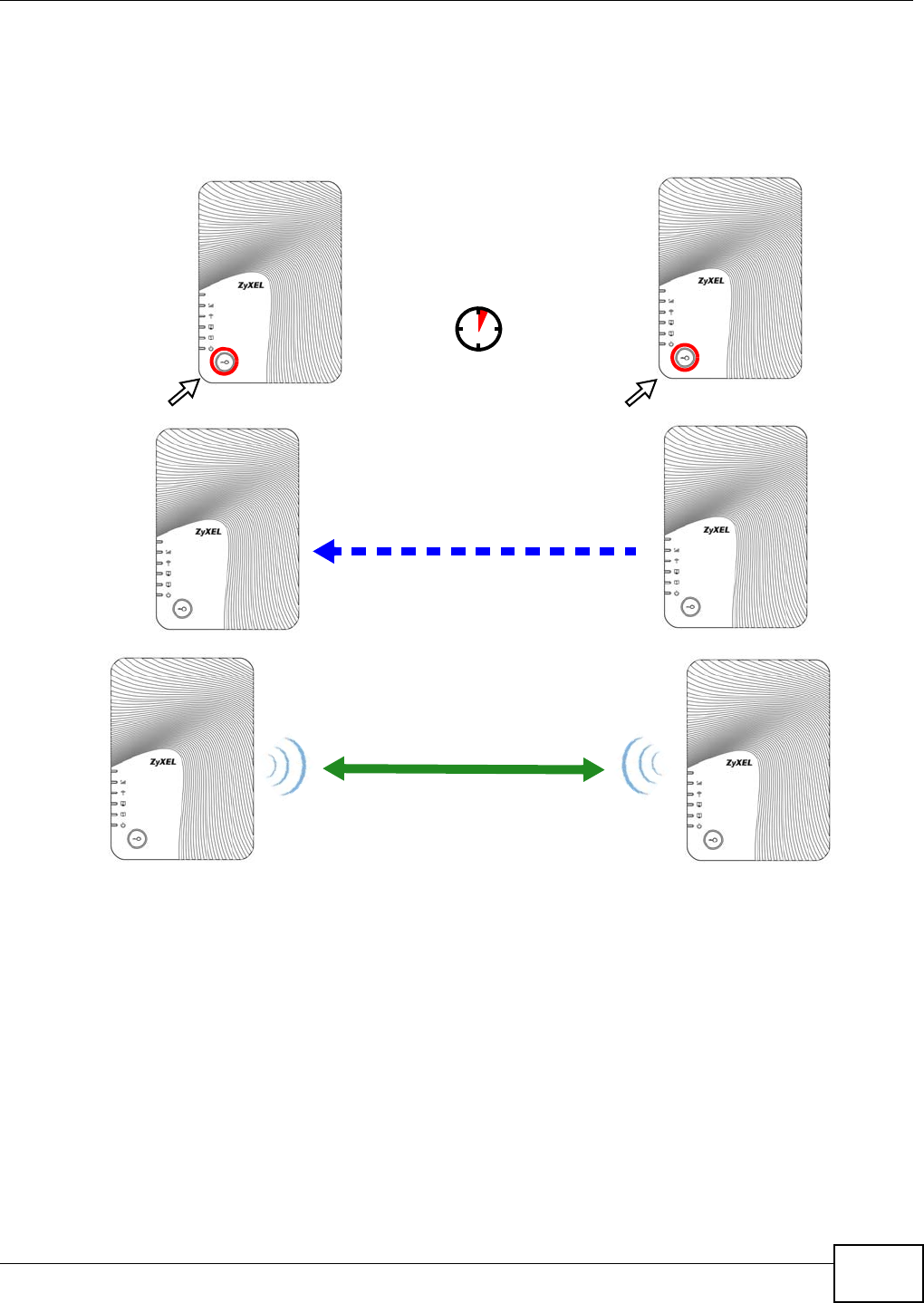
Chapter 7 Tutorials
WAP5605 User’s Guide 57
The following figure shows you how to set up wireless network and security by pressing a button on
both AP and wireless client.
Figure 33 Example WPS Process: PBC Method
7.3.2 PIN Configuration
When you use the PIN configuration method, you need to use configuration interfaces of both AP
and client.
1Log into the client’s Web Configurator. Go to the Configuration > Network > Wireless LAN >
WPS screen to get a PIN number.
2Log into the AP’s Web Configurator. Enter the client’s PIN number to the PIN field in the
Configuration > Network > Wireless LAN > WPS Station screen.
3Click the PIN Start button in the client’s WPS screen and the start button in the AP’s WPS
Station screen within two minutes.
Client
SECURITY INFO
COMMUNICATION
WITHIN 2 MINUTES
AP
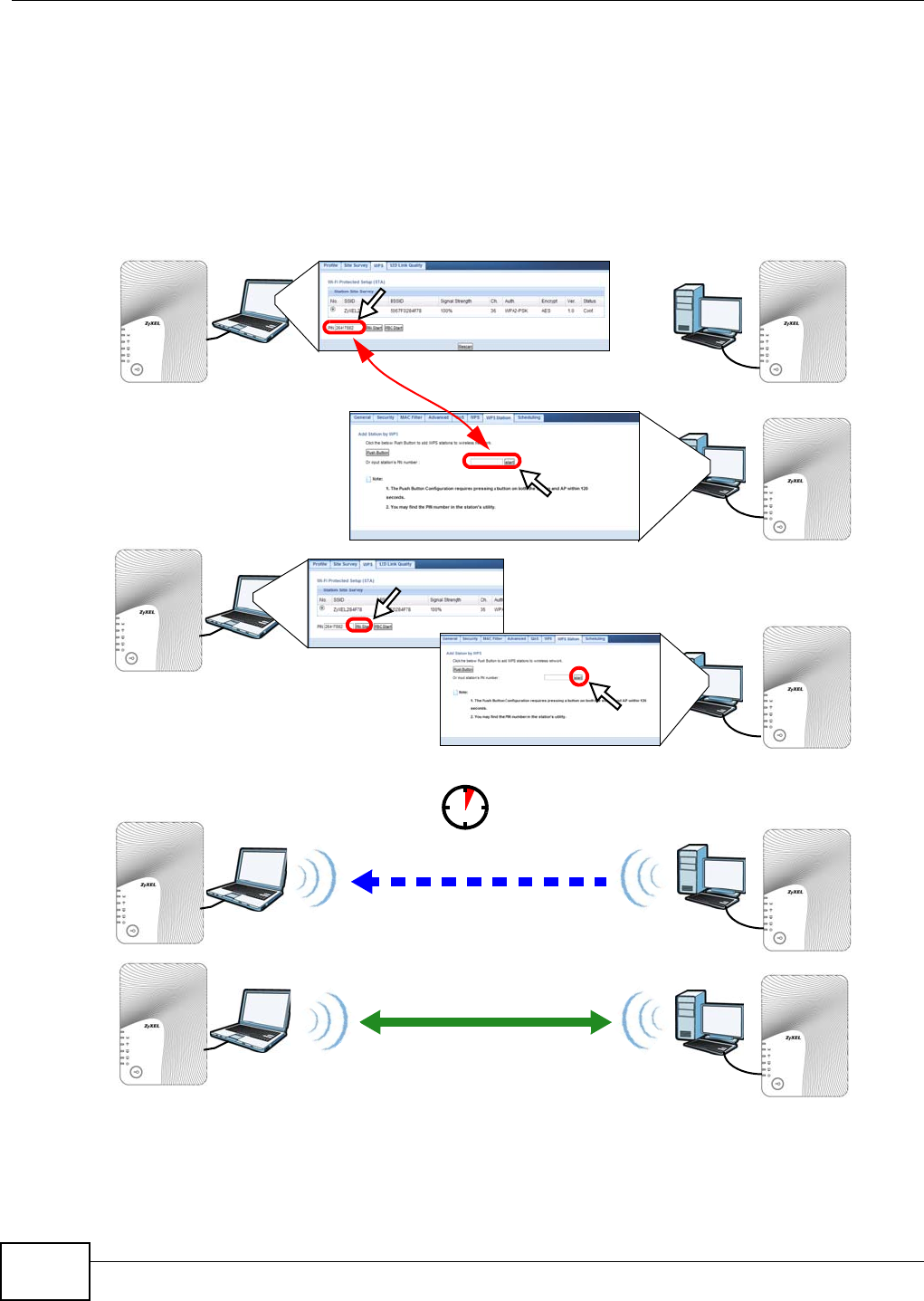
Chapter 7 Tutorials
WAP5605 User’s Guide
58
The AP authenticates the wireless client and sends the proper configuration settings to the wireless
client. This may take up to two minutes. Then the wireless client is able to communicate with the AP
securely.
The following figure shows you how to set up wireless network and security on AP and wireless
client by using PIN method.
Figure 34 Example WPS Process: PIN Method
Authentication by PIN
SECURITY INFO
WITHIN 2 MINUTES
Client
COMMUNICATION
AP
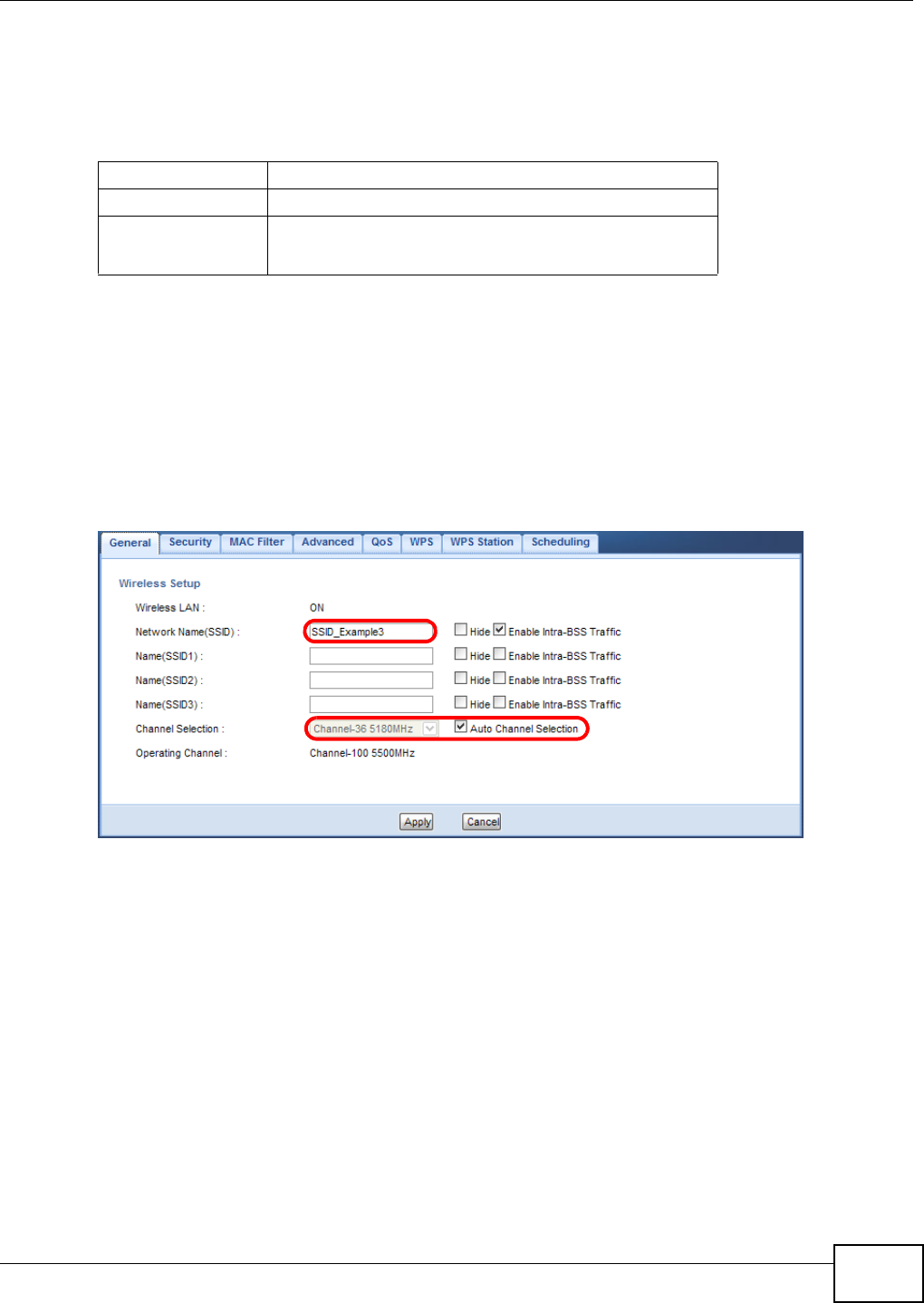
Chapter 7 Tutorials
WAP5605 User’s Guide 59
7.4 Enabling and Configuring Wireless Security (No WPS)
This example shows you how to configure wireless security settings with the following parameters
on your WAP5605.
Follow the steps below to configure the wireless settings on your WAP5605.
The instructions require that your hardware is connected (see the Quick Start Guide) and you are
logged into the Web Configurator through your LAN connection (see Section 6.2 on page 49).
1Open the Wireless LAN > General screen in the AP’s Web Configurator.
2Enter SSID_Example3 as the SSID and select a channel or select Auto Channel Selection to
have the WAP5605 scans for and select an available channel automatically. Click Apply.
Figure 35 Tutorial: Network > Wireless LAN > General
3Click the Security tab.
SSID SSID_Example3
Channel Auto
Security WPA-PSK
(Pre-Shared Key: ThisismyWPA-PSKpre-sharedkey)
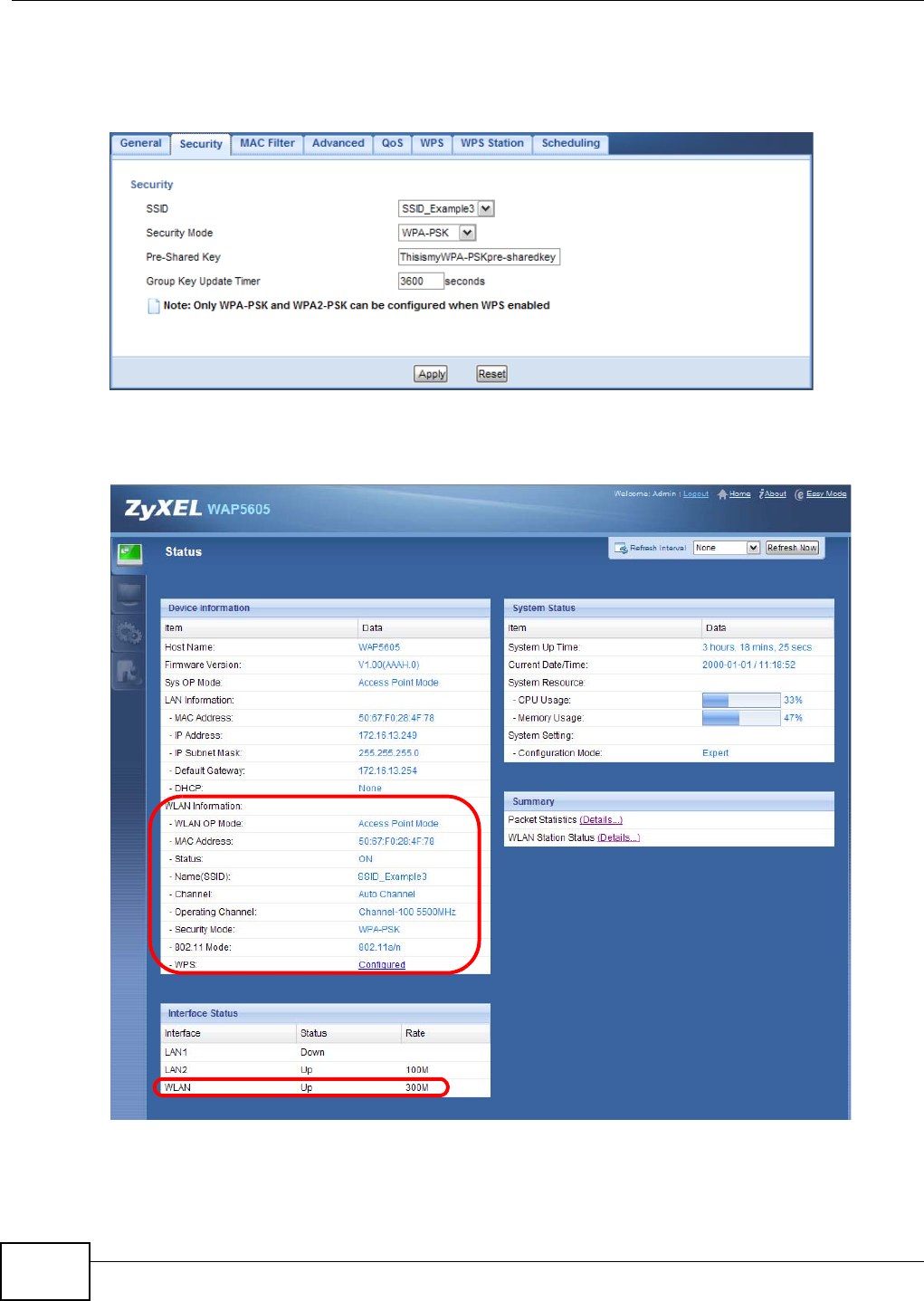
Chapter 7 Tutorials
WAP5605 User’s Guide
60
4Select the SSID (SSID_Example3) for which you want to configure the security. Set security mode
to WPA-PSK and enter ThisismyWPA-PSKpre-sharedkey in the Pre-Shared Key field. Click
Apply.
Figure 36 Tutorial: Network > Wireless LAN > Security
5Open the Status screen. Verify your wireless and wireless security settings under Device
Information and check if the WLAN connection is up under Interface Status.
Figure 37 Tutorial: Checking Wireless Settings
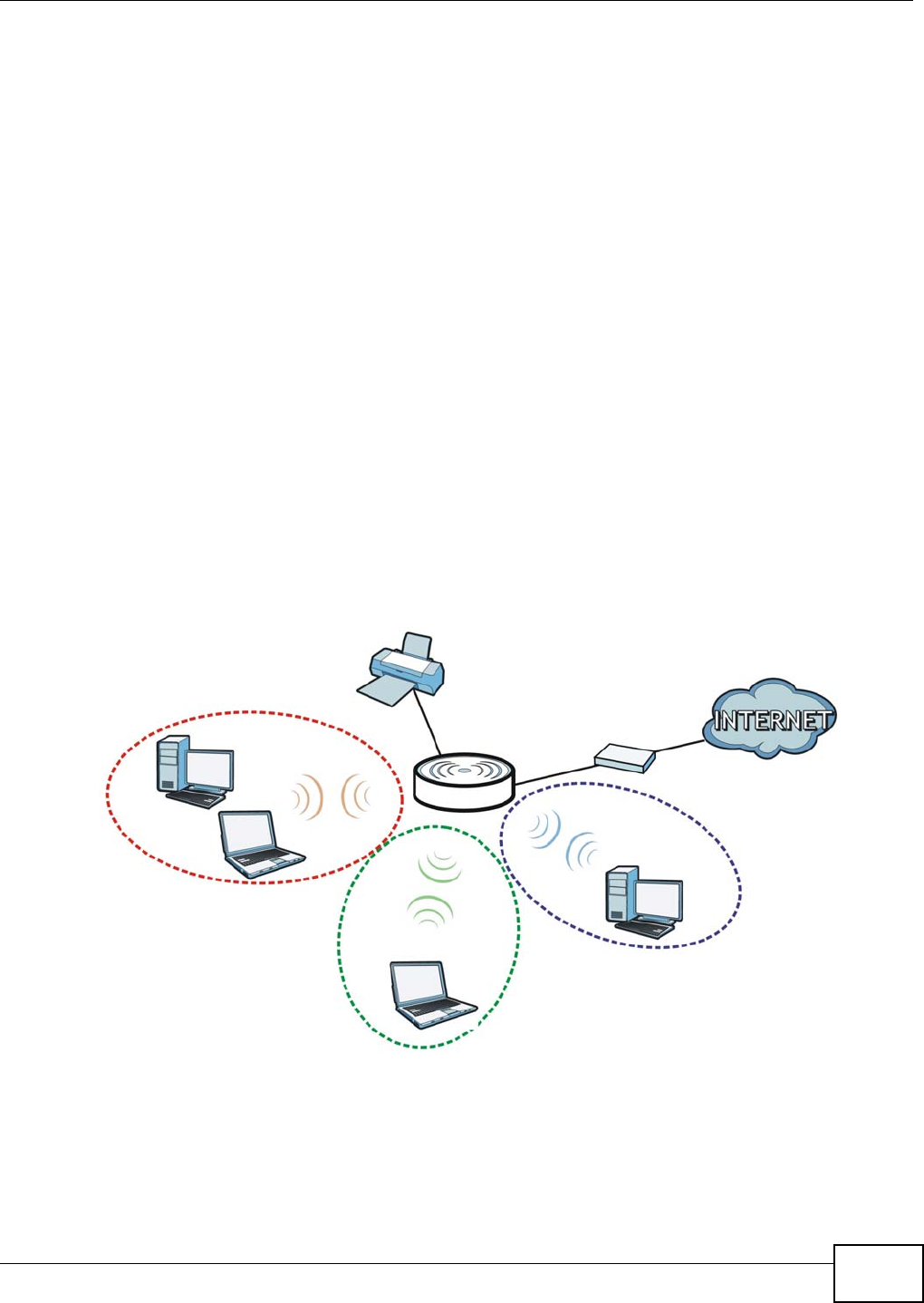
Chapter 7 Tutorials
WAP5605 User’s Guide 61
7.4.1 Configuring Your Wireless Client
Note: At the time of writing, you can only use the WAP5605 in client mode as a wireless
client to wirelessly connect to a WAP5605 in AP mode.
See Section 7.6 on page 64 for how to connect the client to your AP. If your connection is
successful, open your Internet browser and enter http://www.zyxel.com or the URL of any other
web site in the address bar. If you are able to access the web site, your wireless connection is
successfully configured.
7.5 Using Multiple SSIDs on the WAP5605
You can configure more than one SSID on a WAP5605 when it is operating in access point mode.
This allows you to configure multiple independent wireless networks on the WAP5605 as if there
were multiple APs (virtual APs). Each virtual AP has its own SSID, wireless security type and MAC
filtering settings. That is, each SSID on the WAP5605 represents a different access point/wireless
network to wireless clients in the network.
Clients can associate only with the SSIDs for which they have the correct security settings. Clients
using different SSIDs can access the Internet and the wired network behind the WAP5605 (such as
a printer), but they cannot listen to each other’s traffic.
For example, you may set up three wireless networks (A, B and C) in your office. A is for workers,
B is for guests and C is specific to a VoIP device in the meeting room.
A
B
C
SSID_Guest
SSID_Worker
SSID_VoIP
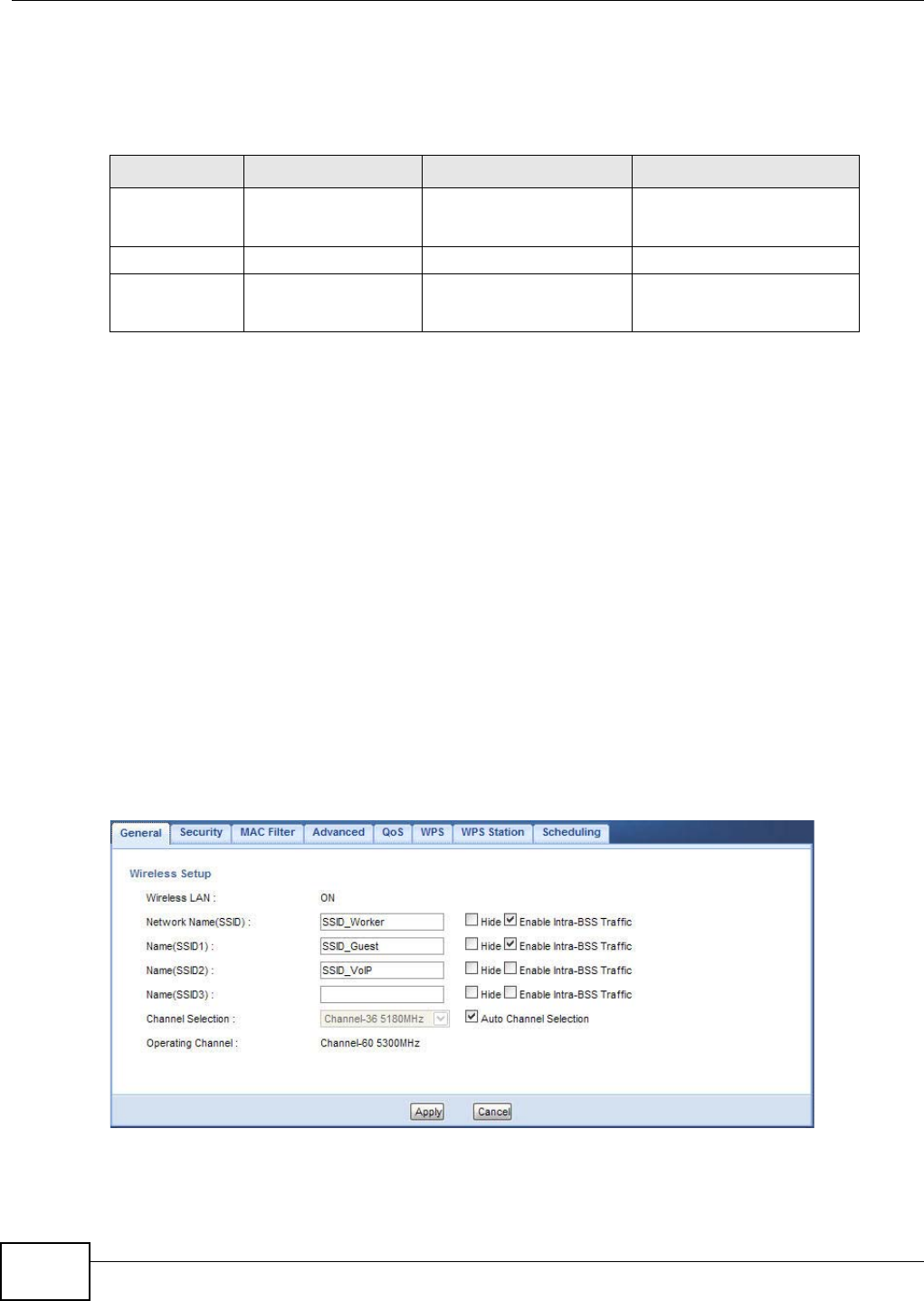
Chapter 7 Tutorials
WAP5605 User’s Guide
62
7.5.1 Configuring Security Settings of Multiple SSIDs
This example shows you how to configure the SSIDs with the following parameters on your
WAP5605 (in access point mode).
1Connect your computer to the LAN port of the WAP5605 using an Ethernet cable.
2The default IP address of the WAP5605 is “192.168.1.2”. In this case, your computer must have an
IP address in the range between “192.168.1.3” and “192.168.1.254”.
3Click Start > Run on your computer in Windows. Type “cmd” in the dialog box. Enter “ipconfig” to
show your computer’s IP address. If your computer’s IP address is not in the correct range then see
Appendix C on page 135 for information on changing your computer’s IP address.
4After you’ve set your computer’s IP address, open a web browser such as Internet Explorer and
type “http://192.168.1.2” as the web address in your web browser.
5Enter “1234” (default) as the password and click Login.
6Type a new password and retype it to confirm, then click Apply. Otherwise, click Ignore.
7The Easy mode appears. Click Expert Mode in the navigation panel.
8Go to Configuration > Network > Wireless LAN > General. Configure the screen as follows. In
this example, you select Enable Intra-BSS Traffic for SSID_Worker and SSID_Guest to allow
wireless clients in the same wireless network to communicate with each other. Click Apply.
SSID SECURITY TYPE KEY MAC FILTERING
SSID_Worker WPA2-PSK
WPA Compatible
DoNotStealMyWirelessNet
work
Disable
SSID_Guest Static WEP 128bit keyexample123 Disable
SSID_VoIP WPA-PSK VoIPOnly12345678 Allow
00:A0:C5:01:23:45
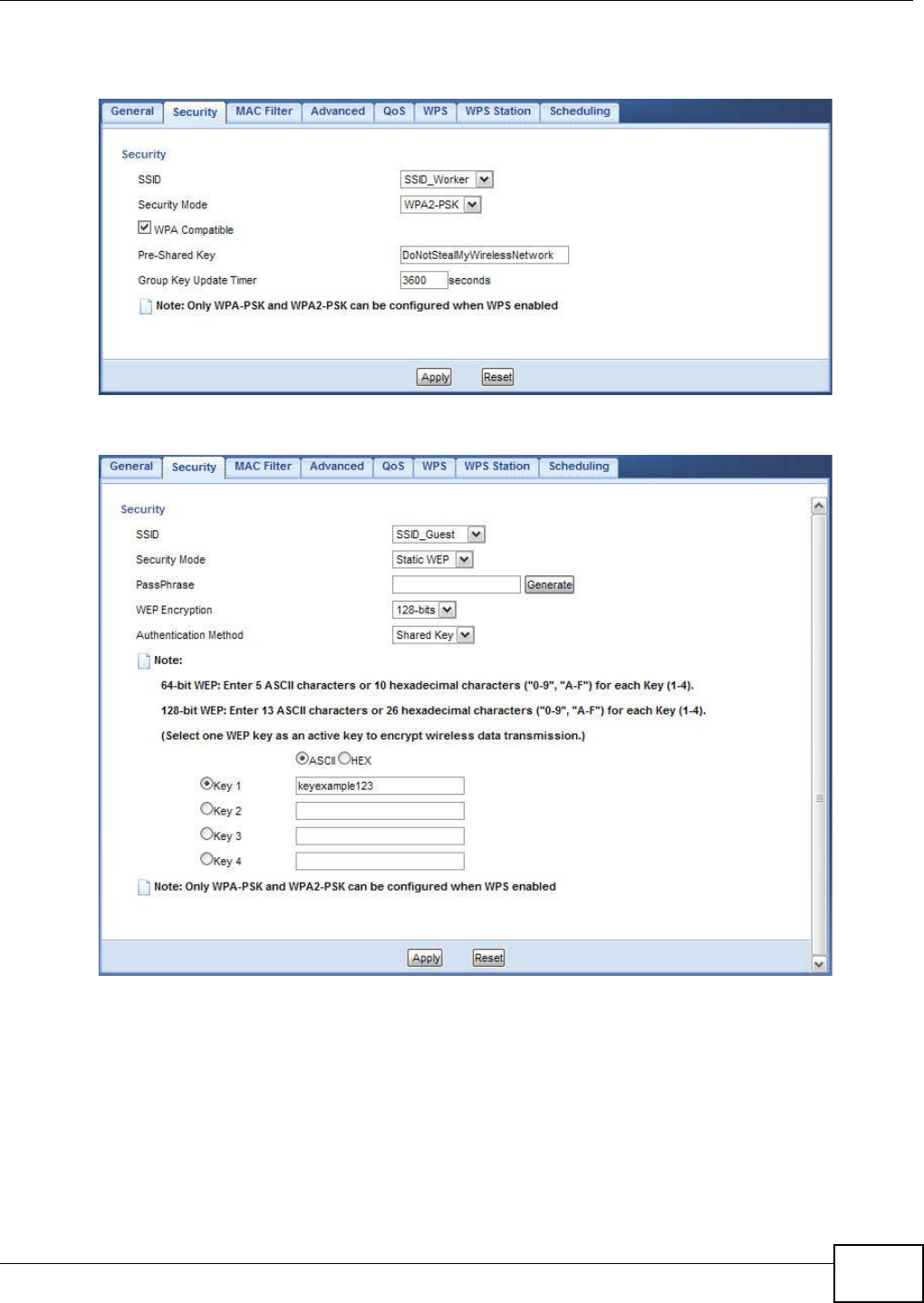
Chapter 7 Tutorials
WAP5605 User’s Guide 63
9Click the Security tab to configure security settings for each SSID. Select SSID_Worker from the
SSID drop-down list. Configure the screen as follows. Click Apply.
10 Select SSID_Guest from the SSID drop-down list. Configure the screen as follows. Click Apply.
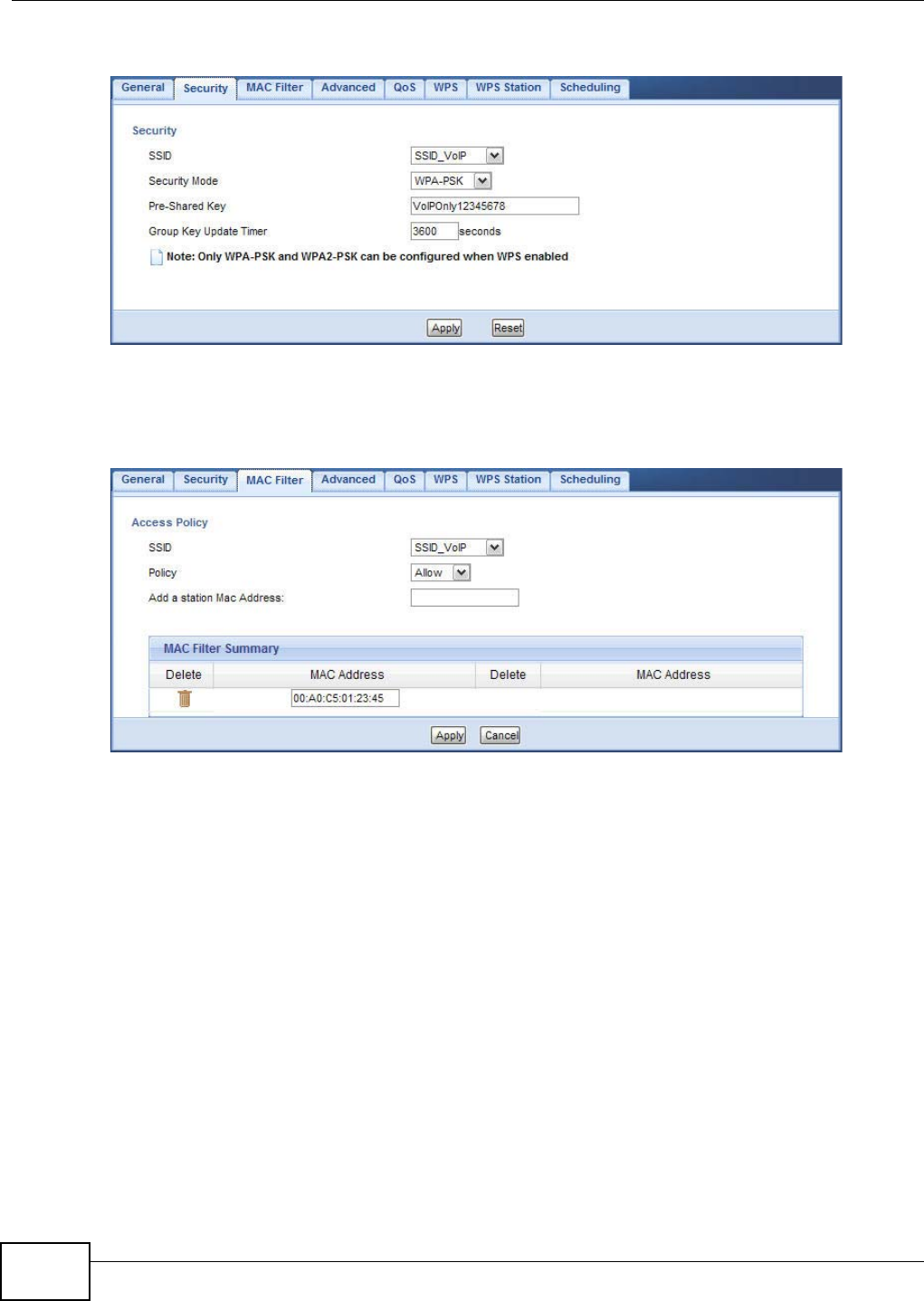
Chapter 7 Tutorials
WAP5605 User’s Guide
64
11 Select SSID_VoIP from the SSID drop-down list. Configure the screen as follows. Click Apply.
12 Click the MAC Filter tab to configure MAC filtering for the SSID_VoIP wireless network. Select
SSID_VoIP from the SSID drop-down list and select Allow in the Policy field. Enter the VoIP
device’s MAC address in the Add a station Mac Address field and click Apply to allow only the
VoIP device to associate with the WAP5605 using this SSID.
7.6 Connecting the WAP5605 (in Client Mode) to an AP
If you have an access point with Internet access deployed in your network already, and you want to
use the WAP5605 as a wireless client to connect to the existing AP, set the WAP5605 to client mode.
The WAP5605 then acts as a wireless client. Your device, such as a computer, can connect to the
WAP5605 through a wired connection to access the Internet.
1Connect your computer to the LAN port of the WAP5605 using an Ethernet cable.
2The default IP address of the WAP5605 in client mode is “192.168.1.10”. In this case, your
computer must have an IP address in the range between “192.168.1.11” and “192.168.1.254”.
3Click Start > Run on your computer in Windows. Type “cmd” in the dialog box. Enter “ipconfig” to
show your computer’s IP address. If your computer’s IP address is not in the correct range then see
Appendix C on page 135 for information on changing your computer’s IP address.
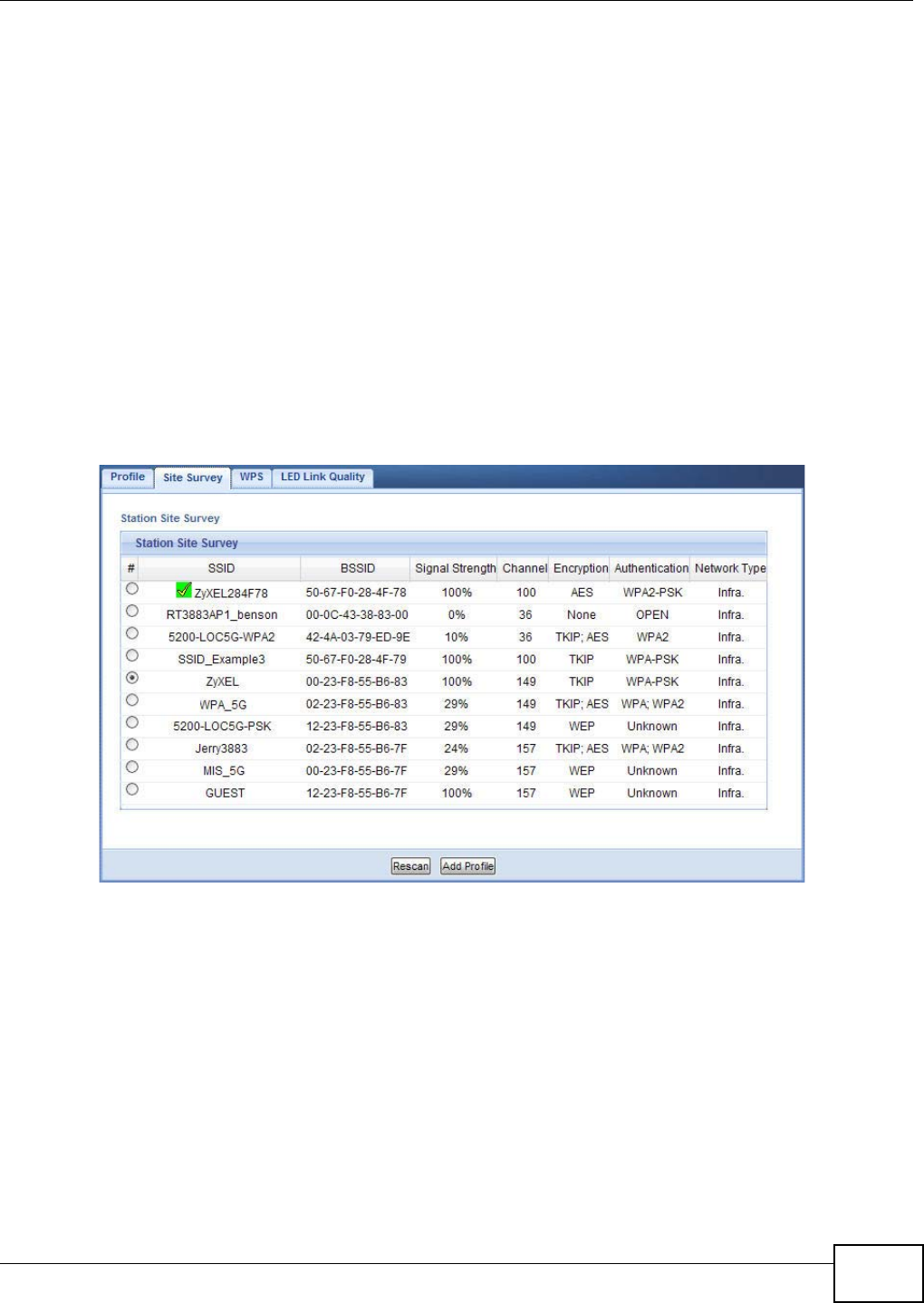
Chapter 7 Tutorials
WAP5605 User’s Guide 65
4After you’ve set your computer’s IP address, open a web browser such as Internet Explorer and
type “http://192.168.1.10” as the web address in your web browser.
5Enter “1234” (default) as the password and click Login.
6Type a new password and retype it to confirm, then click Apply. Otherwise, click Ignore.
7The Easy mode appears. Click Expert Mode in the navigation panel.
8To connect to a specific wireless network, you can manually create a wireless profile or use the site
survey tool to associate with it.
7.6.1 Connecting to a Wireless Network Using Site Survey
1Go to Configuration > Network > Wireless LAN > Site Survey. The WAP5605 automatically
scans for and connects to an available wireless network. The green check icon indicates the wireless
device to which the WAP5605 is connecting. Select an SSID’s radio button and click Add Profile to
add this wireless device to a profile.
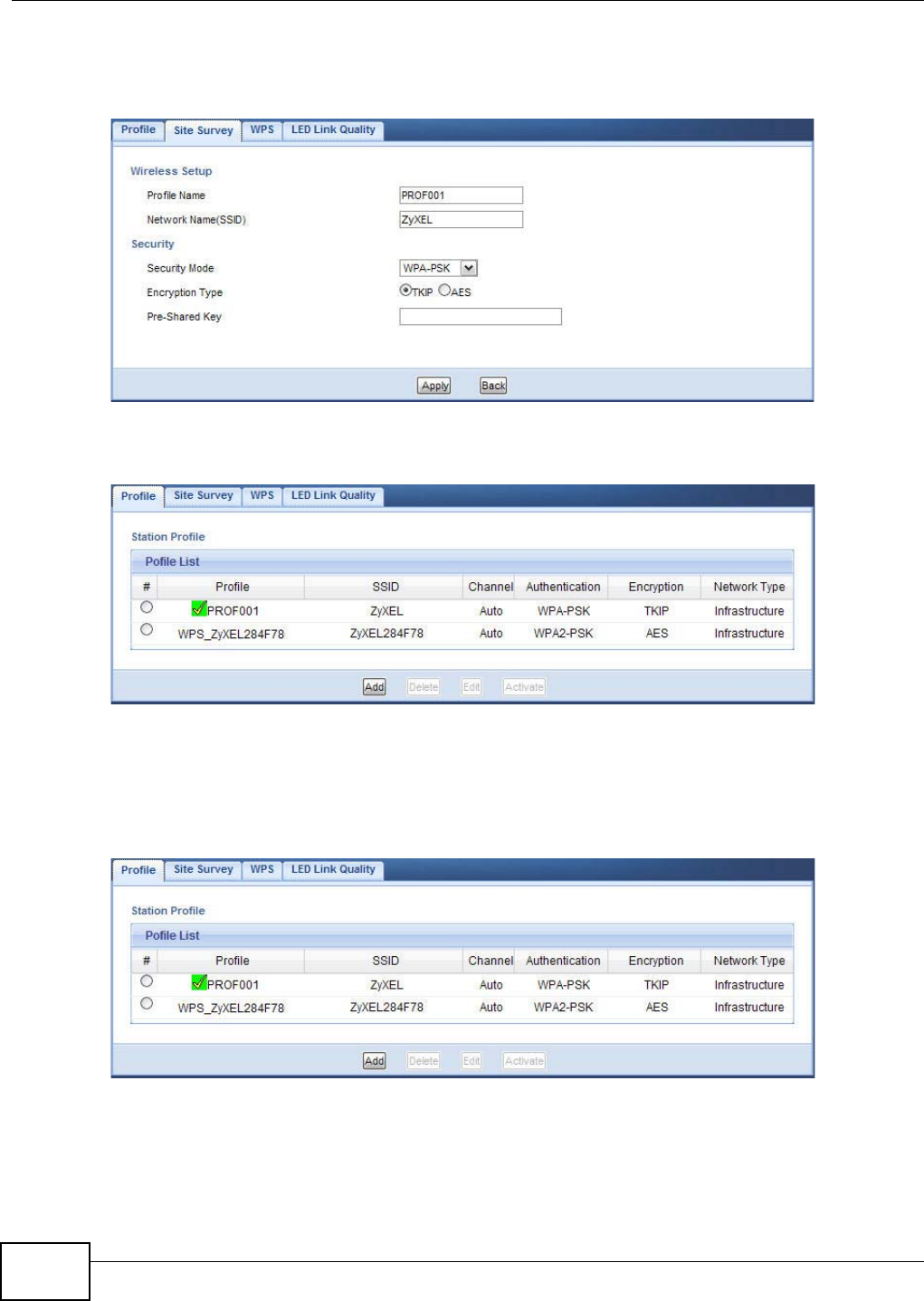
Chapter 7 Tutorials
WAP5605 User’s Guide
66
2Enter a new profile name or use the name generated automatically by the system. Enter the
security settings if requested and click Apply. The security settings must be the same as those on
the AP to which you are connecting.
3The new profile entry displays in the Profile screen. The green check icon means this profile is
active and the WAP5605 is associating with the specified wireless network.
7.6.2 Connecting to a Wireless Network Using a Profile
1Go to Configuration > Network > Wireless LAN > Profile. Click Add to manually create a
wireless LAN profile.
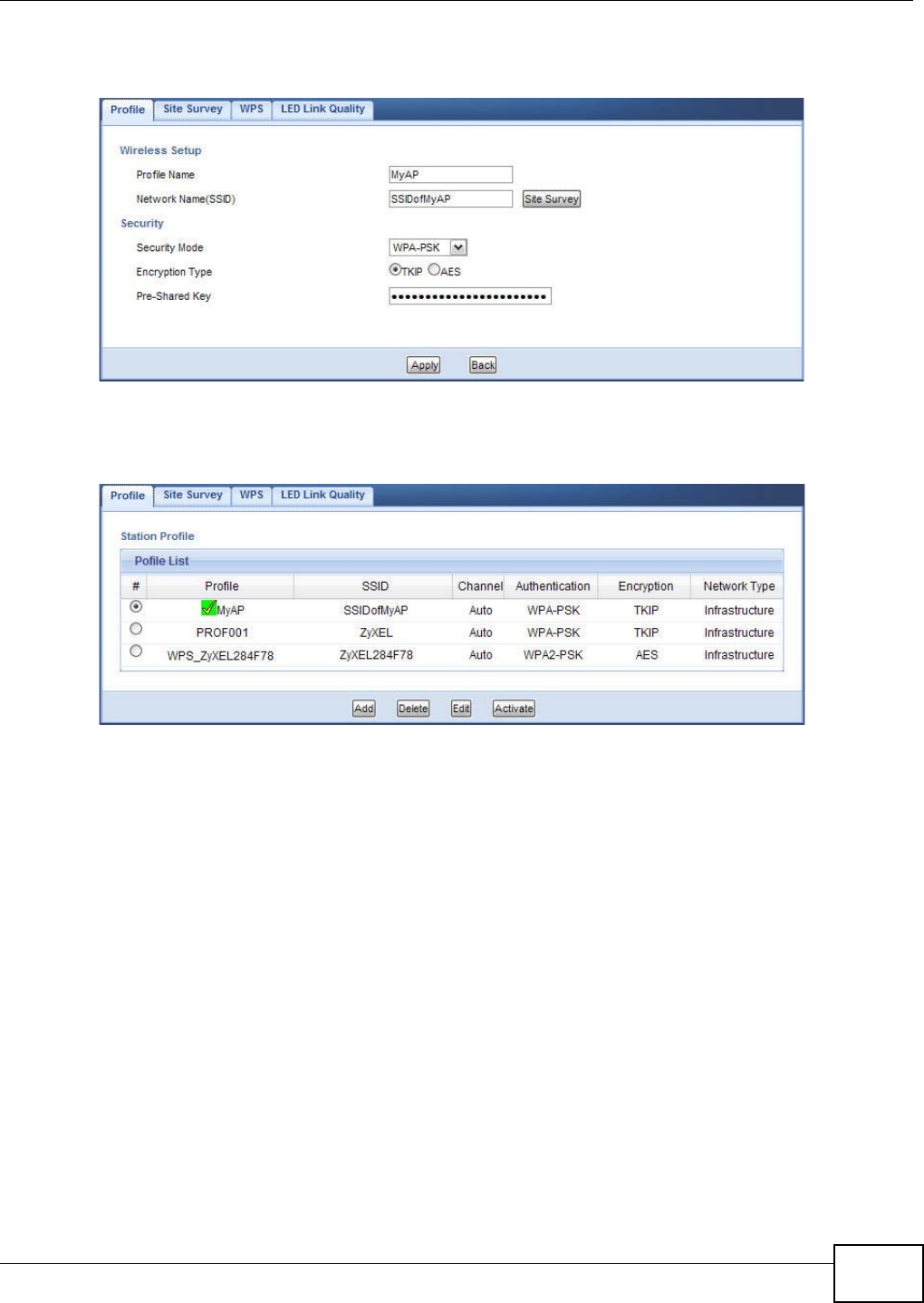
Chapter 7 Tutorials
WAP5605 User’s Guide 67
2Enter a descriptive profile name and the SSID and security settings of the wireless device to which
you want to connect. Click Apply.
3The new profile entry displays in the Profile screen. To enable a profile, select the corresponding
radio button and click Activate. The green check icon means this profile is active and the WAP5605
is associating with the specified wireless network.
7.6.3 Deploying the WAP5605 in your Network
1After you finish configuring the operating mode and wireless settings on the WAP5605, disconnect
the computer from the WAP5605 and change its TCP/IP settings back to the previous ones.
2Connect a device to the WAP5605, which you want to use to access the AP or wireless router
through the WAP5605. Make sure the device is set to obtain an IP address automatically.

Chapter 7 Tutorials
WAP5605 User’s Guide
68

69
PART II
Technical Reference

70

WAP5605 User’s Guide 71
CHAPTER 8
Monitor
8.1 Overview
This chapter discusses read-only information related to the device state of the WAP5605.
Note: To access the Monitor screens, you can also click the links in the Summary table of
the Status screen to view the packets sent/received as well as the status of clients
connected to the WAP5605.
8.2 What You Can Do
•Use the View Log screen (Section 8.3 on page 71) to see the logs for the categories that you
selected in the Log Settings screen.
•Use the Log Settings screen (Section 8.4 on page 72) to configure which logs and/or immediate
alerts the WAP5605 is to record.
•use the Packet Statistics screen (Section 8.5 on page 73) to view port status, packet specific
statistics, the "system up time" and so on.
•Use the WLAN Station Status screen (Section 8.6 on page 74) to view the wireless stations
that are currently associated to the WAP5605.
8.3 View Log
Use the View Log screen to see the logged messages for the WAP5605.
Log entries in red indicate system error logs. The log wraps around and deletes the old entries after
it fills.
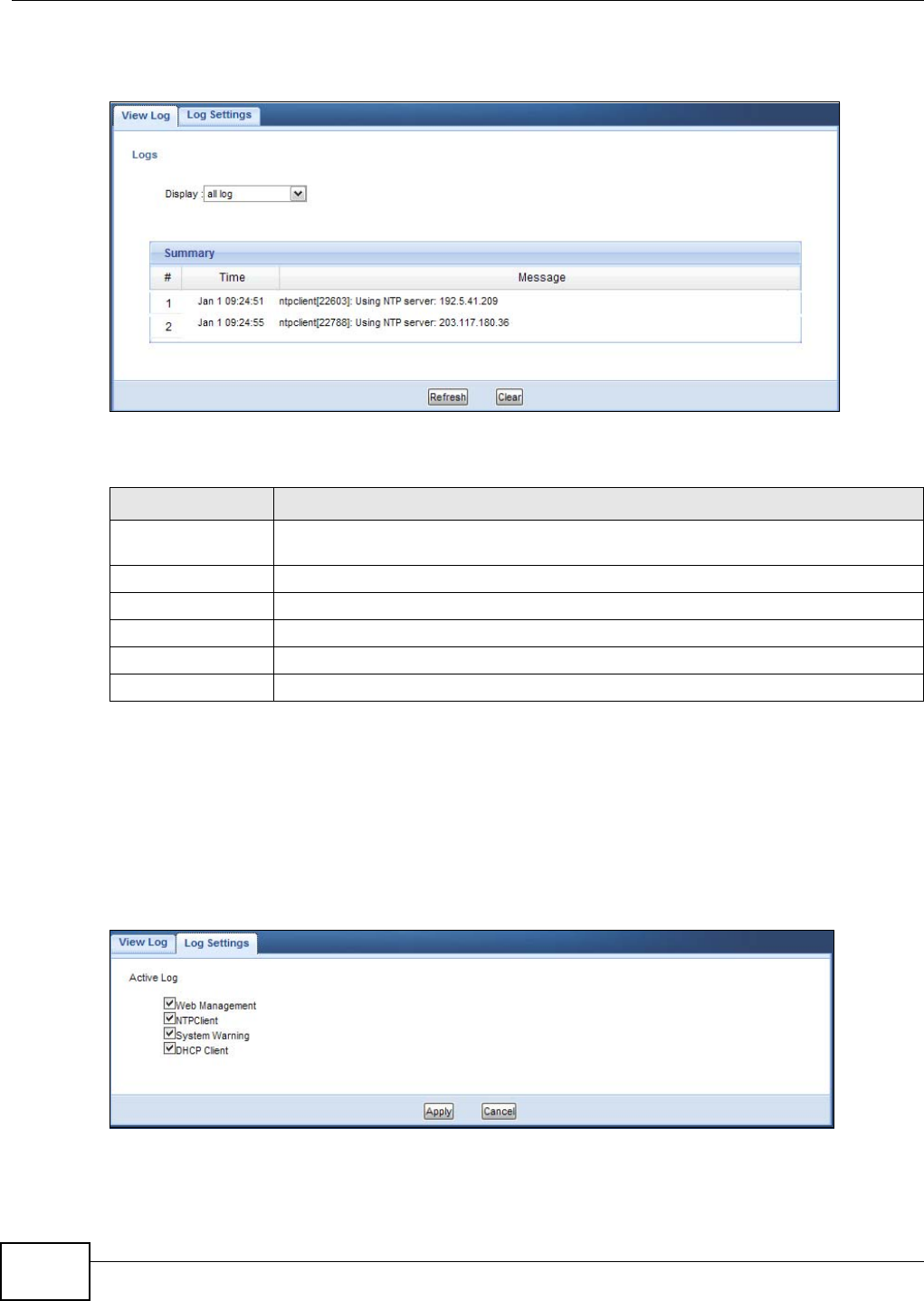
Chapter 8 Monitor
WAP5605 User’s Guide
72
Click Monitor > Log.
Figure 38 Monitor > Log
The following table describes the labels in this screen.
8.4 Log Settings
Use the Log Settings screen to choose which categories of events and/or alerts the WAP5605 is to
log and then display the logs. To change your WAP5605’s log settings, click Monitor > Log > Log
Settings. The screen appears as shown.
Figure 39 Monitor > Log > Log Settings
Table 23 Monitor > Log
LABEL DESCRIPTION
Display Select a category of logs to view. Select all log to view logs from all of the log
categories that you selected in the Log Settings screen.
#This field is a sequential value and is not associated with a specific entry.
Time This field displays the time the log was recorded.
Message This field states the reason for the log.
Refresh Click Refresh to renew the log screen.
Clear Click Clear to delete all the logs.
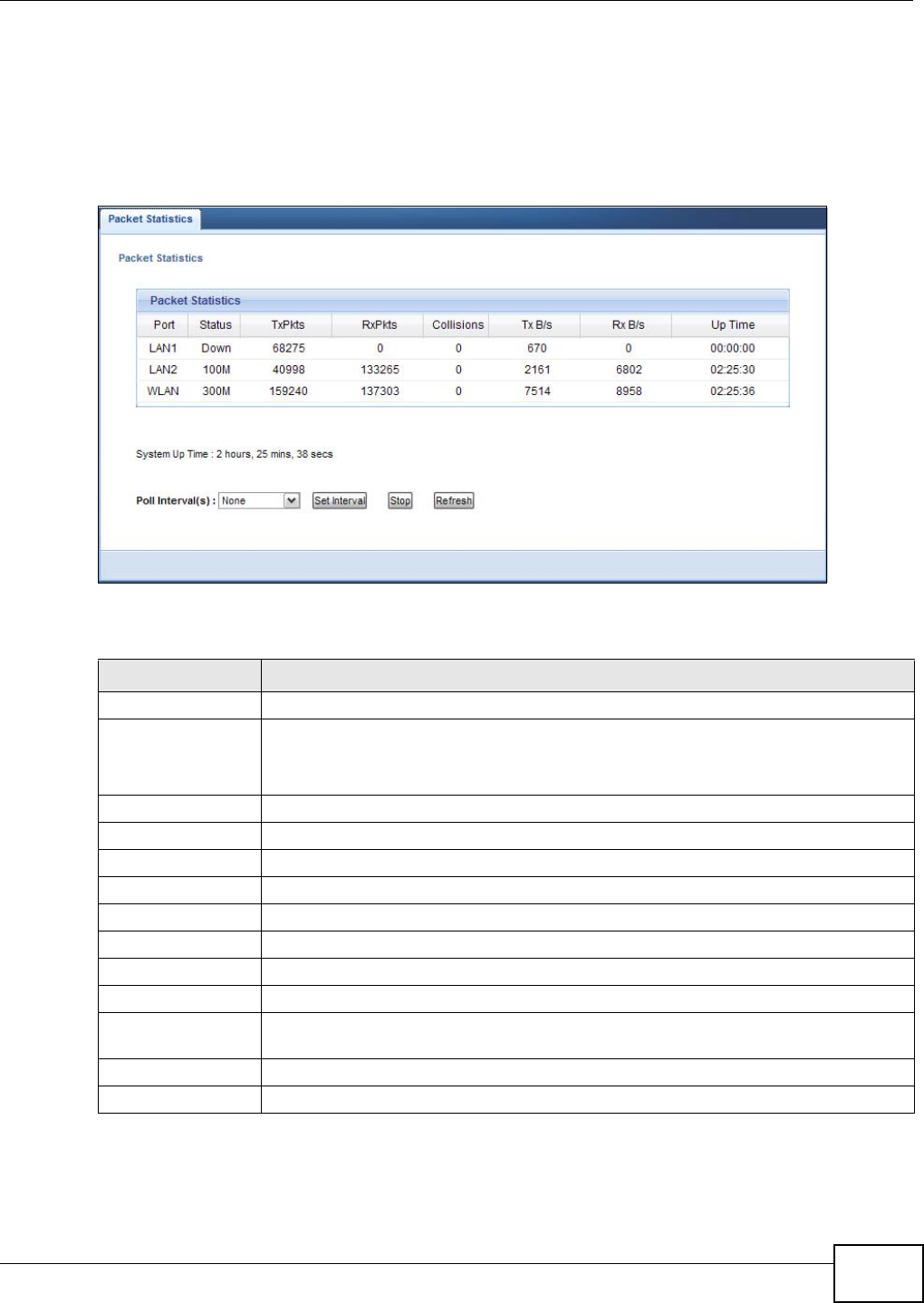
Chapter 8 Monitor
WAP5605 User’s Guide 73
8.5 Packet Statistics
Click the Packet Statistics (Details...) hyperlink in the Status screen or Monitor > Packet
Statistics. Read-only information here includes port status, packet specific statistics and the
"system up time". The Poll Interval(s) field is configurable and is used for refreshing the screen.
Figure 40 Monitor > Packet Statistics
The following table describes the labels in this screen.
Table 24 Monitor > Packet Statistics
LABEL DESCRIPTION
Port This is the WAP5605’s port type.
Status For the LAN ports, this displays the port speed or Down when the line is disconnected.
For the WLAN, it displays the maximum transmission rate when the WLAN is enabled
and Down when the WLAN is disabled.
TxPkts This is the number of transmitted packets on this port.
RxPkts This is the number of received packets on this port.
Collisions This is the number of collisions on this port.
Tx B/s This displays the transmission speed in bytes per second on this port.
Rx B/s This displays the reception speed in bytes per second on this port.
Up Time This is the total time the WAP5605 has been for each session.
System Up Time This is the total time the WAP5605 has been on.
Poll Interval(s) Enter the time interval in seconds for refreshing statistics in this field.
Set Interval Click this button to apply the new poll interval you entered in the Poll Interval(s)
field.
Stop Click Stop to stop refreshing statistics.
Refresh Click Refresh to update this screen.
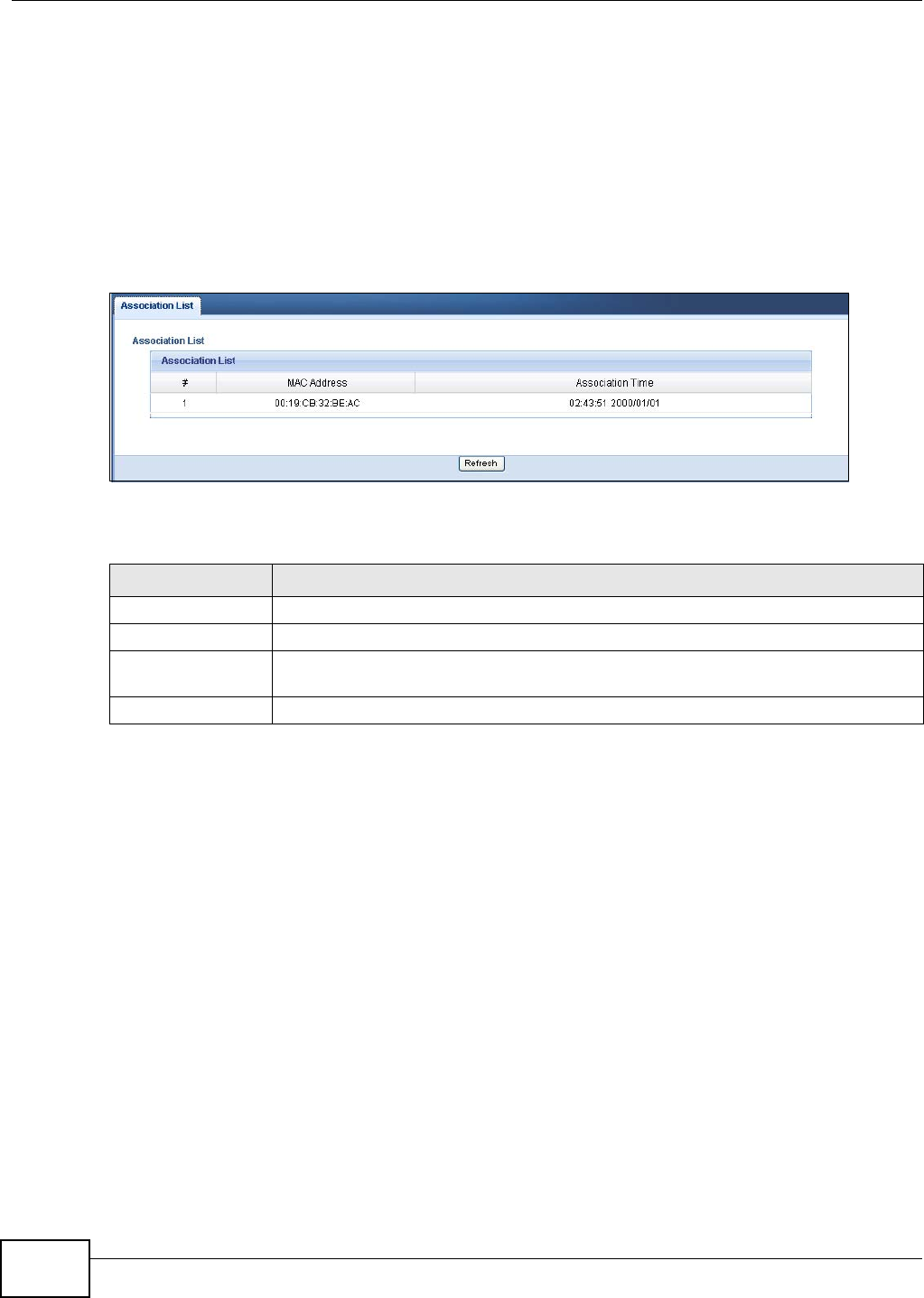
Chapter 8 Monitor
WAP5605 User’s Guide
74
8.6 WLAN Station Status
Click the WLAN Station Status (Details...) hyperlink in the Status screen or Monitor > WLAN
Station Status. View the wireless stations that are currently associated to the WAP5605 in the
Association List. Association means that a wireless client (for example, your network or computer
with a wireless network card) has connected successfully to the AP (or wireless router) using the
same SSID, channel and security settings.
Note: This screen is not available when the WAP5605 is in Client mode.
Figure 41 Monitor > WLAN Station Status > Association List
The following table describes the labels in this screen.
Table 25 Monitor > WLAN Station Status > Association List
LABEL DESCRIPTION
# This is the index number of an associated wireless station.
MAC Address This field displays the MAC address of an associated wireless station.
Association Time This field displays the time a wireless station first associated with the WAP5605’s WLAN
network.
Refresh Click Refresh to reload the list.
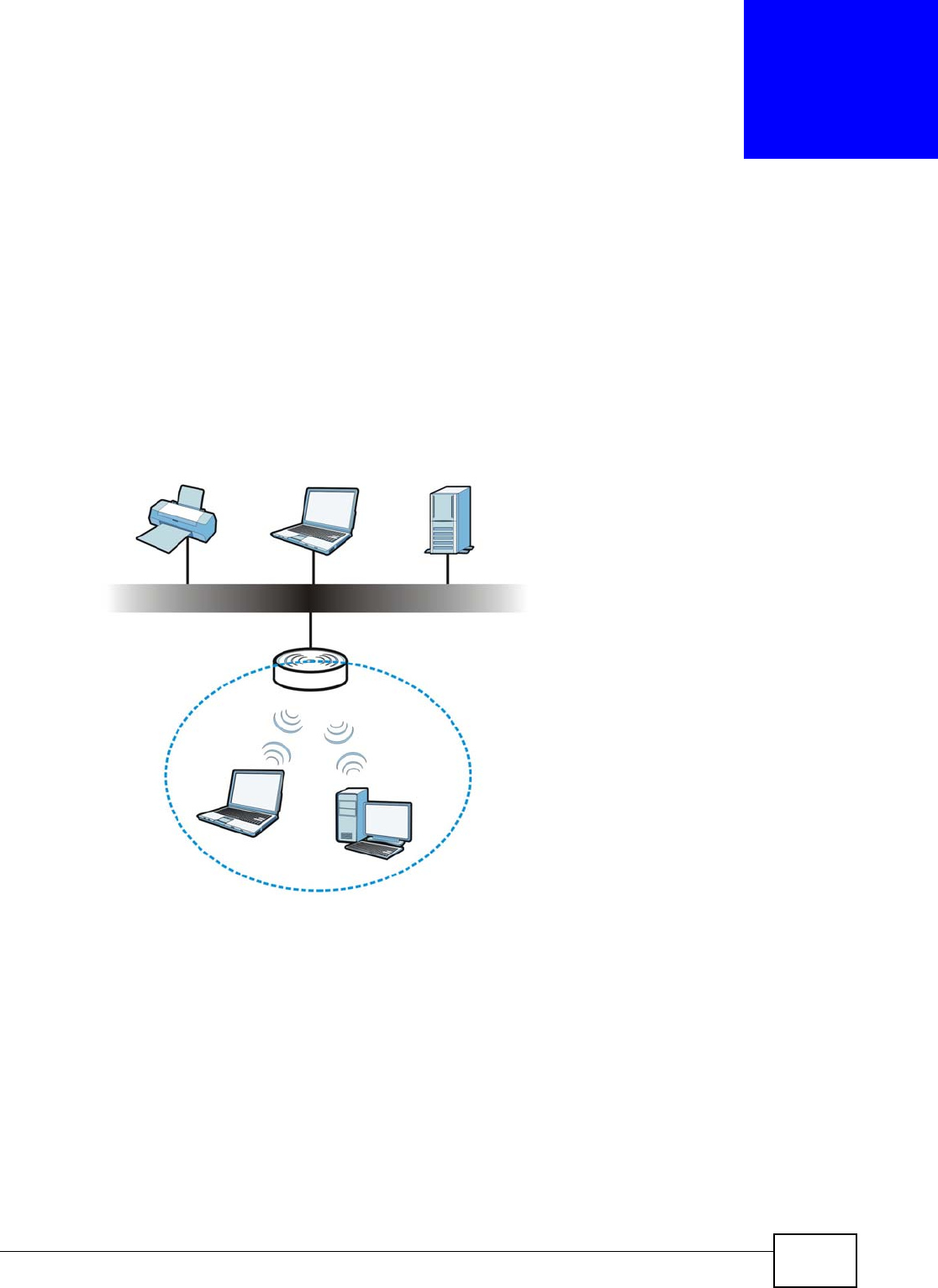
WAP5605 User’s Guide 75
CHAPTER 9
Wireless LAN
9.1 Overview
This chapter discusses how to configure the wireless network settings in your WAP5605. See the
appendices for more detailed information about wireless networks.
The following figure provides an example of a wireless network.
Figure 42 Example of a Wireless Network
The wireless network is the part in the blue circle. In this wireless network, devices A and B are
called wireless clients. The wireless clients use the access point (AP) to interact with other devices
(such as the printer) or with the Internet. Your WAP5605 is the AP.
9.2 What You Can Do
•Use the General screen (Section 9.4 on page 78) to enter the SSID, enable intra-BSS traffic and
select the channel.
•Use the Security screen (Section 9.5 on page 79) to configure wireless security between the
WAP5605 and the wireless clients.
•Use the MAC Filter screen (Section 9.6 on page 82) to allow or deny wireless stations based on
their MAC addresses from connecting to the WAP5605.
AB

Chapter 9 Wireless LAN
WAP5605 User’s Guide
76
•Use the Advanced screen (Section 9.7 on page 83) to configure wireless advanced features,
such as set the RTS/CTS Threshold and HT physical mode.
•Use the QoS screen (Section 9.8 on page 84) to enable Wifi MultiMedia Quality of Service
(WMMQoS). This allows the WAP5605 to automatically set priority levels to services, such as e-
mail, VoIP, chat, and so on.
•Use the WPS screen (Section 9.9 on page 85) to quickly set up a wireless network with strong
security, without having to configure security settings manually.
•Use the WPS Station screen (Section 9.10 on page 86) to add a wireless station using WPS.
•Use the Scheduling screen (Section 9.11 on page 87) to set the times your wireless LAN is
turned on and off.
9.3 What You Should Know
Every wireless network must follow these basic guidelines.
• Every wireless client in the same wireless network must use the same SSID.
The SSID is the name of the wireless network. It stands for Service Set IDentity.
• If two wireless networks overlap, they should use different channels.
Like radio stations or television channels, each wireless network uses a specific channel, or
frequency, to send and receive information.
• Every wireless client in the same wireless network must use security compatible with the AP.
Security stops unauthorized devices from using the wireless network. It can also protect the
information that is sent in the wireless network.
9.3.1 Wireless Security Overview
The following sections introduce different types of wireless security you can set up in the wireless
network.
9.3.1.1 SSID
Normally, the AP acts like a beacon and regularly broadcasts the SSID in the area. You can hide the
SSID instead, in which case the AP does not broadcast the SSID. In addition, you should change
the default SSID to something that is difficult to guess.
This type of security is fairly weak, however, because there are ways for unauthorized devices to
get the SSID. In addition, unauthorized devices can still see the information that is sent in the
wireless network.
9.3.1.2 MAC Address Filter
Every wireless client has a unique identification number, called a MAC address.1 A MAC address is
usually written using twelve hexadecimal characters2; for example, 00A0C5000002 or
00:A0:C5:00:00:02. To get the MAC address for each wireless client, see the appropriate User’s
Guide or other documentation.
1. Some wireless devices, such as scanners, can detect wireless networks but cannot use wireless networks. These kinds
of wireless devices might not have MAC addresses.
2. Hexadecimal characters are 0, 1, 2, 3, 4, 5, 6, 7, 8, 9, A, B, C, D, E, and F.

Chapter 9 Wireless LAN
WAP5605 User’s Guide 77
You can use the MAC address filter to tell the AP which wireless clients are allowed or not allowed to
use the wireless network. If a wireless client is allowed to use the wireless network, it still has to
have the correct settings (SSID, channel, and security). If a wireless client is not allowed to use the
wireless network, it does not matter if it has the correct settings.
This type of security does not protect the information that is sent in the wireless network.
Furthermore, there are ways for unauthorized devices to get the MAC address of an authorized
wireless client. Then, they can use that MAC address to use the wireless network.
9.3.1.3 Encryption
Wireless networks can use encryption to protect the information that is sent in the wireless
network. Encryption is like a secret code. If you do not know the secret code, you cannot
understand the message.
The types of encryption you can choose depend on the type of user authentication.
Usually, you should set up the strongest encryption that every wireless client in the wireless
network supports. Suppose the wireless network has two wireless clients. Device A only supports
WEP, and device B supports WEP and WPA-PSK. Therefore, you should set up WEP in the wireless
network.
Note: It is recommended that wireless networks use WPA-PSK or stronger encryption.
IEEE 802.1x and WEP encryption are better than none at all, but it is still possible
for unauthorized devices to figure out the original information pretty quickly.
When you select WPA2-PSK in your WAP5605, you can also select an option (WPA Compatible)
to support WPA as well. In this case, if some wireless clients support WPA and some support WPA2,
you should set up WPA2-PSK (depending on the type of wireless network login) and select the
WPA Compatible option in the WAP5605.
Many types of encryption use a key to protect the information in the wireless network. The longer
the key, the stronger the encryption. Every wireless client in the wireless network must have the
same key.
9.3.1.4 WPS
WiFi Protected Setup (WPS) is an industry standard specification, defined by the WiFi Alliance. WPS
allows you to quickly set up a wireless network with strong security, without having to configure
security settings manually. Depending on the devices in your network, you can either press a
button (on the device itself, or in its configuration utility) or enter a PIN (Personal Identification
Number) in the devices. Then, they connect and set up a secure network by themselves. See how
to set up a secure wireless network using WPS in the Section 7.3 on page 55.
Table 26 Types of Encryption for Each Type of Authentication
NO AUTHENTICATION
Weakest No Security
WEP
WPA-PSK
Strongest WPA2-PSK
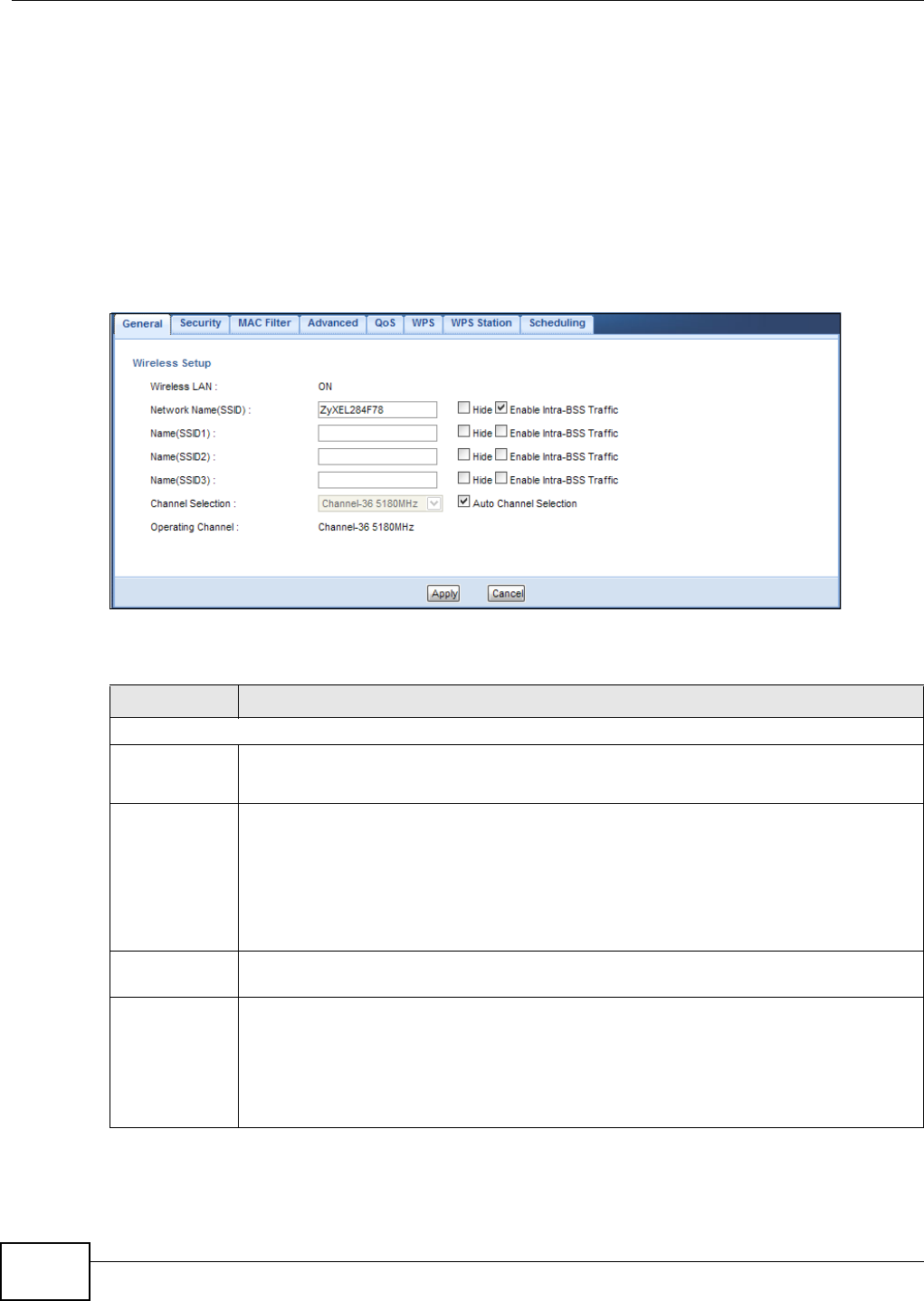
Chapter 9 Wireless LAN
WAP5605 User’s Guide
78
9.4 General Wireless LAN Screen
Use this screen to enter the SSID, select the channel and enable intra-BSS traffic.
Note: If you are configuring the WAP5605 from a computer connected to the wireless LAN
and you change the WAP5605’s SSID, channel or security settings, you will lose
your wireless connection when you press Apply to confirm. You must then change
the wireless settings of your computer to match the WAP5605’s new settings.
Click Network > Wireless LAN to open the General screen.
Figure 43 Network > Wireless LAN > General
The following table describes the general wireless LAN labels in this screen.
Table 27 Network > Wireless LAN > General
LABEL DESCRIPTION
Wireless Setup
Wireless LAN This is turned on by default.
The current wireless state is reflected in this field.
Network
Name(SSID)
or
Name(SSID1~
3)
The SSID (Service Set IDentity) identifies the Service Set with which a wireless client is
associated. Enter a descriptive name (up to 32 printable characters found on a typical
English language keyboard) for the wireless LAN.
You can configure up to four SSIDs to enable multiple BSSs (Basic Service Sets) on the
WAP5605. This allows you to use one access point to provide several BSSs simutaneously.
You can then assign varying security types to different SSIDs. Wireless clients can use
different SSIDs to associate with the same access point.
Hide SSID Select this check box to hide the SSID in the outgoing beacon frame so a wireless client
cannot obtain the SSID through scanning using a site survey tool.
Enable
Intra-BSS
Traffic
A Basic Service Set (BSS) exists when all communications between wireless clients or
between a wireless client and a wired network client go through one access point (AP).
Intra-BSS traffic is traffic between wireless clients in the BSS. When Intra-BSS is enabled,
wireless clients can access the wired network and communicate with each other. When
Intra-BSS is disabled, wireless clients can still access the wired network but cannot
communicate with each other.
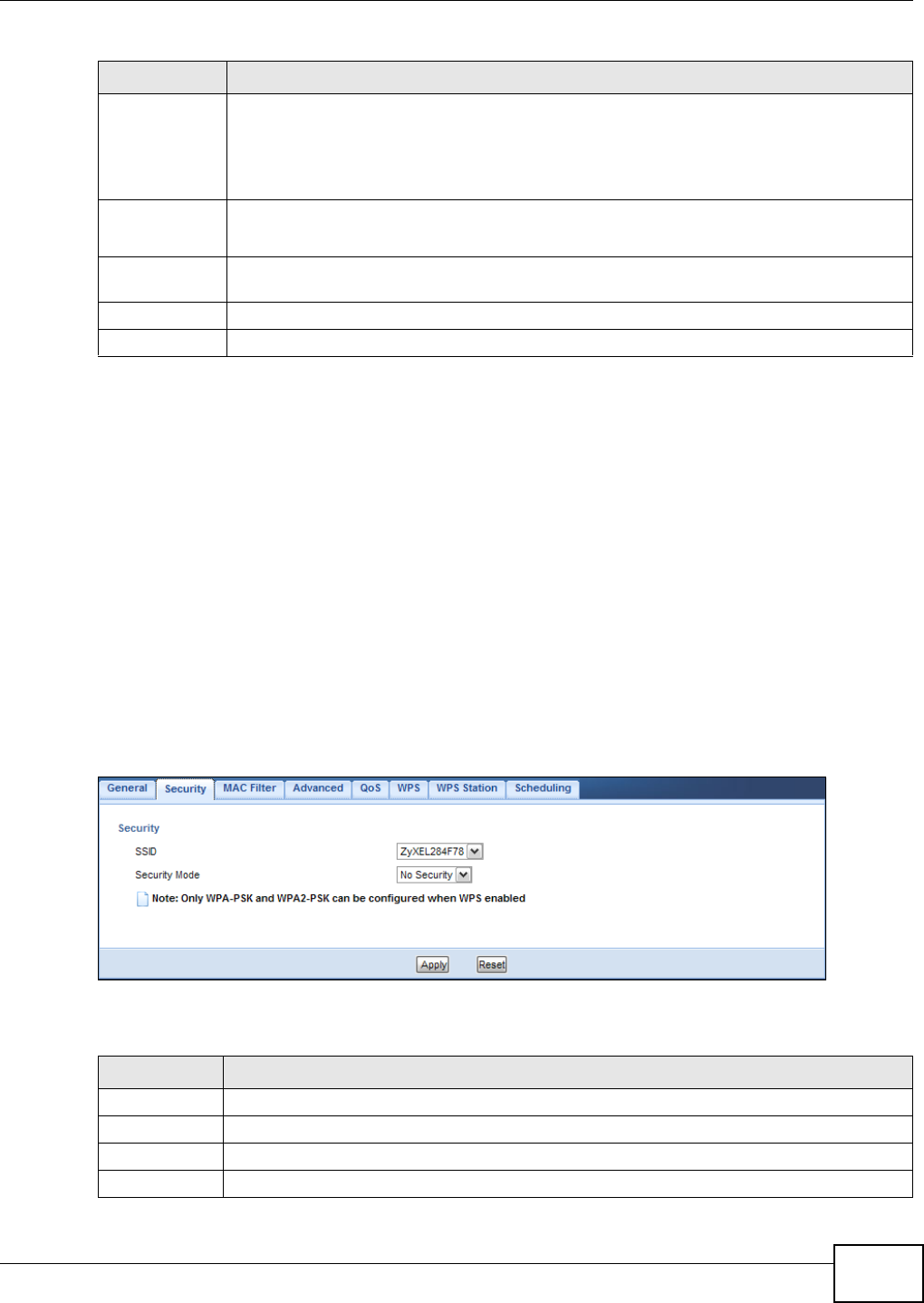
Chapter 9 Wireless LAN
WAP5605 User’s Guide 79
9.5 Wireless Security Screen
Use this screen to select the wireless security mode for each SSID. Click Network > Wireless LAN
> Security to open the Security screen. The screen varies depending on what you select in the
Security Mode field.
9.5.1 No Security
Select No Security to allow wireless clients to communicate with the access points without any
data encryption.
Note: If you do not enable any wireless security on your WAP5605, your network is
accessible to any wireless networking device that is within range.
Figure 44 Network > Wireless LAN > Security: No Security
The following table describes the labels in this screen.
Channel
Selection
Set the operating frequency/channel depending on your particular region.
Select a channel from the drop-down list box. The options vary depending on the frequency
band and the country you are in.
This option is only available if Auto Channel Selection is disabled.
Auto
Channel
Selection
Select the check box to have the WAP5605 automatically scan for and select a channel
which is not used by another device.
Operating
Channel
This displays the channel the WAP5605 is currently using.
Apply Click Apply to save your changes back to the WAP5605.
Cancel Click Cancel to reload the previous configuration for this screen.
Table 27 Network > Wireless LAN > General
LABEL DESCRIPTION
Table 28 Network > Wireless LAN > Security: No Security
LABEL DESCRIPTION
SSID Select the SSID for which you want to configure the security.
Security Mode Choose No Security from the drop-down list box.
Apply Click Apply to save your changes back to the WAP5605.
Cancel Click Cancel to reload the previous configuration for this screen.
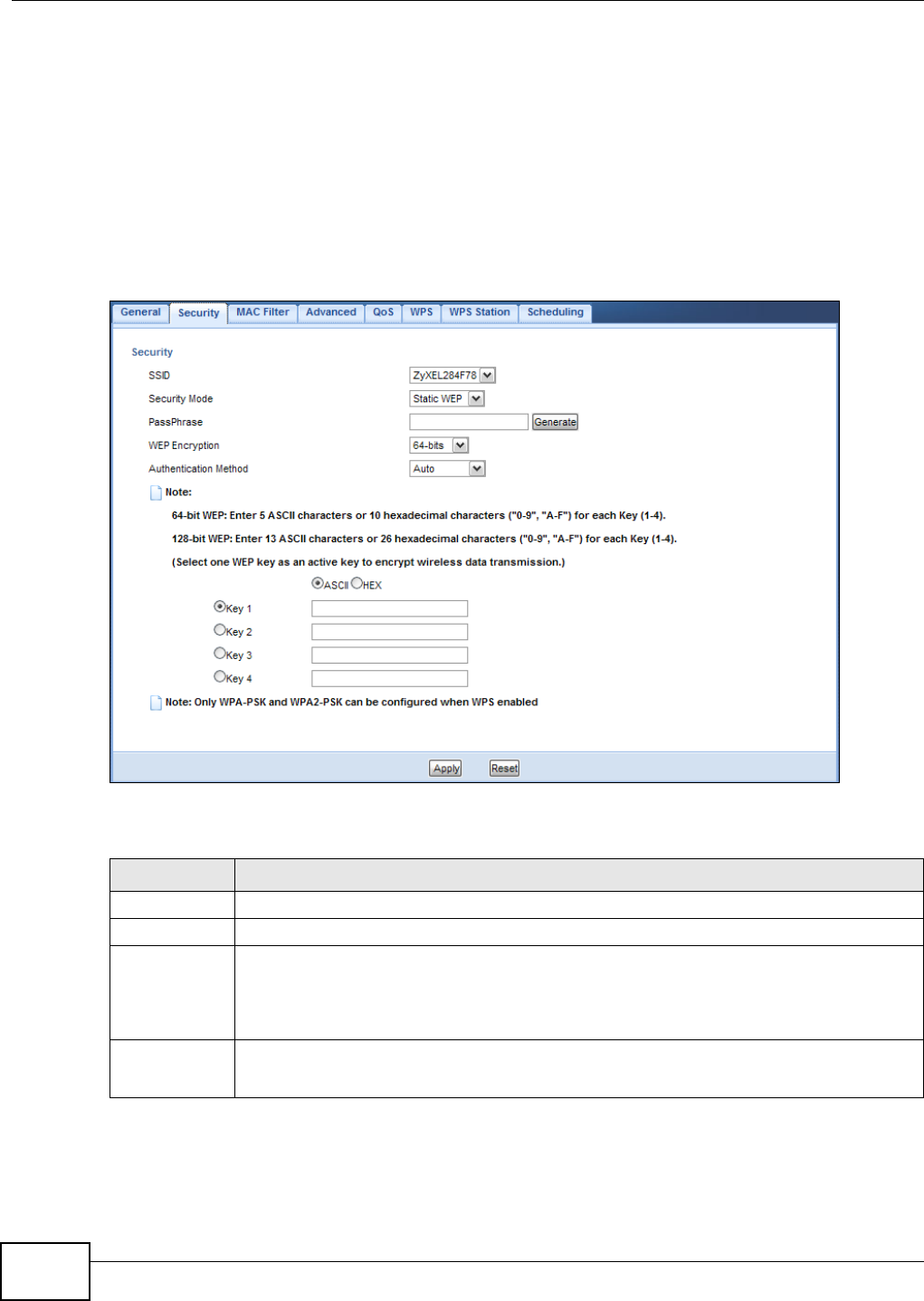
Chapter 9 Wireless LAN
WAP5605 User’s Guide
80
9.5.2 WEP Encryption
WEP encryption scrambles the data transmitted between the wireless stations and the access points
to keep network communications private. It encrypts unicast and multicast communications in a
network. Both the wireless stations and the access points must use the same WEP key.
Your WAP5605 allows you to configure up to four 64-bit or 128-bit WEP keys but only one key can
be enabled at any one time.
Select Static WEP from the Security Mode list.
Figure 45 Network > Wireless LAN > Security: Static WEP
The following table describes the wireless LAN security labels in this screen.
Table 29 Network > Wireless LAN > Security: Static WEP
LABEL DESCRIPTION
SSID Select the SSID for which you want to configure the security.
Security Mode Select Static WEP to enable data encryption.
PassPhrase Enter a Passphrase (up to 26 printable characters) and click Generate.
A passphrase functions like a password. In WEP security mode, it is further converted by the
WAP5605 into a complicated string that is referred to as the “key”. This key is requested
from all devices wishing to connect to a wireless network.
WEP
Encryption
Select 64-bits or 128-bits.
This dictates the length of the security key that the network is going to use.
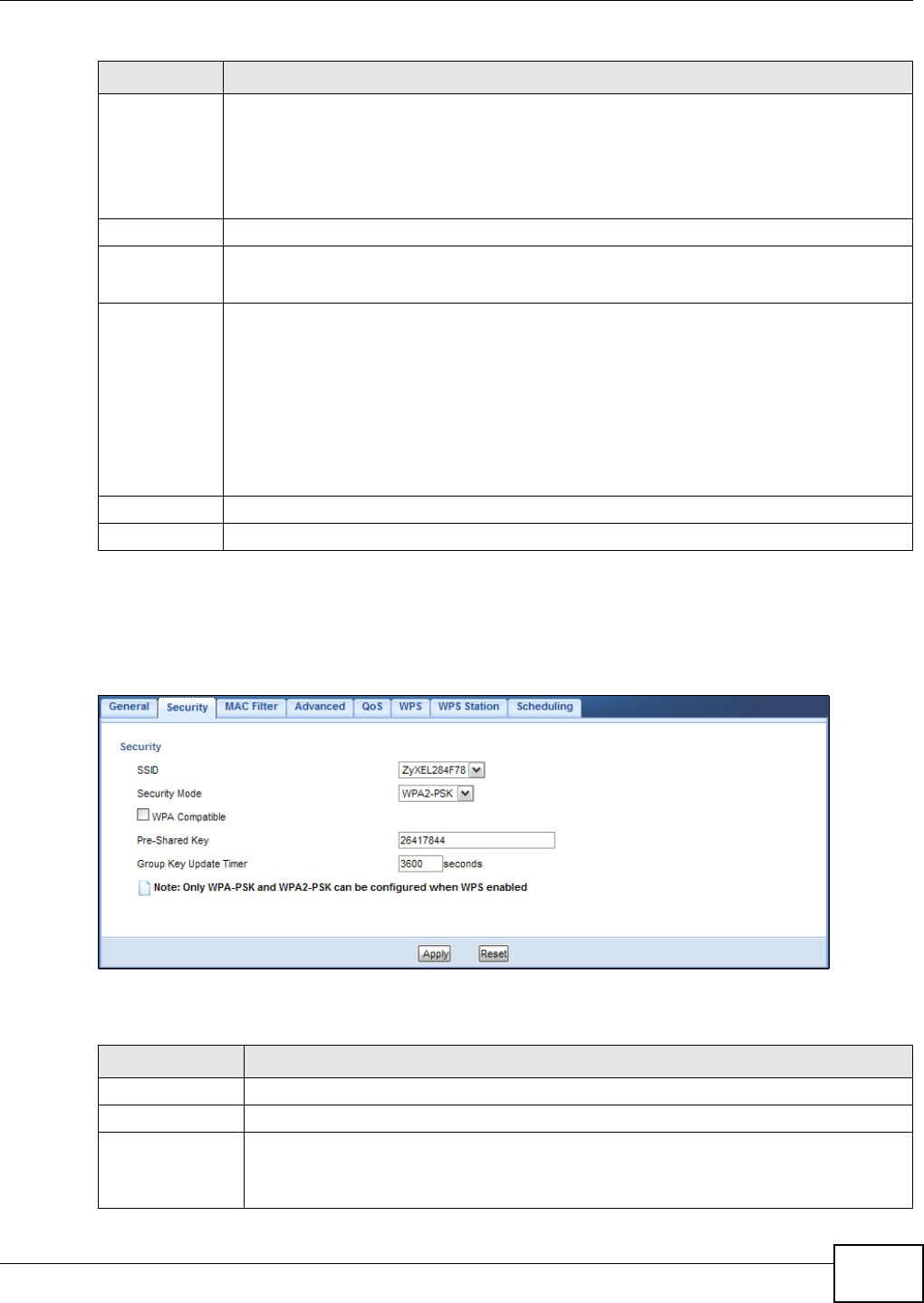
Chapter 9 Wireless LAN
WAP5605 User’s Guide 81
9.5.3 WPA-PSK/WPA2-PSK
Select WPA-PSK or WPA2-PSK from the Security Mode list.
Figure 46 Network > Wireless LAN > Security: WPA-PSK/WPA2-PSK
The following table describes the labels in this screen.
Authentication
Method
Select Auto or Shared Key from the drop-down list box.
This field specifies whether the wireless clients have to provide the WEP key to login to the
wireless client. Keep this setting at Auto unless you want to force a key verification before
communication between the wireless client and the WAP5605 occurs.
Select Shared Key to force the clients to provide the WEP key prior to communication.
ASCII Select this option in order to enter ASCII characters as WEP key.
Hex Select this option in order to enter hexadecimal characters as a WEP key.
The preceding "0x", that identifies a hexadecimal key, is entered automatically.
Key 1 to Key 4 The WEP keys are used to encrypt data. Both the WAP5605 and the wireless stations must
use the same WEP key for data transmission.
If you chose 64-bit WEP, then enter any 5 ASCII characters or 10 hexadecimal characters
("0-9", "A-F").
If you chose 128-bit WEP, then enter 13 ASCII characters or 26 hexadecimal characters
("0-9", "A-F").
You must configure at least one key, only one key can be activated at any one time. The
default key is key 1.
Apply Click Apply to save your changes back to the WAP5605.
Cancel Click Cancel to reload the previous configuration for this screen.
Table 29 Network > Wireless LAN > Security: Static WEP
LABEL DESCRIPTION
Table 30 Network > Wireless LAN > Security: WPA-PSK/WPA2-PSK
LABEL DESCRIPTION
SSID Select the SSID for which you want to configure the security.
Security Mode Select WPA-PSK or WPA2-PSK to enable data encryption.
WPA Compatible This field appears when you choose WPA2-PSK as the Security Mode.
Check this field to allow wireless devices using WPA-PSK security mode to connect to
your WAP5605.
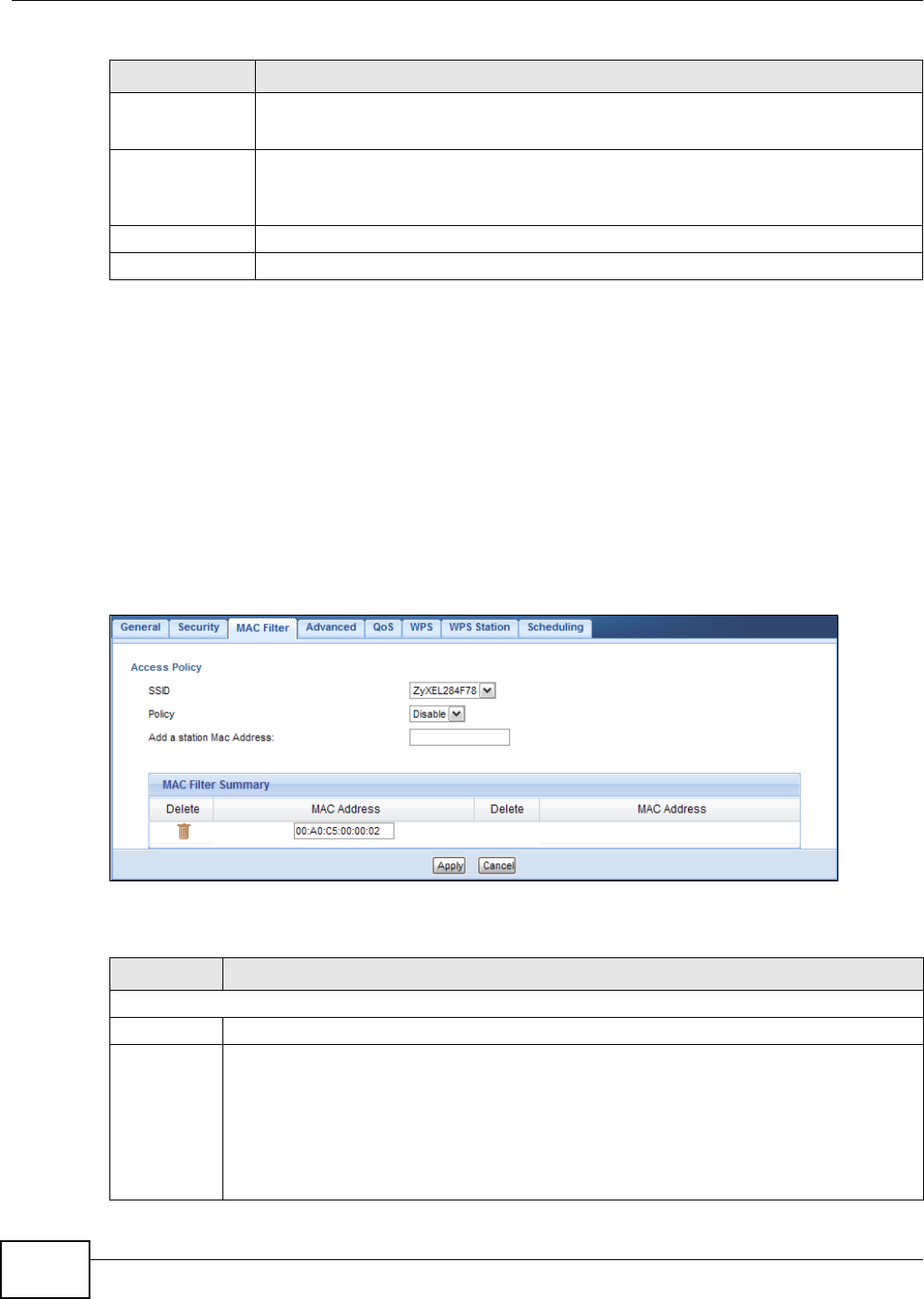
Chapter 9 Wireless LAN
WAP5605 User’s Guide
82
9.6 MAC Filter
The MAC filter screen allows you to configure the WAP5605 to give exclusive access to devices
(Allow) or exclude devices from accessing the WAP5605 (Deny). Every Ethernet device has a
unique MAC (Media Access Control) address. The MAC address is assigned at the factory and
consists of six pairs of hexadecimal characters, for example, 00:A0:C5:00:00:02. You need to know
the MAC address of the devices to configure this screen.
To change your WAP5605’s MAC filter settings, click Network > Wireless LAN > MAC Filter. The
screen appears as shown.
Figure 47 Network > Wireless LAN > MAC Filter
The following table describes the labels in this menu.
Pre-Shared Key WPA-PSK/WPA2-PSK uses a simple common password for authentication.
Type a pre-shared key from 8 to 63 case-sensitive keyboard characters.
Group Key
Update Timer
The Group Key Update Timer is the rate at which the AP sends a new group key out to
all clients.
The default is 3600 seconds (60 minutes).
Apply Click Apply to save your changes back to the WAP5605.
Cancel Click Cancel to reload the previous configuration for this screen.
Table 30 Network > Wireless LAN > Security: WPA-PSK/WPA2-PSK
LABEL DESCRIPTION
Table 31 Network > Wireless LAN > MAC Filter
LABEL DESCRIPTION
Access Policy
SSID Select the SSID for which you want to configure MAC filtering.
Policy Define the filter action for the list of MAC addresses in the MAC Address table.
Select Disable to deactivate the MAC filtering rule you configure below.
Select Allow to permit access to the WAP5605, MAC addresses not listed will be denied access
to the WAP5605.
Select Reject to block access to the WAP5605, MAC addresses not listed will be allowed to
access the WAP5605
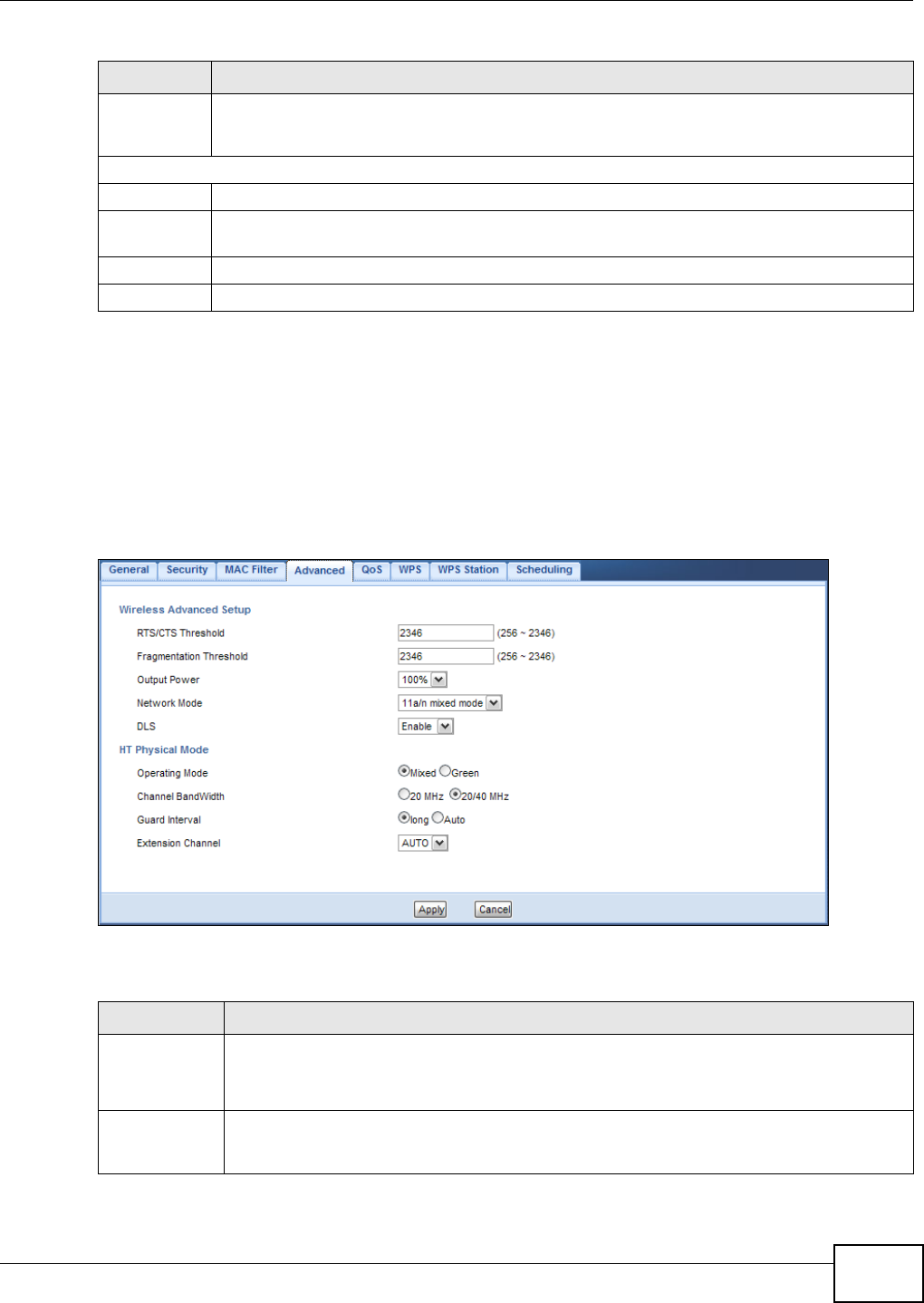
Chapter 9 Wireless LAN
WAP5605 User’s Guide 83
9.7 Wireless LAN Advanced Screen
Use this screen to allow wireless advanced features, such as the output power, RTS/CTS Threshold
and high-throughput physical mode settings.
Click Network > Wireless LAN > Advanced. The screen appears as shown.
Figure 48 Network > Wireless LAN > Advanced
The following table describes the labels in this screen.
Add a station
Mac Address
Enter the MAC addresses of the wireless station that are allowed or denied access to the
WAP5605 in these address fields. Enter the MAC addresses in a valid MAC address format, that
is, six hexadecimal character pairs, for example, 12:34:56:78:9a:bc.
MAC Filter Summary
Delete Click the delete icon to remove the MAC address from the list.
MAC Address This is the MAC address of the wireless station that are allowed or denied access to the
WAP5605.
Apply Click Apply to save your changes back to the WAP5605.
Cancel Click Cancel to reload the previous configuration for this screen.
Table 31 Network > Wireless LAN > MAC Filter
LABEL DESCRIPTION
Table 32 Network > Wireless LAN > Advanced
LABEL DESCRIPTION
RTS/CTS
Threshold
Data with its frame size larger than this value will perform the RTS (Request To Send)/CTS
(Clear To Send) handshake.
Enter a value between 256 and 2346.
Fragmentation
Threshold
The threshold (number of bytes) for the fragmentation boundary for directed messages. It is
the maximum data fragment size that can be sent. Enter an even number between 256 and
2346.

Chapter 9 Wireless LAN
WAP5605 User’s Guide
84
9.8 Quality of Service (QoS) Screen
The QoS screen allows you to automatically give a service (such as VoIP and video) a priority level.
Click Network > Wireless LAN > QoS. The following screen appears.
Figure 49 Network > Wireless LAN > QoS
Output Power Set the output power of the WAP5605 in this field. If there is a high density of APs in an
area, decrease the output power of the WAP5605 to reduce interference with other APs.
Select one of the following 100%, 90%, 75%, 50%, 25% or 10%. See the product
specifications for more information on your WAP5605’s output power.
Network Mode This displays 11 a/n mixed mode and only IEEE802.11a or IEEE802.11n compliant WLAN
devices can associate with the WAP5605.
DLS Select Enabled to activate IEEE 802.11e Direct Link Setup (DLS) on the WAP5605. This
allows all wireless clients that support DLS and are in the same wireless network (BSS) to
communicate with each other directly. Traffic within the BSS can be sent from one client to
another without going through the access point (WAP5605).
HT (High Throughput) Physical Mode - Use the fields below to configure the 802.11 wireless environment of
your WAP5605.
Operating
Mode
Choose this according to the wireless mode(s) used in your network.
Mixed - Select this if the wireless clients in your network use different wireless modes (for
example, IEEE 802.11a and IEEE 802.1n modes).
Green - Select this if the wireless clients in your network uses only one type of wireless
mode (for example, IEEEE 802.11 n only).
Channel
Bandwidth
Select the channel bandwidth you want to use for your wireless network.
It is recommended that you select 20/40 MHz.
Select 20 MHz if you want to lessen radio interference with other wireless devices in your
neighborhood.
Guard Interval Select Auto to increase data throughput. However, this may make data transfer more prone
to errors.
Select Long to prioritize data integrity. This may be because your wireless network is busy
and congested or the WAP5605 is located in an environment prone to radio interference.
Extension
Channel
This is set to Auto by default.
If you select 20/40 MHz as your Channel Bandwidth, the extension channel enables the
WAP5605 to get higher data throughput. This also lowers radio interference and traffic.
Apply Click Apply to save your changes back to the WAP5605.
Cancel Click Cancel to reload the previous configuration for this screen.
Table 32 Network > Wireless LAN > Advanced
LABEL DESCRIPTION
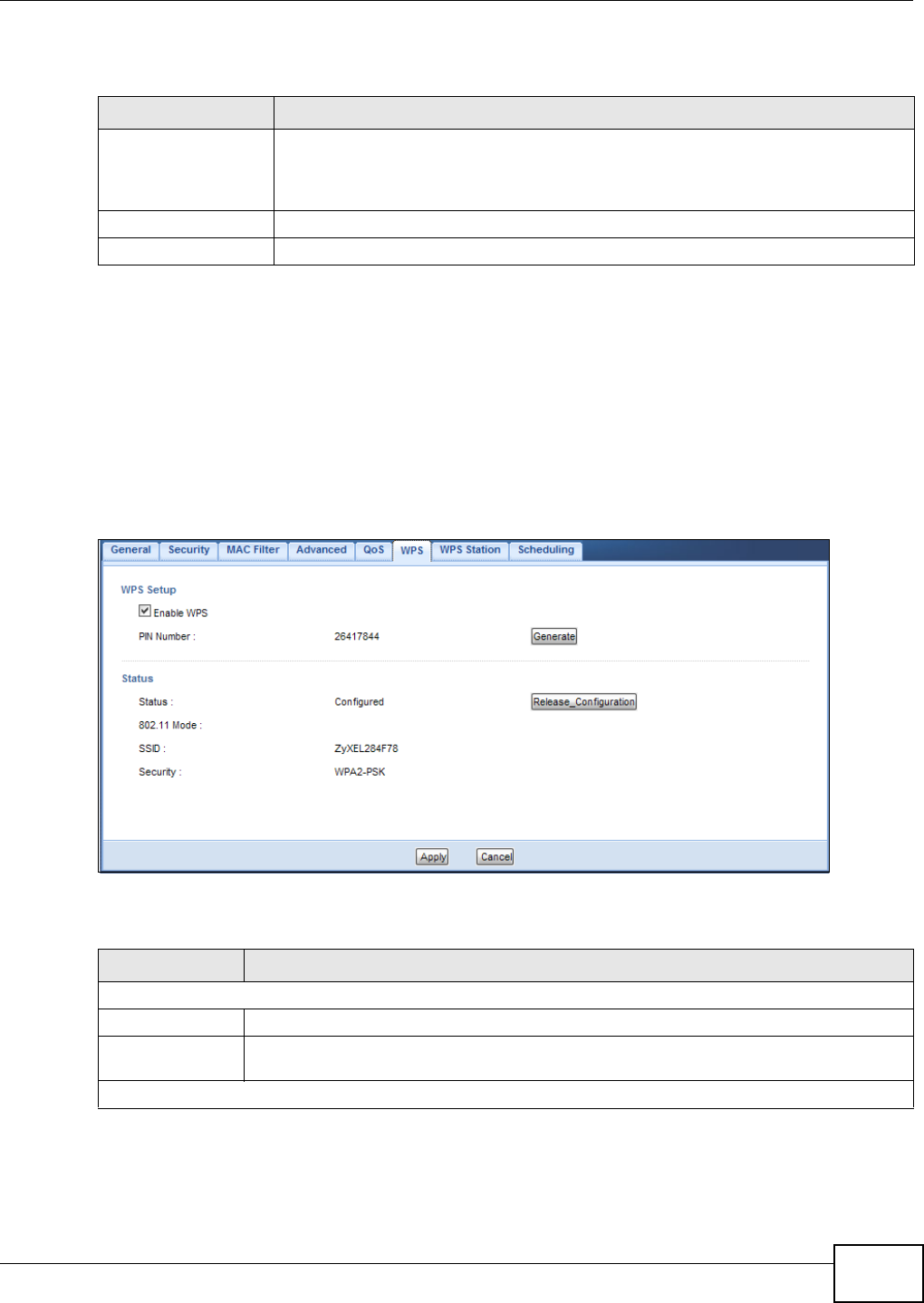
Chapter 9 Wireless LAN
WAP5605 User’s Guide 85
The following table describes the labels in this screen.
9.9 WPS Screen
Use this screen to enable/disable WPS, view or generate a new PIN number and check current WPS
status. To open this screen, click Network > Wireless LAN > WPS tab.
Note: With WPS, wireless clients can only connect to the wireless network using the first
SSID on the WAP5605.
Figure 50 Network > Wireless LAN > WPS
The following table describes the labels in this screen.
Table 33 Network > Wireless LAN > QoS
LABEL DESCRIPTION
Enable WMM QoS Check this to have the WAP5605 automatically give a service a priority level according
to the ToS value in the IP header of packets it sends. WMM QoS (Wifi MultiMedia
Quality of Service) gives high priority to voice and video, which makes them run more
smoothly.
Apply Click Apply to save your changes to the WAP5605.
Cancel Click Cancel to reload the previous configuration for this screen.
Table 34 Network > Wireless LAN > WPS
LABEL DESCRIPTION
WPS Setup
Enable WPS Select this to enable the WPS feature.
PIN Number This displays a PIN number last time system generated. Click Generate to generate a
new PIN number.
Status
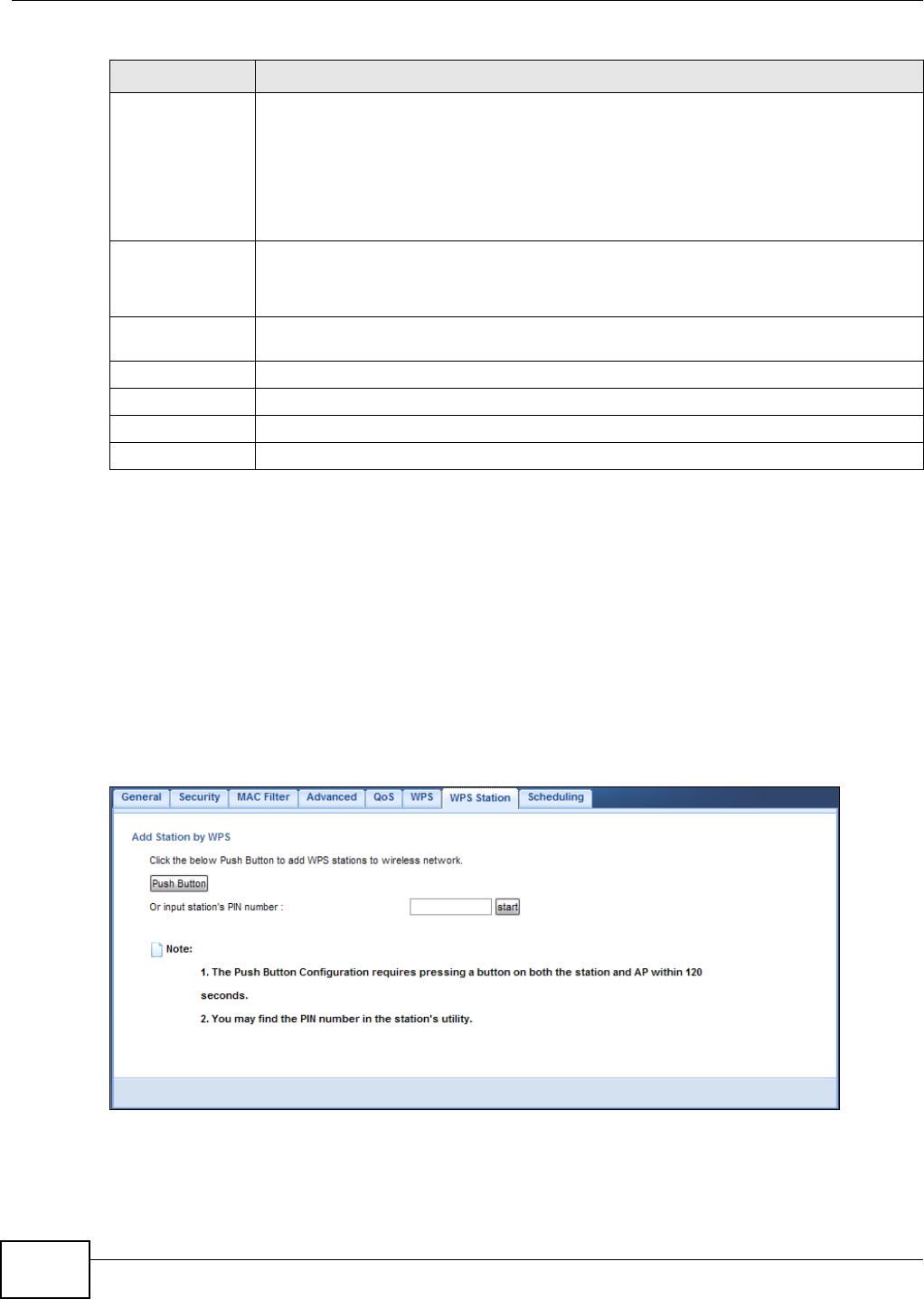
Chapter 9 Wireless LAN
WAP5605 User’s Guide
86
9.10 WPS Station Screen
Use this screen when you want to add a wireless station using WPS. To open this screen, click
Network > Wireless LAN > WPS Station tab.
Note: After you click Push Button on this screen, you have to press a similar button in
the wireless station utility within 2 minutes. To add the second wireless station, you
have to press these buttons on both device and the wireless station again after the
first 2 minutes.
Figure 51 Network > Wireless LAN > WPS Station
Status This displays Configured when the WAP5605 has connected to a wireless network using
WPS or when Enable WPS is selected and wireless or wireless security settings have
been changed. The current wireless and wireless security settings also appear in the
screen.
This displays Unconfigured if WPS is disabled and there are no wireless or wireless
security changes on the WAP5605 or you click Release_Configuration to remove the
configured wireless and wireless security settings.
Release
Configuration
This button is only available when the WPS status displays Configured.
Click this button to remove all configured wireless and wireless security settings for WPS
connections on the WAP5605.
802.11 Mode This is the 802.11 mode used. Only compliant WLAN devices can associate with the
WAP5605.
SSID This is the name of the wireless network (the WAP5605’s first SSID).
Security This is the type of wireless security employed by the network.
Apply Click Apply to save your changes back to the WAP5605.
Cancel Click Cancel to reload the previous configuration for this screen.
Table 34 Network > Wireless LAN > WPS
LABEL DESCRIPTION
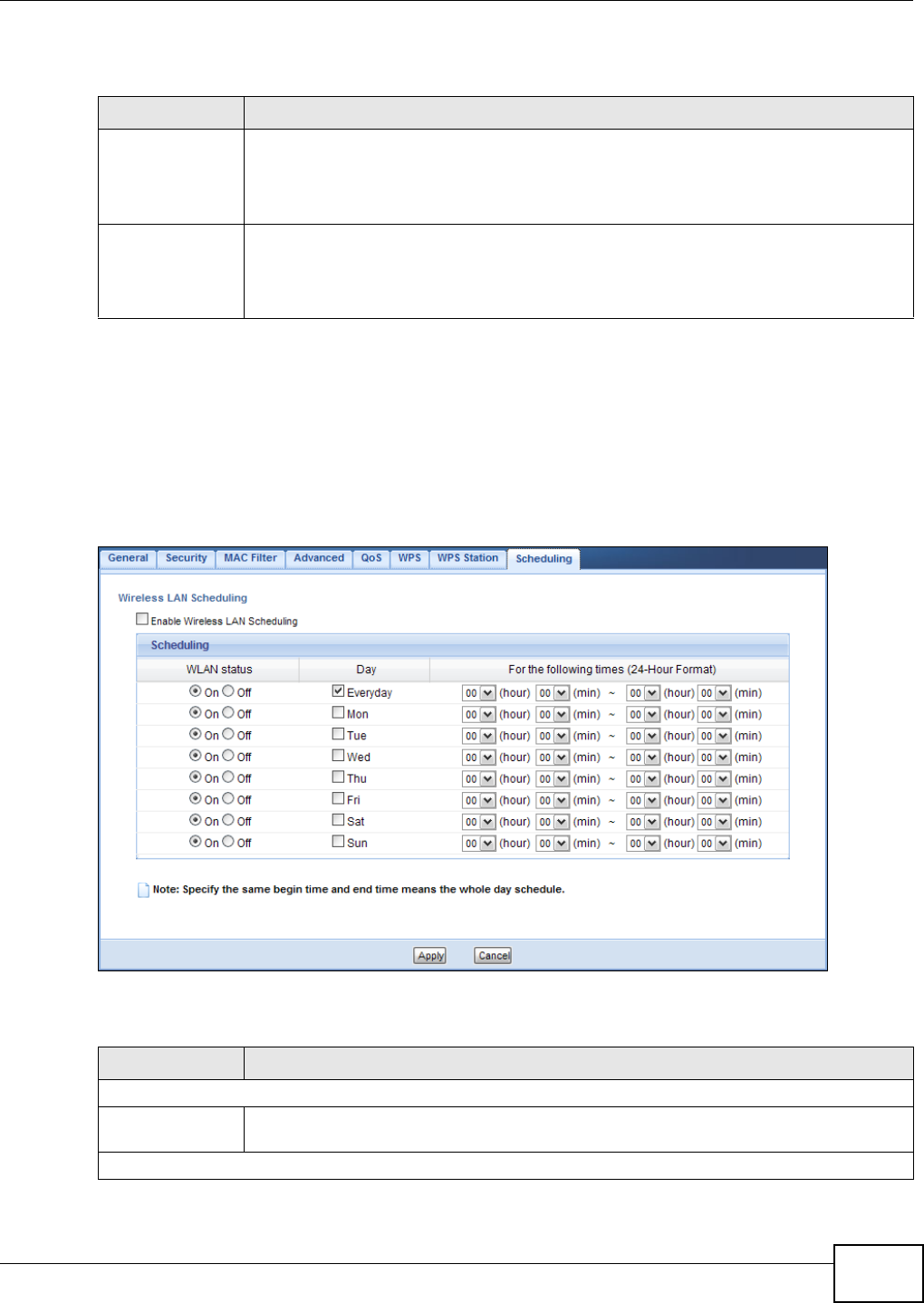
Chapter 9 Wireless LAN
WAP5605 User’s Guide 87
The following table describes the labels in this screen.
9.11 Scheduling Screen
Use this screen to set the times your wireless LAN is turned on and off. Wireless LAN scheduling is
disabled by default. The wireless LAN can be scheduled to turn on or off on certain days and at
certain times. To open this screen, click Network > Wireless LAN > Scheduling tab.
Figure 52 Network > Wireless LAN > Scheduling
The following table describes the labels in this screen.
Table 35 Network > Wireless LAN > WPS Station
LABEL DESCRIPTION
Push Button Use this button when you use the PBC (Push Button Configuration) method to configure
wireless stations’s wireless settings. See Section 7.3.1 on page 56.
Click this to start WPS-aware wireless station scanning and the wireless security
information synchronization.
Or input station’s
PIN number
Use this button when you use the PIN Configuration method to configure wireless station’s
wireless settings. See Section 7.3.2 on page 57.
Type the same PIN number generated in the wireless station’s utility. Then click Start to
associate to each other and perform the wireless security information synchronization.
Table 36 Network > Wireless LAN > Scheduling
LABEL DESCRIPTION
Wireless LAN Scheduling
Enable Wireless
LAN Scheduling
Select this to enable Wireless LAN scheduling.
Scheduling

Chapter 9 Wireless LAN
WAP5605 User’s Guide
88
WLAN Status Select On or Off to specify whether the Wireless LAN is turned on or off. This field works
in conjunction with the Day and For the following times fields.
Day Select Everyday or the specific days to turn the Wireless LAN on or off. If you select
Everyday you can not select any specific days. This field works in conjunction with the
For the following times field.
For the following
times (24-Hour
Format)
Select a begin time using the first set of hour and minute (min) drop down boxes and
select an end time using the second set of hour and minute (min) drop down boxes. If
you have chosen On earlier for the WLAN Status the Wireless LAN will turn on between
the two times you enter in these fields. If you have chosen Off earlier for the WLAN
Status the Wireless LAN will turn off between the two times you enter in these fields.
Apply Click Apply to save your changes back to the WAP5605.
Cancel Click Cancel to reload the previous configuration for this screen.
Table 36 Network > Wireless LAN > Scheduling
LABEL DESCRIPTION
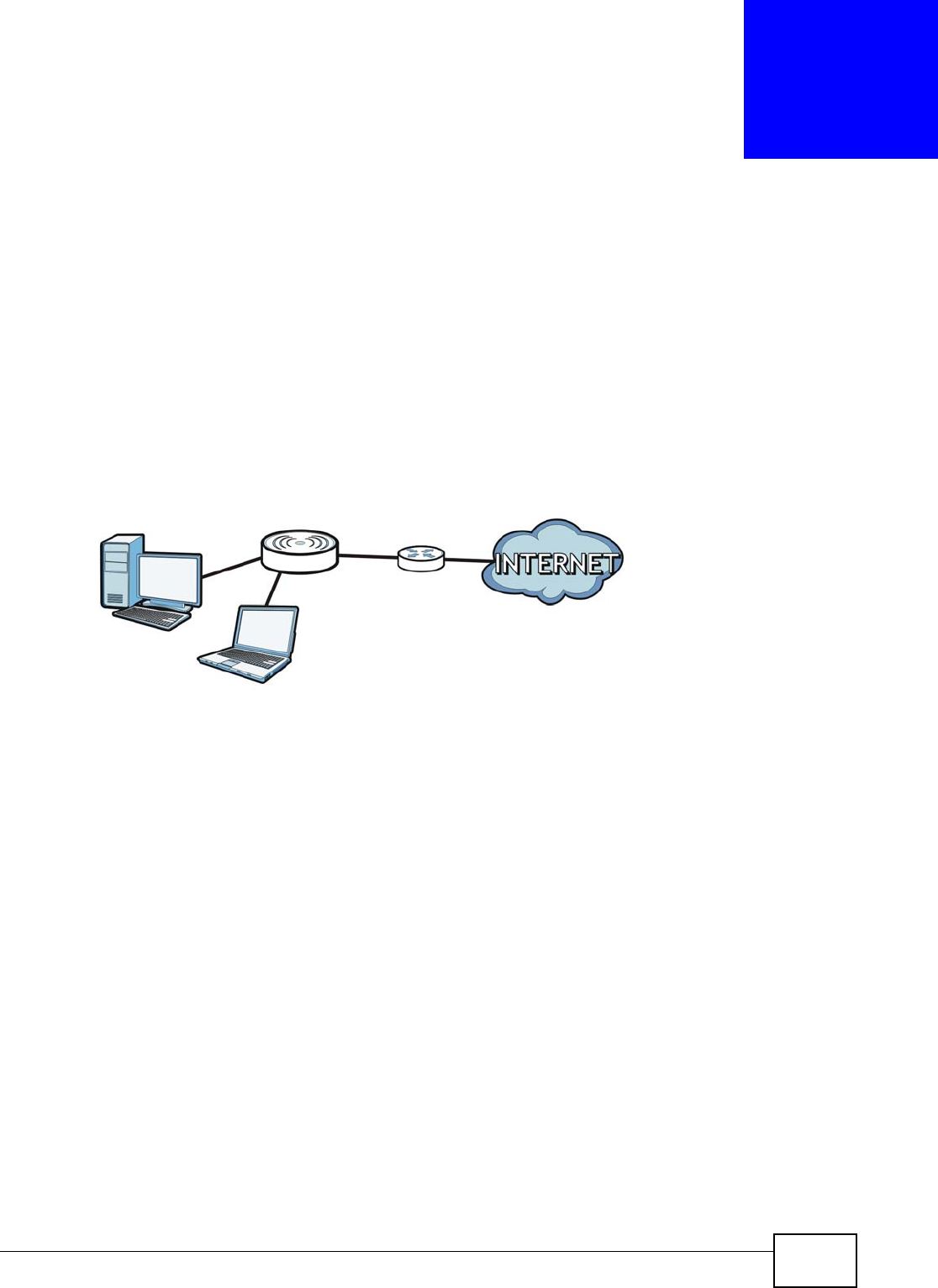
WAP5605 User’s Guide 89
CHAPTER 10
LAN
10.1 Overview
This chapter describes how to configure LAN settings.
A Local Area Network (LAN) is a shared communication system to which many computers are
attached. A LAN is a computer network limited to the immediate area, usually the same building or
floor of a building. The LAN screens can help you configure a LAN DHCP server, manage IP
addresses, and partition your physical network into logical networks.
Figure 53 LAN Example
The LAN screens can help you manage IP addresses.
10.2 What You Can Do
•Use the IP screen (Section 10.4 on page 91) to change the IP address for your WAP5605 and
DNS server information.
•Use the IP Alias screen (Section 10.5 on page 92) to have the WAP5605 apply IP alias to create
LAN subnets.
LAN
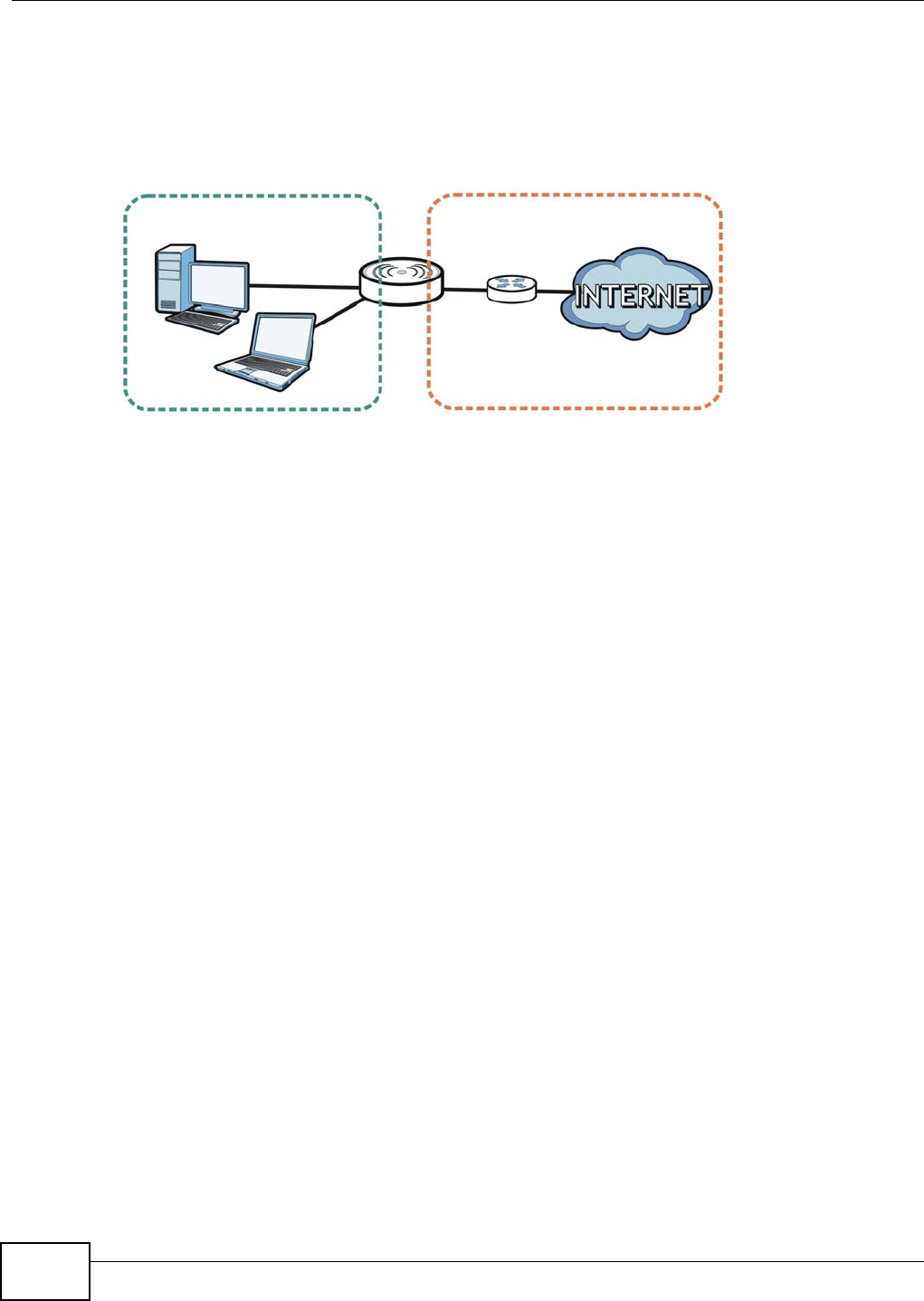
Chapter 10 LAN
WAP5605 User’s Guide
90
10.3 What You Need To Know
There are two separate IP networks, one inside the LAN network and the other outside the WAN
network as shown next.
Figure 54 LAN and WAN IP Addresses
The LAN parameters of the WAP5605 are preset in the factory with the following values:
• AP mode: IP address of 192.168.1.2 with subnet mask of 255.255.255.0 (24 bits)
• Client mode: IP address of 192.168.1.10 with subnet mask of 255.255.255.0 (24 bits)
10.3.1 LAN TCP/IP
The WAP5605 has built-in DHCP server capability that assigns IP addresses and DNS servers to
systems that support DHCP client capability.
10.3.2 IP Alias
IP alias allows you to partition a physical network into different logical networks over the same
Ethernet interface. The WAP5605 supports three logical LAN interfaces via its single physical
Ethernet interface with the WAP5605 itself as the gateway for each LAN network.
WAN
LAN
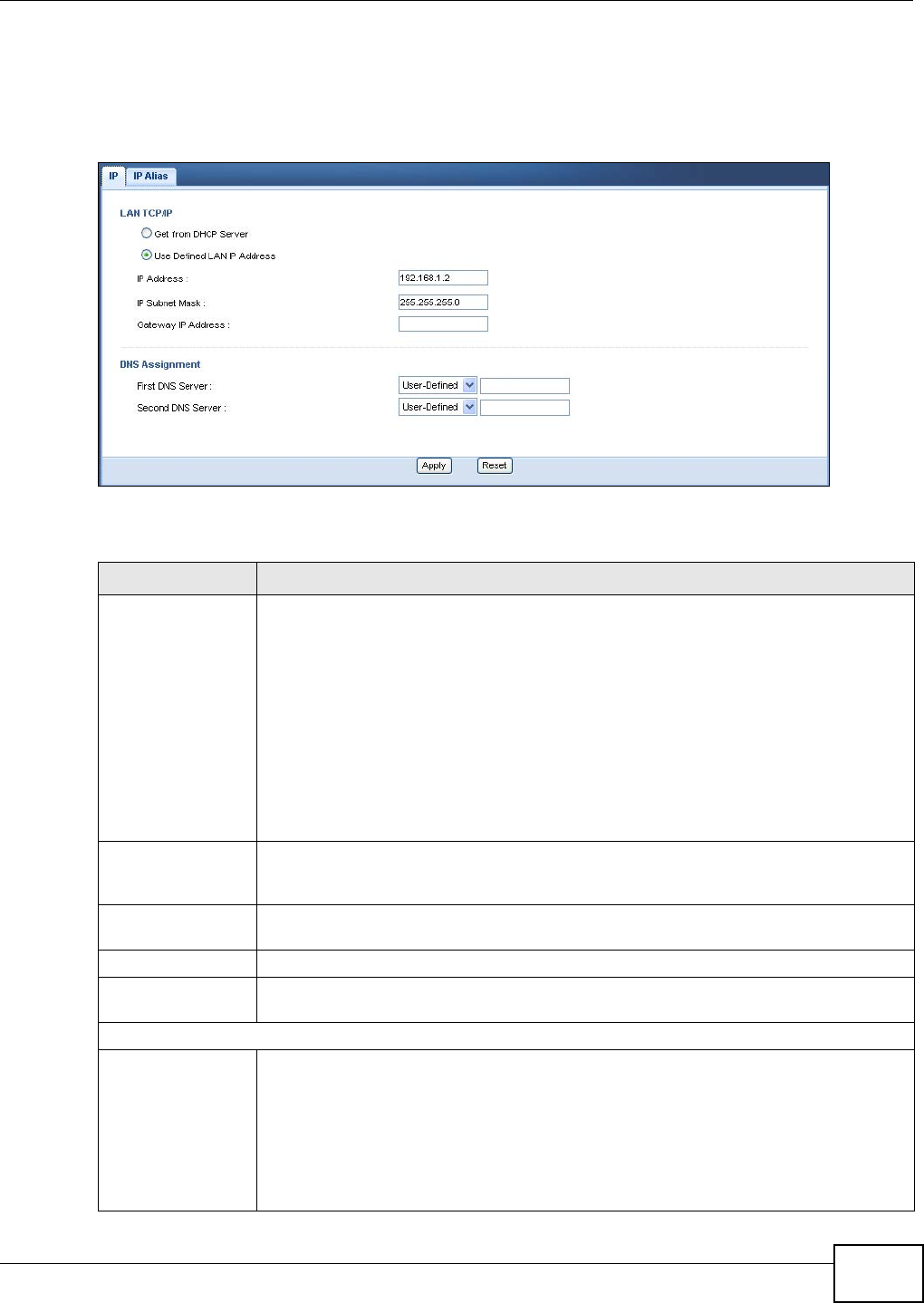
Chapter 10 LAN
WAP5605 User’s Guide 91
10.4 LAN IP Screen
Use this screen to change the IP address for your WAP5605. Click Network > LAN > IP.
Figure 55 Network > LAN > IP
The following table describes the labels in this screen.
Table 37 Network > LAN > IP
LABEL DESCRIPTION
Get from DHCP
Server
Click this to deploy the WAP5605 as a DHCP client in the network.
When you enable this, the WAP5605 gets its IP address from the network’s DHCP server
(for example, your ISP or router). Users connected to the WAP5605 in AP mode can now
access the network (i.e., the Internet if the IP address is given by the ISP or a router
with Internet access).
The Web Configurator may no longer be accessible unless you know the IP address
assigned by the DHCP server to the WAP5605. Otherwise, you need to reset the
WAP5605 to be able to access the Web Configurator again (see Section 11.7 on page 98
for details on how to reset the WAP5605).
Also when you select this, you cannot enter an IP address for your WAP5605 in the field
below.
Use Defined LAN IP
Address
Click this if you want to specify the IP address of your WAP5605. Or if your ISP or
network administrator gave you a static IP address to access the network or the
Internet.
IP Address Type the IP address in dotted decimal notation. If you change the IP address you will
have to log in again with the new IP address.
IP Subnet Mask The subnet mask specifies the network number portion of an IP address.
Gateway IP
Address
Enter a gateway IP address (if your ISP or network administrator gave you one) in this
field.
DNS Assignment
First DNS Server
Second DNS Server
Select From ISP if your ISP or router to which the WAP5605 connects dynamically
assigns DNS server information (and the WAP5605's WAN IP address). The field to the
right displays the (read-only) DNS server IP address that the ISP assigns.
Select User-Defined if you have the IP address of a DNS server. Enter the DNS server's
IP address in the field to the right.
Select None if you do not want to configure DNS servers. If you do not configure a DNS
server, you must know the IP address of a computer in order to access it.
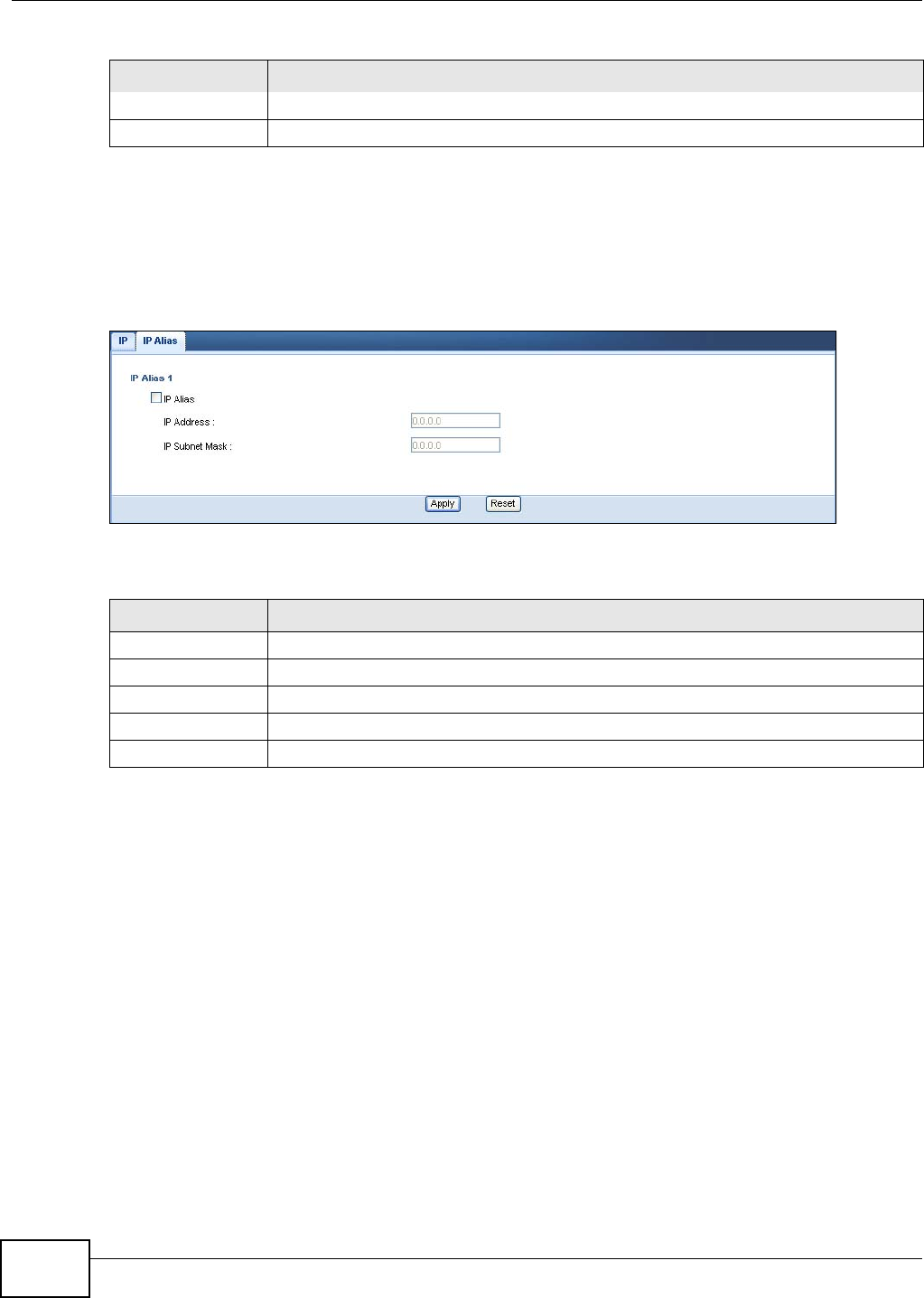
Chapter 10 LAN
WAP5605 User’s Guide
92
10.5 IP Alias Screen
Use this screen to have the WAP5605 apply IP alias to create LAN subnets. Click LAN > IP Alias.
Figure 56 Network > LAN > IP Alias
The following table describes the labels in this screen.
Apply Click Apply to save your changes back to the WAP5605.
Reset Click Reset to begin configuring this screen afresh.
Table 37 Network > LAN > IP
LABEL DESCRIPTION
Table 38 Network > LAN > IP Alias
LABEL DESCRIPTION
IP Alias Check this to enable IP alias.
IP Address Type the IP alias address of your WAP5605 in dotted decimal notation.
IP Subnet Mask The subnet mask specifies the network number portion of an IP address.
Apply Click Apply to save your changes back to the WAP5605.
Reset Click Reset to begin configuring this screen afresh.

WAP5605 User’s Guide 93
CHAPTER 11
Maintenance
11.1 Overview
This chapter provides information on the Maintenance screens.
11.2 What You Can Do
•Use the General screen (Section 11.3 on page 93) to set the timeout period of the management
session.
•Use the Password screen (Section 11.4 on page 94) to change your WAP5605’s system
password.
•Use the Time screen (Section 11.5 on page 95) to change your WAP5605’s time and date.
•Use the Firmware Upgrade screen (Section 11.6 on page 96) to upload firmware to your
WAP5605.
•Use the Backup/Restore screen (Section 11.8 on page 99) to view information related to
factory defaults, backup configuration, and restoring configuration.
•Use the Reset/Restart screen (Section 11.8 on page 99) to reboot the WAP5605 without
turning the power off.
11.3 General Screen
Use this screen to set the management session timeout period. Click Maintenance > General.
The following screen displays.
Figure 57 Maintenance > General
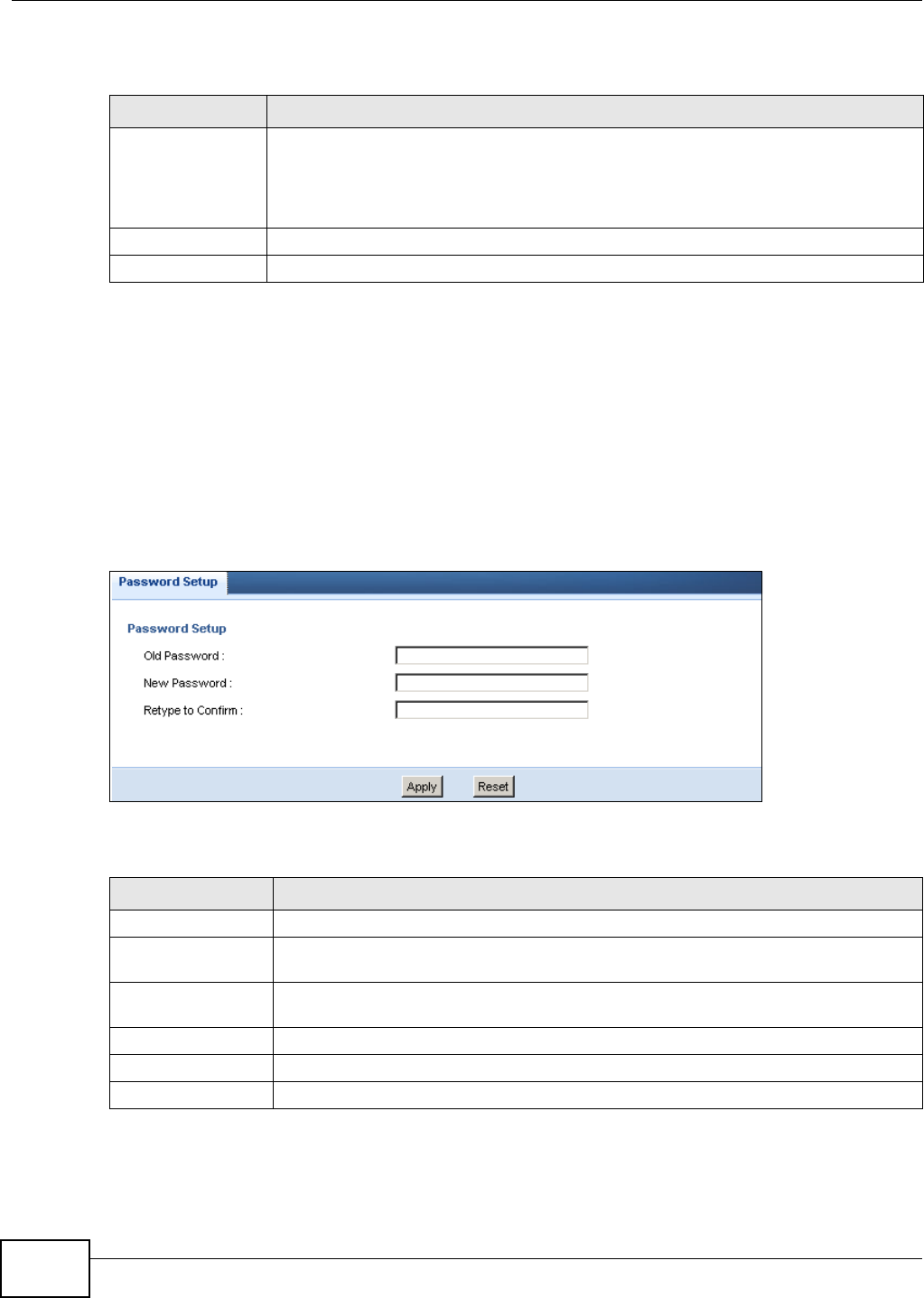
Chapter 11 Maintenance
WAP5605 User’s Guide
94
The following table describes the labels in this screen.
11.4 Password Screen
It is strongly recommended that you change your WAP5605's password.
If you forget your WAP5605's password (or IP address), you will need to reset the device. See
Section 11.8 on page 99 for details
Click Maintenance > Password.
Figure 58 Maintenance > Password
The following table describes the labels in this screen.
Table 39 Maintenance > General
LABEL DESCRIPTION
Administrator
Inactivity Timer
Type how many minutes a management session can be left idle before the session times
out. The default is 5 minutes. After it times out you have to log in with your password
again. Very long idle timeouts may have security risks. A value of "0" means a
management session never times out, no matter how long it has been left idle (not
recommended).
Apply Click Apply to save your changes back to the WAP5605.
Reset Click Reset to begin configuring this screen afresh.
Table 40 Maintenance > Password
LABEL DESCRIPTION
Password Setup Change your WAP5605’s password (recommended) using the fields as shown.
Old Password Type the default password or the existing password you use to access the system in
this field.
New Password Type your new system password (up to 30 characters). Note that as you type a
password, the screen displays an asterisk (*) for each character you type.
Retype to Confirm Type the new password again in this field.
Apply Click Apply to save your changes back to the WAP5605.
Reset Click Reset to begin configuring this screen afresh.
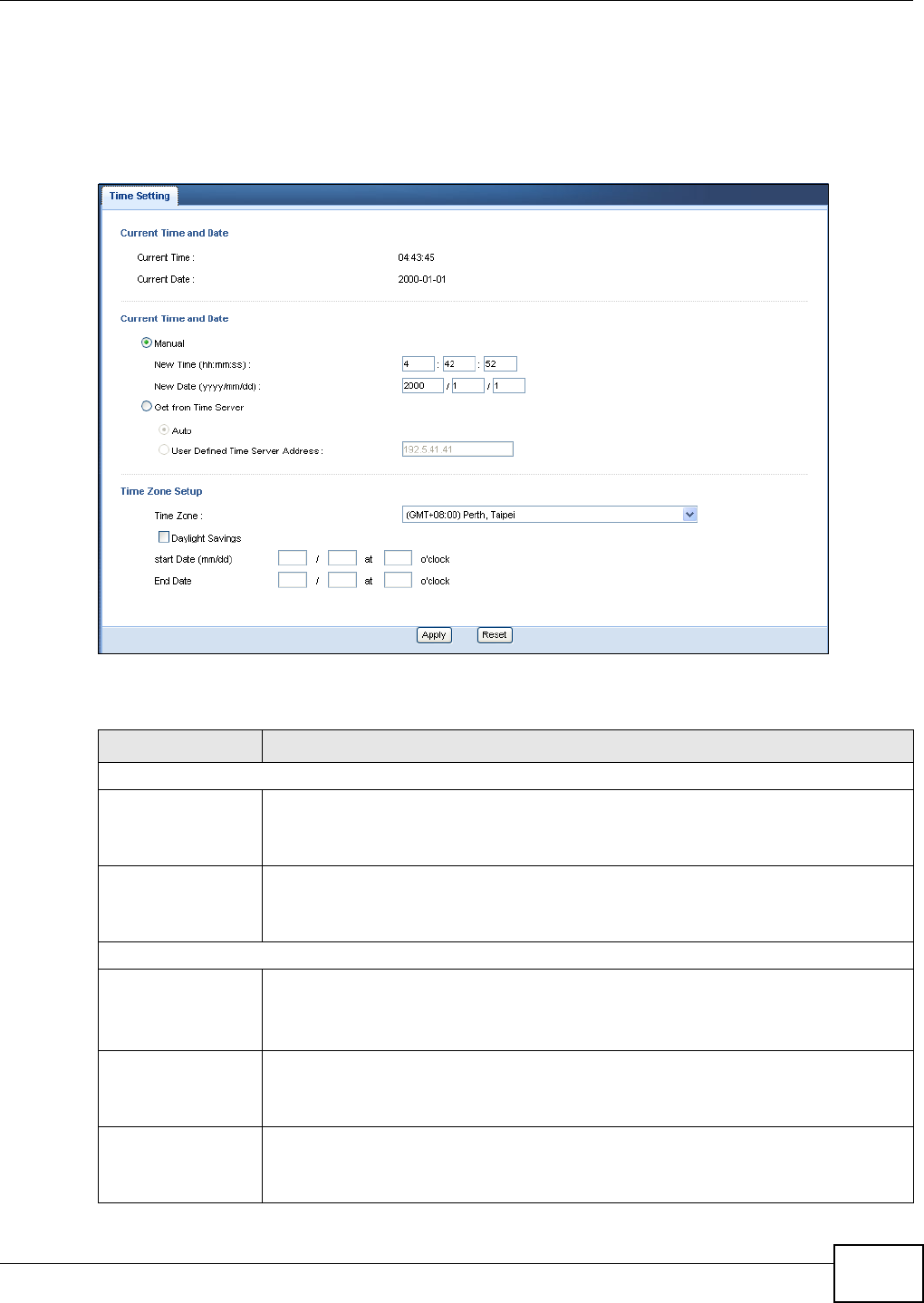
Chapter 11 Maintenance
WAP5605 User’s Guide 95
11.5 Time Setting Screen
Use this screen to configure the WAP5605’s time based on your local time zone. To change your
WAP5605’s time and date, click Maintenance > Time. The screen appears as shown.
Figure 59 Maintenance > Time
he following table describes the labels in this screen.
Table 41 Maintenance > Time
LABEL DESCRIPTION
Current Time and Date
Current Time This field displays the time of your WAP5605.
Each time you reload this page, the WAP5605 synchronizes the time with the time
server.
Current Date This field displays the date of your WAP5605.
Each time you reload this page, the WAP5605 synchronizes the date with the time
server.
Current Time and Date
Manual Select this radio button to enter the time and date manually. If you configure a new
time and date, Time Zone and Daylight Saving at the same time, the new time and date
you entered has priority and the Time Zone and Daylight Saving settings do not affect
it.
New Time
(hh:mm:ss)
This field displays the last updated time from the time server or the last time
configured manually.
When you select Manual, enter the new time in this field and then click Apply.
New Date
(yyyy/mm/dd)
This field displays the last updated date from the time server or the last date configured
manually.
When you select Manual, enter the new date in this field and then click Apply.

Chapter 11 Maintenance
WAP5605 User’s Guide
96
11.6 Firmware Upgrade Screen
Find firmware at www.zyxel.com in a file that (usually) uses the system model name with a “*.bin”
extension, e.g., “WAP5605.bin”. The upload process uses HTTP (Hypertext Transfer Protocol) and
may take up to two minutes. After a successful upload, the system will reboot.
Get from Time
Server
Select this radio button to have the WAP5605 get the time and date from the time
server you specified below.
Auto Select Auto to have the WAP5605 automatically search for an available time server and
synchronize the date and time with the time server after you click Apply.
User Defined Time
Server Address
Select User Defined Time Server Address and enter the IP address or URL (up to 20
extended ASCII characters in length) of your time server. Check with your ISP/network
administrator if you are unsure of this information.
Time Zone Setup
Time Zone Choose the time zone of your location. This will set the time difference between your
time zone and Greenwich Mean Time (GMT).
Daylight Savings Daylight saving is a period from late spring to fall when many countries set their clocks
ahead of normal local time by one hour to give more daytime light in the evening.
Select this option if you use Daylight Saving Time.
Start Date Configure the day and time when Daylight Saving Time starts if you selected Daylight
Savings. The o'clock field uses the 24 hour format. Here are a couple of examples:
Daylight Saving Time starts in most parts of the United States on the second Sunday of
March. Each time zone in the United States starts using Daylight Saving Time at 2 A.M.
local time. So in the United States you would select Second, Sunday, March and type
2 in the o'clock field.
Daylight Saving Time starts in the European Union on the last Sunday of March. All of
the time zones in the European Union start using Daylight Saving Time at the same
moment (1 A.M. GMT or UTC). So in the European Union you would select Last,
Sunday, March. The time you type in the o'clock field depends on your time zone. In
Germany for instance, you would type 2 because Germany's time zone is one hour
ahead of GMT or UTC (GMT+1).
End Date Configure the day and time when Daylight Saving Time ends if you selected Daylight
Savings. The o'clock field uses the 24 hour format. Here are a couple of examples:
Daylight Saving Time ends in the United States on the first Sunday of November. Each
time zone in the United States stops using Daylight Saving Time at 2 A.M. local time.
So in the United States you would select First, Sunday, November and type 2 in the
o'clock field.
Daylight Saving Time ends in the European Union on the last Sunday of October. All of
the time zones in the European Union stop using Daylight Saving Time at the same
moment (1 A.M. GMT or UTC). So in the European Union you would select Last,
Sunday, October. The time you type in the o'clock field depends on your time zone.
In Germany for instance, you would type 2 because Germany's time zone is one hour
ahead of GMT or UTC (GMT+1).
Apply Click Apply to save your changes back to the WAP5605.
Reset Click Reset to begin configuring this screen afresh.
Table 41 Maintenance > Time
LABEL DESCRIPTION
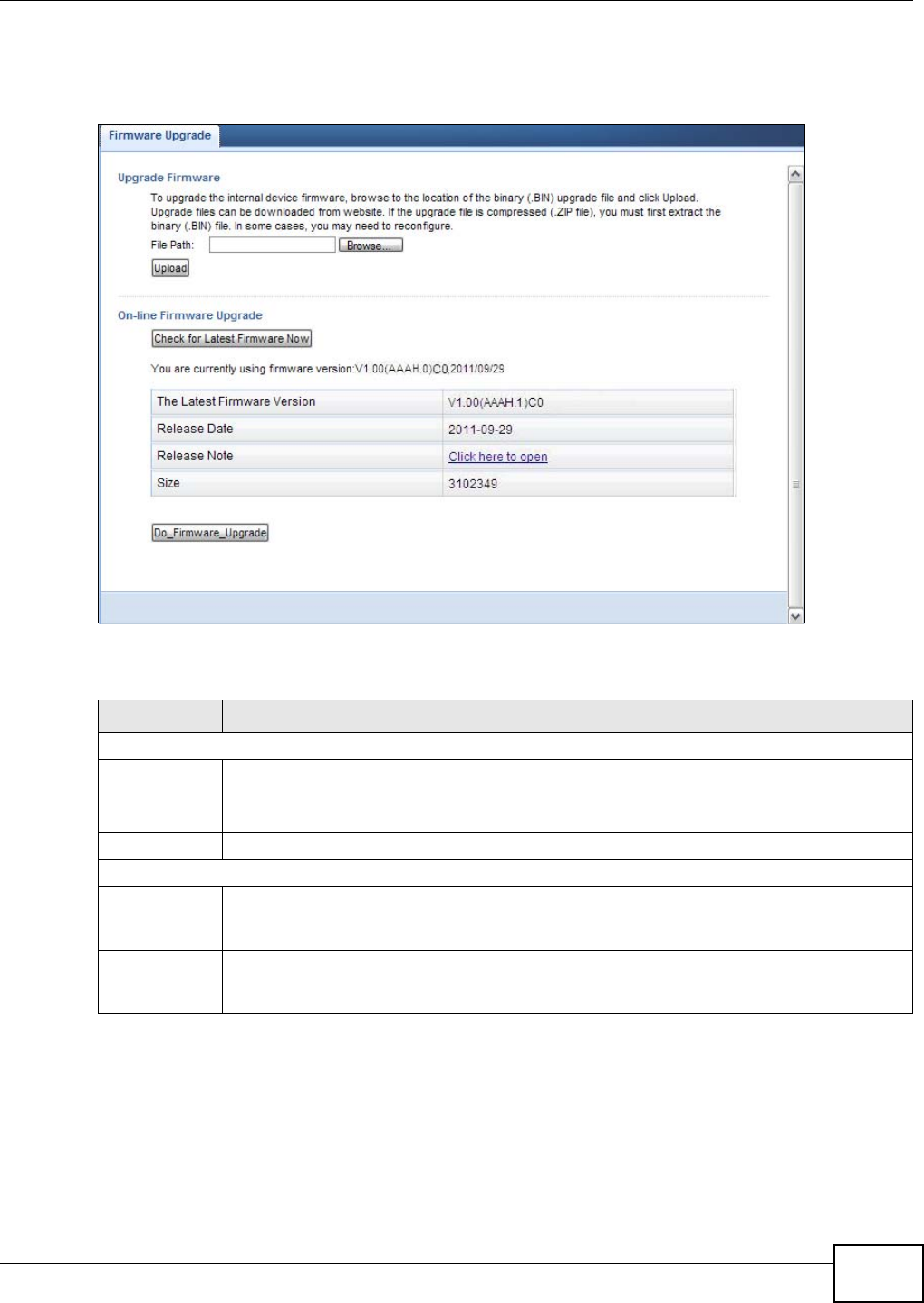
Chapter 11 Maintenance
WAP5605 User’s Guide 97
Click Maintenance > Firmware Upgrade. Follow the instructions in this screen to upload
firmware to your WAP5605.
Figure 60 Maintenance > Firmware Upgrade
The following table describes the labels in this screen.
Note: Do not turn off the WAP5605 while firmware upload is in progress!
After you see the Firmware Upload In Process screen, wait two minutes before logging into the
WAP5605 again.
Table 42 Maintenance > Firmware Upgrade
LABEL DESCRIPTION
Upgrade Firmware
File Path Type in the location of the file you want to upload in this field or click Browse... to find it.
Browse... Click Browse... to find the .bin file you want to upload. Remember that you must
decompress compressed (.zip) files before you can upload them.
Upload Click Upload to begin the upload process. This process may take up to two minutes.
On-line Firmware Upgrade
Check for
Latest
Firmware Now
Click this button to get the latest firmware information, such as the version number, release
date, release note and file size from the ZyXEL website. Make sure your WAP5605 has
Internet access.
Do-
Firmware_Upg
rade
Click this button to download and install the latest firmware in your WAP5605.
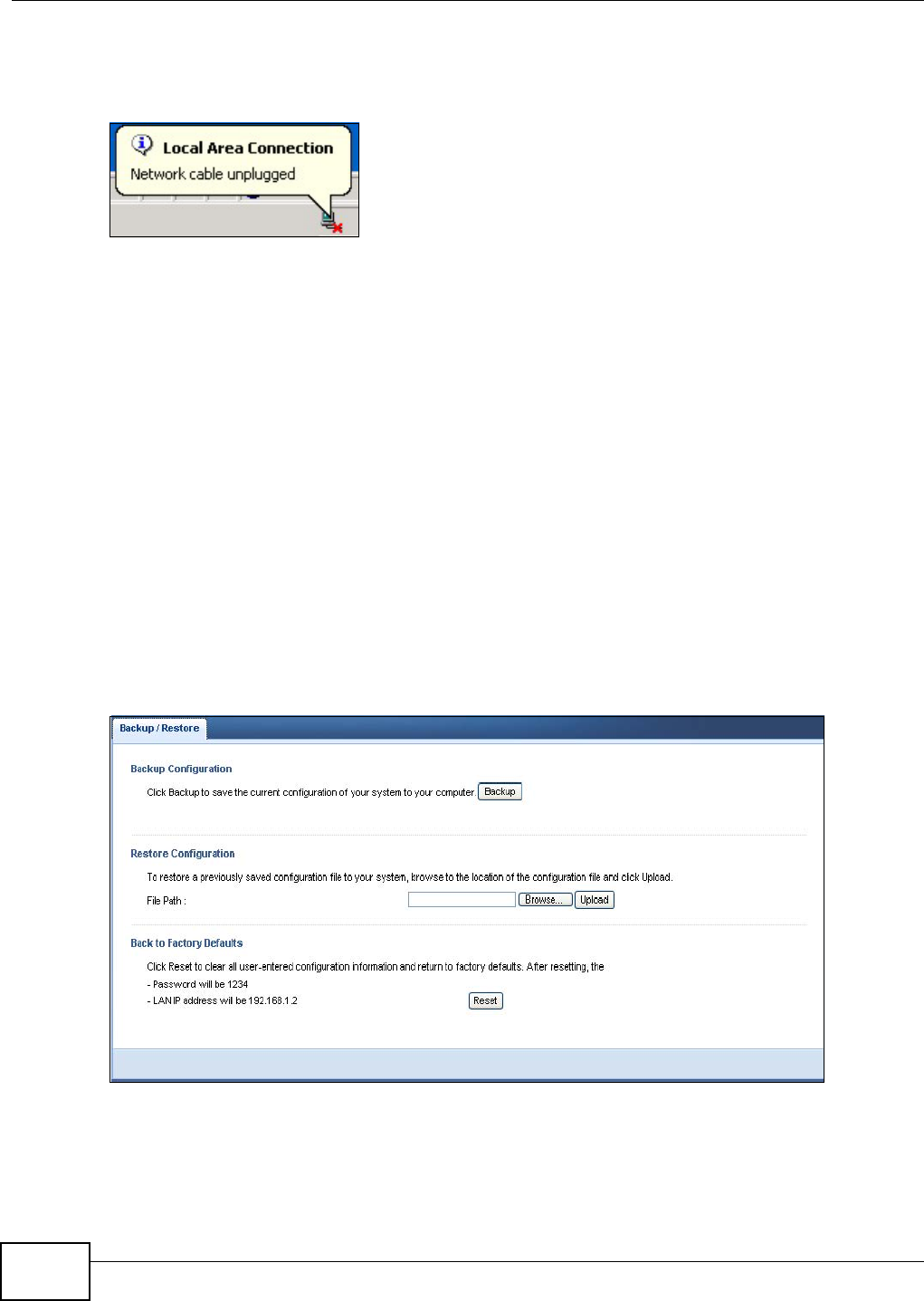
Chapter 11 Maintenance
WAP5605 User’s Guide
98
The WAP5605 automatically restarts in this time causing a temporary network disconnect. In some
operating systems, you may see the following icon on your desktop.
Figure 61 Network Temporarily Disconnected
After two minutes, log in again and check your new firmware version in the Status screen.
If the upload was not successful, an error message appears. Click Return to go back to the
Firmware Upgrade screen.
11.7 Configuration Backup/Restore Screen
Backup configuration allows you to back up (save) the WAP5605’s current configuration to a file on
your computer. Once your WAP5605 is configured and functioning properly, it is highly
recommended that you back up your configuration file before making configuration changes. The
backup configuration file will be useful in case you need to return to your previous settings.
Restore configuration allows you to upload a new or previously saved configuration file from your
computer to your WAP5605.
Click Maintenance > Backup/Restore. Information related to factory defaults, backup
configuration, and restoring configuration appears as shown next.
Figure 62 Maintenance > Backup/Restore
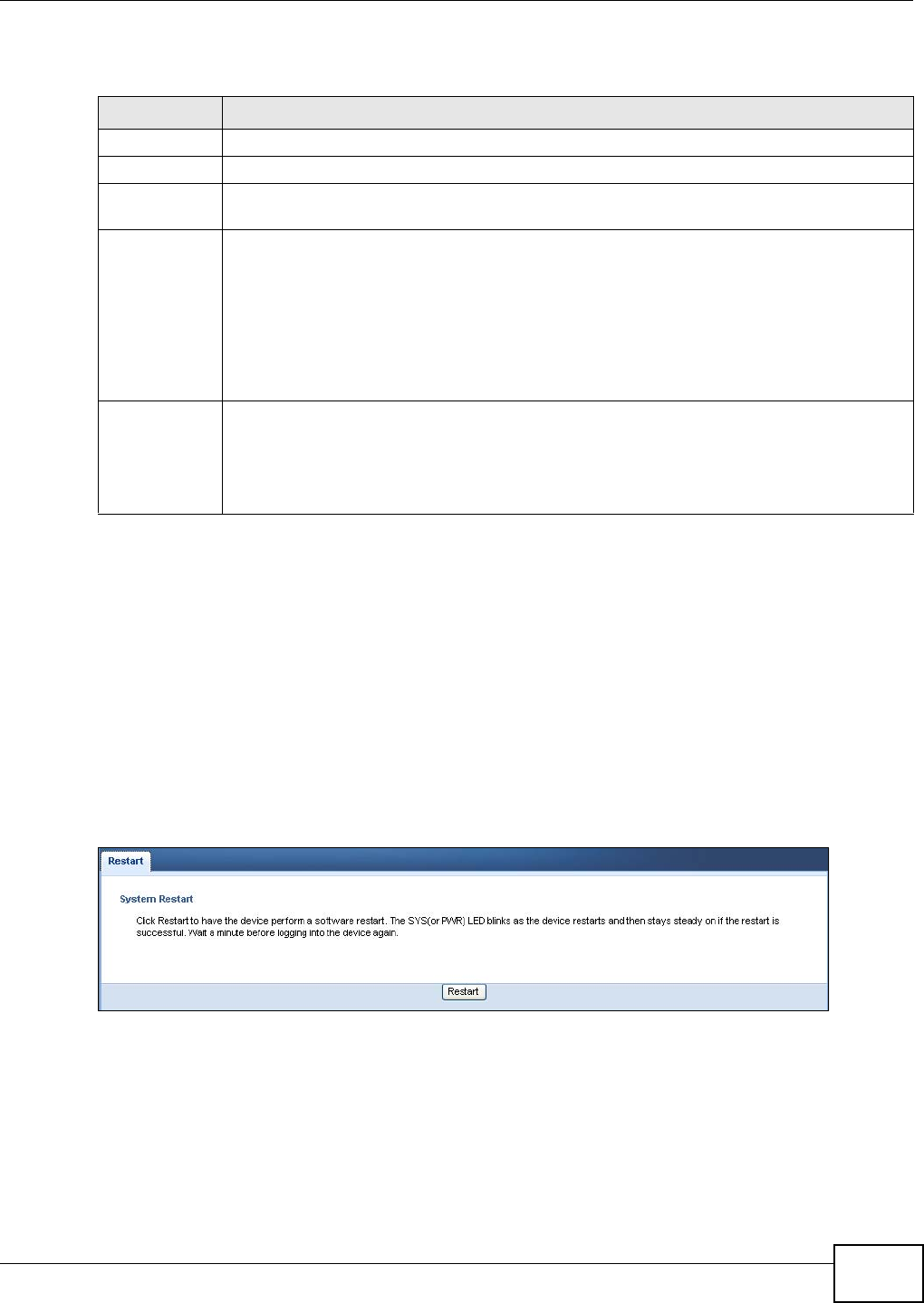
Chapter 11 Maintenance
WAP5605 User’s Guide 99
The following table describes the labels in this screen.
Note: If you uploaded the default configuration file you may need to change the IP
address of your computer to be in the same subnet as that of the default WAP5605
IP address. See Appendix C on page 135 for details on how to set up your
computer’s IP address.
11.8 Reset/Restart Screen
System restart allows you to reboot the WAP5605 without turning the power off.
Click Maintenance > Reset/Restart to open the following screen.
Figure 63 Maintenance > Reset/Restart
Click Restart to have the WAP5605 reboot. This does not affect the WAP5605's configuration.
Table 43 Maintenance > Backup/Restore
LABEL DESCRIPTION
Backup Click Backup to save the WAP5605’s current configuration to your computer.
File Path Type in the location of the file you want to upload in this field or click Browse... to find it.
Browse... Click Browse... to find the file you want to upload. Remember that you must decompress
compressed (.ZIP) files before you can upload them.
Upload Click Upload to begin the upload process.
Note: Do not turn off the WAP5605 while configuration file upload is in progress.
After you see a “configuration upload successful” screen, you must then wait one minute
before logging into the WAP5605 again. The WAP5605 automatically restarts in this time
causing a temporary network disconnect.
If you see an error screen, click Back to return to the Backup/Restore screen.
Reset Pressing the Reset button in this section clears all user-entered configuration information
and returns the WAP5605 to its factory defaults.
You can also press the RESET button on the rear panel to reset the factory defaults of your
WAP5605. Refer to the chapter about introducing the Web Configurator for more information
on the RESET button.

Chapter 11 Maintenance
WAP5605 User’s Guide
100

WAP5605 User’s Guide 101
CHAPTER 12
Troubleshooting
This chapter offers some suggestions to solve problems you might encounter. The potential
problems are divided into the following categories.
•Power, Hardware Connections, and LEDs
•WAP5605 Access and Login
•Internet Access
•Resetting the WAP5605 to Its Factory Defaults
12.1 Power, Hardware Connections, and LEDs
The WAP5605 does not turn on. None of the LEDs turn on.
1Make sure you are using the power adaptor or cord included with the WAP5605.
2Make sure the power adaptor or cord is connected to the WAP5605 and plugged in to an
appropriate power source. Make sure the power source is turned on.
3Disconnect and re-connect the power adaptor or cord to the WAP5605.
4If the problem continues, contact the vendor.
One of the LEDs does not behave as expected.
1Make sure you understand the normal behavior of the LED. See Section 1.6 on page 17.
2Check the hardware connections. See the Quick Start Guide.
3Inspect your cables for damage. Contact the vendor to replace any damaged cables.
4Disconnect and re-connect the power adaptor to the WAP5605.
5If the problem continues, contact the vendor.

Chapter 12 Troubleshooting
WAP5605 User’s Guide
102
12.2 WAP5605 Access and Login
I don’t know the IP address of my WAP5605.
1The default IP address of the WAP5605 in access point mode is 192.168.1.2 and the default IP
address of the WAP5605 in client mode is 192.168.1.10.
2If you changed the IP address and have forgotten it,
• and your WAP5605 is a DHCP client, you can find your IP address from the DHCP server. This
information is only available from the DHCP server which allocates IP addresses on your network.
Find this information directly from the DHCP server or contact your system administrator for
more information.
• reset your WAP5605 to change all settings back to their default. This means your current settings
are lost. See Section 12.4 on page 104 in the Troubleshooting for information on resetting your
WAP5605.
I forgot the password.
1The default password is 1234.
2If this does not work, you have to reset the device to its factory defaults. See Section 12.4 on page
104.
I cannot see or access the Login screen in the Web Configurator.
1Make sure you are using the correct IP address.
• The default IP address of the WAP5605 in access point mode is 192.168.1.2 and the default
IP address of the WAP5605 in client mode is 192.168.1.10.
• If you changed the IP address (Section 10.4 on page 91), use the new IP address.
• If you changed the IP address and have forgotten it, see the troubleshooting suggestions for I
don’t know the IP address of my WAP5605.
2Check the hardware connections, and make sure the LEDs are behaving as expected. See the Quick
Start Guide.
3Make sure your Internet browser does not block pop-up windows and has JavaScripts and Java
enabled. See Appendix A on page 113.
4Make sure your computer is in the same subnet as the WAP5605. (If you know that there are
routers between your computer and the WAP5605, skip this step.)
• If there is a DHCP server on your network, make sure your computer is using a dynamic IP
address. See Section 10.4 on page 91.

Chapter 12 Troubleshooting
WAP5605 User’s Guide 103
• If there is no DHCP server on your network, make sure your computer’s IP address is in the
same subnet as the WAP5605. See Appendix B on page 125.
5Reset the device to its factory defaults, and try to access the WAP5605 with the default IP address.
See Section 11.7 on page 98.
6If the problem continues, contact the network administrator or vendor, or try one of the advanced
suggestions.
Advanced Suggestion
• If your computer is connected wirelessly, use a computer that is connected to a LAN port.
I can see the Login screen, but I cannot log in to the WAP5605.
1Make sure you have entered the password correctly. The default password is 1234. This field is
case-sensitive, so make sure [Caps Lock] is not on.
2This can happen when you fail to log out properly from your last session. Try logging in again after
5 minutes.
3Disconnect and re-connect the power adaptor or cord to the WAP5605.
4If this does not work, you have to reset the device to its factory defaults. See Section 12.4 on page
104.
12.3 Internet Access
I cannot access the Internet.
1Check the hardware connections, and make sure the LEDs are behaving as expected. See the Quick
Start Guide.
2Make sure the WAP5605 in access point mode is connected to a broadband modem or router with
Internet access. Connect to another WAP5605 in client mode to access the Internet through the
WAP5605 in access point mode. Use the switch on the WAP5605’s side panel to change your system
operating mode setting (see Section 2.1.2.1 on page 21). Make sure the client is within the
transmission range of the AP.
3If you are trying to access the Internet wirelessly, make sure the wireless settings in the wireless
client are the same as the settings in the AP.
4Disconnect all the cables from your device, and follow the directions in the Quick Start Guide again.
5If the problem continues, contact your ISP.

Chapter 12 Troubleshooting
WAP5605 User’s Guide
104
I cannot access the Internet anymore. I had access to the Internet (with the WAP5605), but
my Internet connection is not available anymore.
1Check the hardware connections, and make sure the LEDs are behaving as expected. See the Quick
Start Guide and Section 1.6 on page 17.
2Reboot the WAP5605.
3If the problem continues, contact your ISP.
The Internet connection is slow or intermittent.
1There might be a lot of traffic on the network. Look at the LEDs, and check Section 1.6 on page 17.
If the WAP5605 is sending or receiving a lot of information, try closing some programs that use the
Internet, especially peer-to-peer applications.
2Check the signal strength. If the signal strength is low, try moving the clients closer to the AP if
possible, and look around to see if there are any devices that might be interfering with the wireless
network (for example, microwaves, other wireless networks, and so on).
3Reboot the WAP5605.
4If the problem continues, contact the network administrator or vendor, or try one of the advanced
suggestions.
Advanced Suggestions
• Check the settings for QoS. If it is disabled, you might consider activating it.
12.4 Resetting the WAP5605 to Its Factory Defaults
If you reset the WAP5605, you lose all of the changes you have made. The WAP5605 re-loads its
default settings, and the password resets to 1234. You have to make all of your changes again.
You will lose all of your changes when you push the RESET button.
To reset the WAP5605,
1Make sure the power LED is on.
2Press the RESET button for longer than 1 second to restart/reboot the WAP5605.

Chapter 12 Troubleshooting
WAP5605 User’s Guide 105
3Press the RESET button for longer than five seconds to set the WAP5605 back to its factory-default
configurations.
If the WAP5605 restarts automatically, wait for the WAP5605 to finish restarting, and log in to the
Web Configurator. The password is “1234”.
If the WAP5605 does not restart automatically, disconnect and reconnect the WAP5605’s power.
Then, follow the directions above again.

Chapter 12 Troubleshooting
WAP5605 User’s Guide
106

WAP5605 User’s Guide 107
CHAPTER 13
Product Specifications
The following tables summarize the WAP5605’s hardware and firmware features.
Table 44 Hardware Features
Dimensions (W x H x D) 109.96 mm x 155.8 mm x 30.7 mm
Weight 245 g
Power Specification Input: 100~240 V AC, 50~60 Hz
Output: 12 V DC 1A
Two Ethernet ports Auto-negotiating: 10 Mbps, 100 Mbps in either half-duplex or full-duplex
mode.
Auto-crossover: Use either crossover or straight-through Ethernet cables.
Reset Button The reset button is built into the rear panel. Use this button to restore the
WAP5605 to its factory default settings. Press for 1 second to restart the
device. Press for 5 seconds to restore to factory default settings.
WPS button Press the WPS on two WPS enabled devices within 120 seconds for a
security-enabled wireless connection.
Antennas The WAP5605 is equipped with four 3dBi (5 GHz) internal antennas to
provide clear radio transmission and reception on the wireless network.
Operation Environment Temperature: 0º C ~ 40º C / 32ºF ~ 104ºF
Humidity: 20% ~ 90%
Storage Environment Temperature: -30º C ~ 70º C / -22ºF ~ 158ºF
Humidity: 20% ~ 95%
Screw size for wall-
mounting
M4*0.7 mm
Table 45 Firmware Features
FEATURE DESCRIPTION
Default IP Address AP mode: 192.168.1.2
Client mode: 192.168.1.10
Default Subnet Mask 255.255.255.0 (24 bits)
Default Password 1234
Wireless Interface Wireless LAN
Default Wireless SSID ZyXEL+(the last six characters of the WAP5605’s MAC address)
Device Management Use the Web Configurator to easily configure the rich range of features
on the WAP5605.

Chapter 13 Product Specifications
WAP5605 User’s Guide
108
Wireless Functionality Allows IEEE 802.11a and/or IEEE 802.11n wireless clients to connect
to the WAP5605 wirelessly. Enable wireless security (WPA(2)-PSK) and/
or MAC filtering to protect your wireless network.
Note: The WAP5605 may be prone to RF (Radio Frequency)
interference from other 5 GHz devices such as microwave ovens,
wireless phones, Bluetooth enabled devices, and other wireless
LANs.
Firmware Upgrade Download new firmware (when available) from the ZyXEL web site and
use the Web Configurator to put it on the WAP5605.
Note: Only upload firmware for your specific model!
Configuration Backup &
Restoration
Make a copy of the WAP5605’s configuration and put it back on the
WAP5605 later if you decide you want to revert back to an earlier
configuration.
Wireless LAN Scheduler You can schedule the times the wireless LAN is enabled/disabled.
Time and Date Get the current time and date from an external server when you turn
on your WAP5605. You can also set the time manually. These dates and
times are then used in logs.
IP Multicast IP Multicast is used to send traffic to a specific group of computers. The
WAP5605 supports versions 1 and 2 of IGMP (Internet Group
Management Protocol) used to join multicast groups (see RFC 2236).
Logging Use logs for troubleshooting. You can view logs in the Web
Configurator.
Table 45 Firmware Features
FEATURE DESCRIPTION
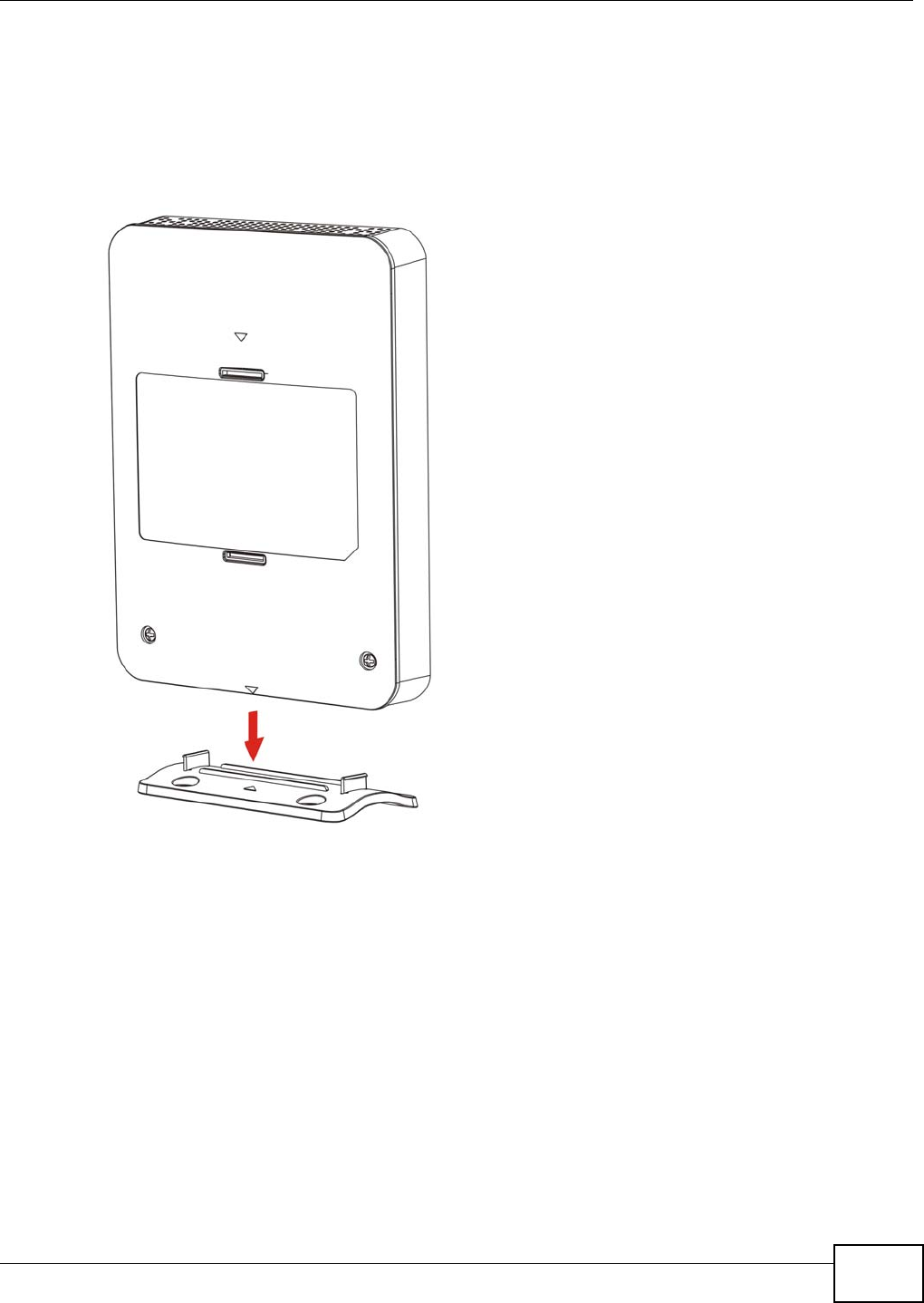
Chapter 13 Product Specifications
WAP5605 User’s Guide 109
13.1 Desktop Installation
Either place the WAP5605 flat on a desk or table or use the stand for a vertical installation. To
attach the stand, line up the arrow on the stand with the arrow on the bottom of the WAP5605 as
shown. Press gently but firmly until the WAP5605 clicks into place.
Figure 64 Stand Installation Example
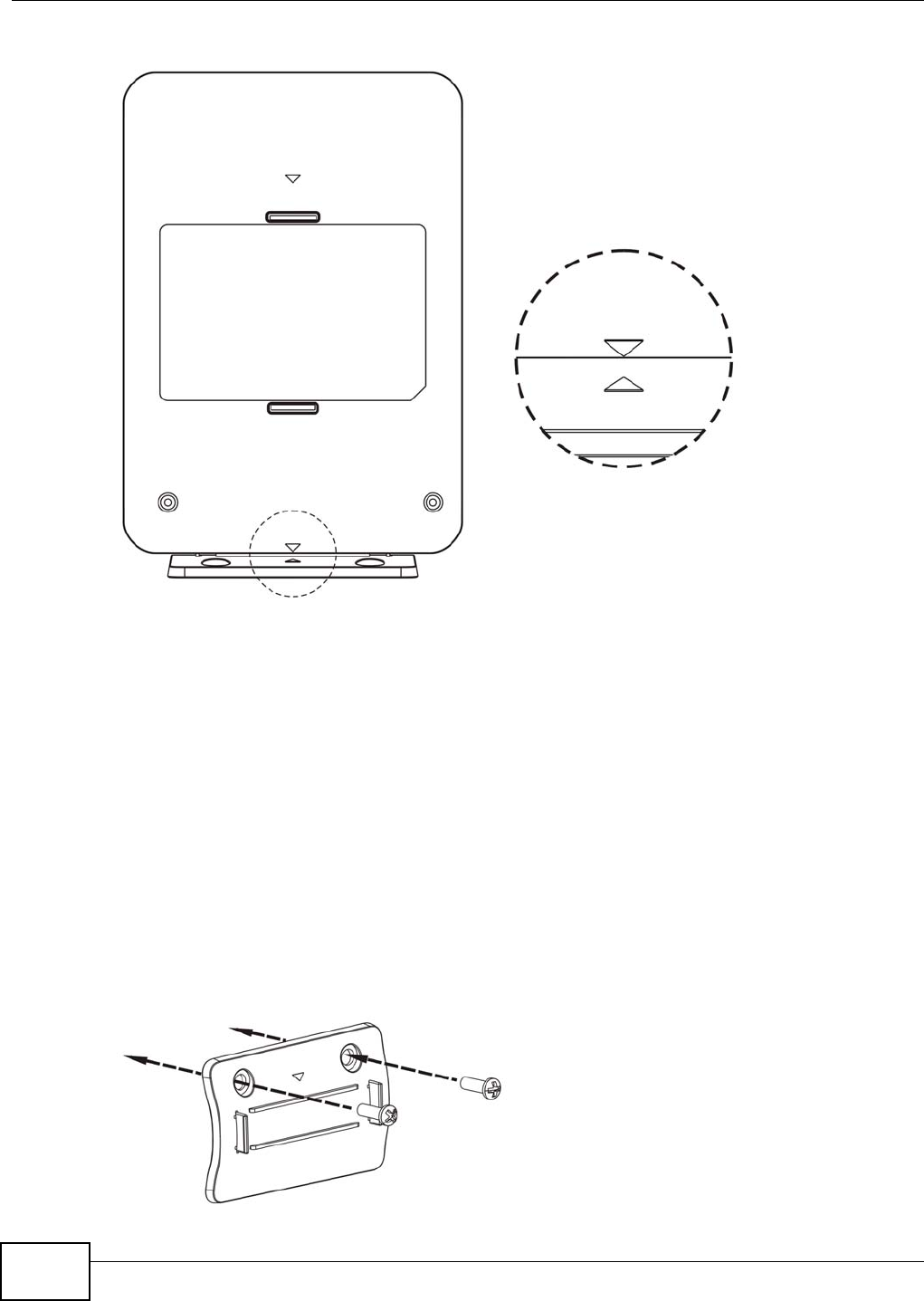
Chapter 13 Product Specifications
WAP5605 User’s Guide
110
Figure 65 Arrows on the Stand and WAP5605
13.2 Wall-mounting Instructions
Complete the following steps to hang your WAP5605 on a wall.
1Select a position free of obstructions on a sturdy wall.
2Install the stand on the wall. Make sure the screw holes of the stand are on the top and screws are
snugly fastened to the wall. The stand needs to hold the weight of the WAP5605 with the
connection cables.
Be careful to avoid damaging pipes or cables located inside the wall
when installing the stand.
Figure 66 Installing the Stand
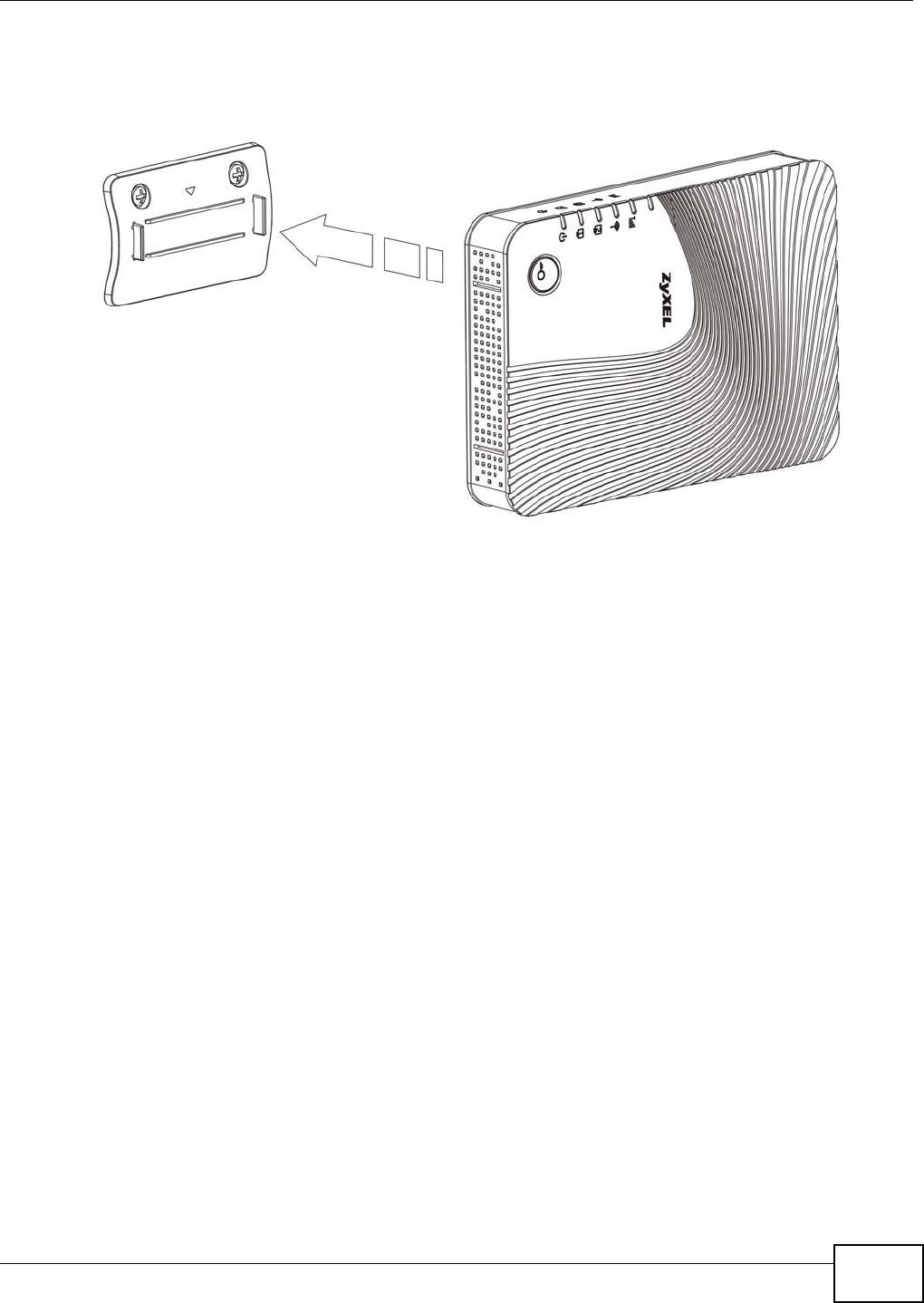
Chapter 13 Product Specifications
WAP5605 User’s Guide 111
3Hold the WAP5605 with the LEDs facing upward. Align the holes on the back of the WAP5605 with
the tabs on the stand. Attach the WAP5605 to the stand. Press gently but firmly until the WAP5605
clicks into place.
Figure 67 Attaching the WAP5605 to the Stand

Chapter 13 Product Specifications
WAP5605 User’s Guide
112